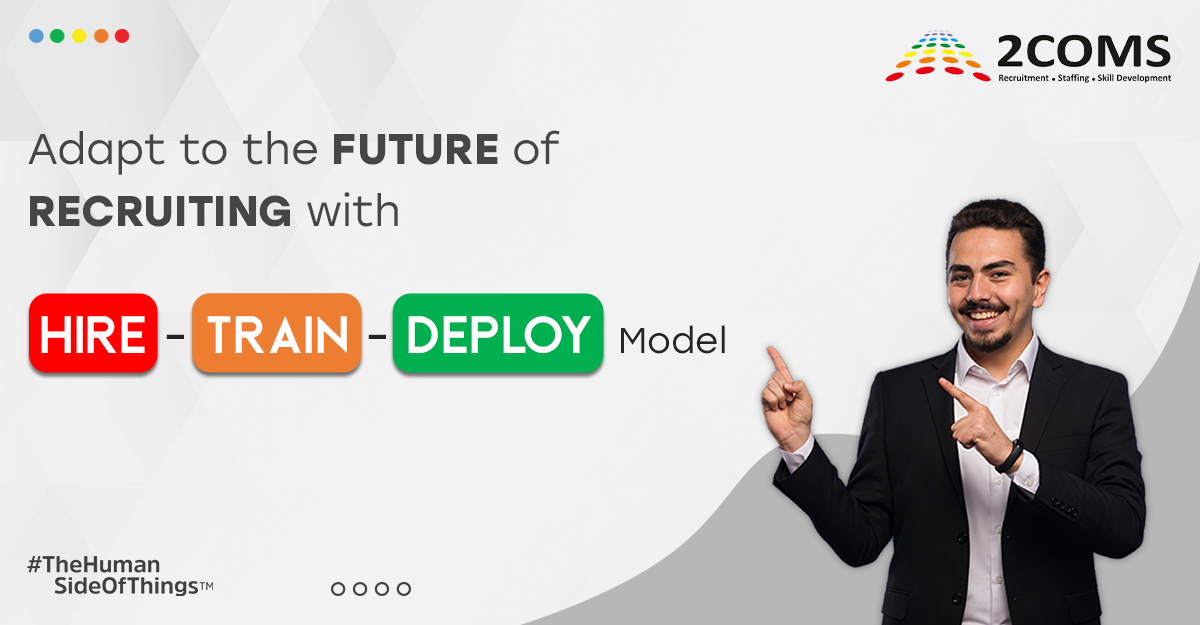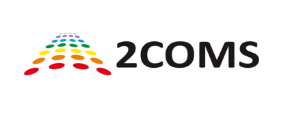How to Adapt to the Future of Recruiting with the Hire-Train-Deploy Model
The HTD Model offers a robust solution to challenges in traditional hiring. A future recruitment trend where specific skill requirements are matched to the perfect candidates.
Recruitment scenarios have dramatically changed in post-pandemic times. Businesses are eager to hire the best talent for filling vacant positions. However, most organizations want to keep recruitment costs to the bare minimum. Attrition is one of the major challenges in hiring process and was at a record high of 14% in 2021. Attrition is making a dent in profitability due to the costs involved in hiring and training. The Hire Train Deploy Model commonly referred to as HTD Model is emerging as the future of recruitment.
Business organizations now hire services of hiring and recruitment firms that offer HTD model. These companies take on the role of hiring the right talent, training them for specific roles for client organizations, and deploying them at client locations. This is proving more effective than traditional hiring methods.
Traditional hiring methods
Traditionally, organizations used to rely on age-old methods to attract and hire talent. Some of these are
- Posting in the classified columns and advertising in recruitment pages of newspapers
- Recruiting through employment bureaus
- Hiring local recruitment agencies to shortlist candidates
- Referrals from existing employees
- Internal job postings for employees to move to other roles
- Approaching colleges for campus recruitment
- Participation in job fairs
These hiring methods were effective in the past. The current scenario poses new challenges in recruitment and selection processes.
Challenges in traditional hiring methods
1. Limited reach
There is a high chance that traditional hiring methods may not even reach the desired prospect. For example, a newspaper advertisement has two disadvantages. They are limited to a geographical barrier. Moreover, there is a strong possibility that the prospective candidate may not notice the advertisement. Candidates who respond may also lack the desired skillsets which call for training costs. A recent survey indicates that 86% of passive job seekers will evaluate the company.
2. Flexibility restrictions
Traditional recruitment methods are restrictive. An advertisement in a newspaper may not contain all requirements due to space restrictions. On the other hand, postings in the digital medium may tend to get lost among other posts which keep piling.
3. Tendency to compare companies
Candidates compare the reputation of the companies in case of similar job postings. They will always tilt towards a company with a higher reputation. At job fairs, the reputed companies attract large crowds while less reputed companies are ignored. Statistics prove that 75% of job seekers are not attracted to companies with lower reputations.
4. Prohibitive cost
All traditional recruitment methods call for a lot of investment. However, the results of the method cannot be predicted in terms of the number of respondents, the quality of skillsets, and the value the hire will bring to the company. Training the candidate is an additional cost that must be considered. If there is attrition, then all the costs of recruiting and training will eat into the profitability.
5. Time-consuming process
The traditional hiring process takes a long time to complete. It starts with information about opening through newspapers, recruitment agencies, etc. Then one waits for responses, sorts through the applications, and calls for tests and interviews. Next comes training and bridging the learning curve. According to a survey, the hiring process excluding training may vary between 36 days to 41 days (about 1 and a half months).
6. Quality issues
After spending months, the traditional recruitment process may not bring quality talent on board. Statistics show that 86% of quality talent is passive and 76% of recruiters agree that hiring qualified candidates is a challenge. In such cases, one cannot start the hiring process all over again due to prohibitive costs.
The HTD model steps in to remove these challenges.
What is the Hire Train Deploy (HTD) Model?
OJho0lQwkmP79tVvVqhQrrcewvL3gWM/gWsu6ubR2wgpZtQuMgLOAbPA2kQqNEFy5Ofnr2/SpPMdUuQGllDnea3qKXL55kjRjtpaVRGvz7Rc7AQ3VpIpSRobQxEcalZYqc6MKSpIcEyf/t/W1103YF7SjDAFHSlpgkNdkaIkhEWV0xZt02UmVsW1uTNzU1+cUQuJIDiKc/4owaF/Myyua0DfE2qhRqBXr2HNdu/e4ca3U/EpwpeOfGK6googoH5+1azMga0ikRw87w1W51BW6TBCcgAIjCw+KkdzXBIcVREd6AWSInLUtCXGZ2+MyJBJjeC/FOkpMrEhRW2Ep6T4ROktMH6O+hreSz+1IzcwgkOZ04+/s6xF1EpNQS9CkVT4W8TKKRplYmU8yMvFqqseqqupYJSNIHCcnKby1FP3N3jwwfHfMQzDkV5D7mV3gX/Hx6Tm1I4ioImApf5gyBg83xA6s2fPu/XBB/+5KVJ6ivpvpay/IaVy2oRI12mUdM60JDeCd0dDyCe/cVwEB887WZ73crLIKBIcEybcVWPSpMfWJP/Qk9dDMzd9sY7y5Zefg/4D+gWbz5gxE954/a1Yu4q7HSU4IkNICY4QNnqbc0pw6F+Kehjq90AtEoGAIAgXa9Ro006K3givoIJvpDgOdTgk/Q3cXMnlYbUV4SnBkYg5SpE+i53kkCqpSBVV5Aoromi7LCwqV1kJUhqi5TLRIf0uR2uEojZCpEdkxKUoDfkoGq0RfJi/lI4iERvhURv4O1ZgwFQU1LyRUlKQ6AhpbshpKZHIDXWKGJ7TQFnYCGVig2PSTVMhraYiilgFh2et1kCwdCySHPjfH38sebJWrZqjSNe06P0bCj7LBdF1krQJtaMIhCHA2MpA5q3bgM2uTYzMmTPnv2/V6sonQ9Ebfvz7JySwekrwtkTsYIoZUoIjqMwspagoCQ5BsKNaM1ehQjnr1q2rdxlhf1NsDSTc3WQgOGTB0bNnz8H11w1L+JijnYASHJTgIFmAeptzSnDoo6iHoX4P1CIRCPh8vt116nS4RlkiNvacYkpwJGKOUqhPIpJDq4Ss31/IyuVj9SI5BAGjNezBNBbcRIuincF/S7ocSFjI0RxIZGApWWXJWCliQ0pfCX4T/EmqwxHS2gjyAcENCaahBH/TIDYkkiMUtRFKUcFUFUuwukokckNLVNRgaop606S1gVLOWZjYKIrEKiNufL6K+HzOKKNtlNVUsKSv3Y5FAXBOpHK+VivPSSlEkthor17dy86Y8fYPFgtHLIQQOLgQXAuuS+f9Xwpd4qnnqrPPB2BtPobYcUEQPP/850uDPvlk1snw6A0kJjnBRK0qkuuT2O9kNkw3giN4v78E+CVWWFLVlm+YHk9lFkuGkQkX+YMs8LFjG1ZZLFzNZJ7IZPYtGQgOxOemm4dC3sV800qwxoo5JTgowUGydvQ255Tg0EdRD0P9HqhFIhAoKChc2ahR17tICA7CknfyJipt30YlYh7SqE+NDTOOLqTJIT8H4qdYUU+urkJKciCZgdG9ouhgpM00Eh0YMSAwoWiOkDaHTGQoU1ckUiOUnhIiPKLPhExmhAgNieiQiQ9lmVgkNlBrIzxqI5SSgp+joK/LJZMdnMhx7mCkVOzkBvqjm5qiHmTUiGs0jlZNRa2bJ72U1BYbRaJj0aKvb27duvkkI2ves2IC+LZON9KE2lIEwNpoGDgHkmvbImT79h18u3v3IdNZVuCLiov6BXWkI8d5BIvFjgLdIk1P0V50pZbgiBbyZrcjsSFFcCDBcfDguq+dTscV9LqNDYFkIThi8z68FUaCnD59Nq6uom26zCxdi74uWrwwLl9JGk+d+m/4+qu5JKa6NspUIi1jMzf1idDgWLxoCUycOFl3nCQGSMg99VTkCtVmYkHiT6w2RkkGM+8XRs8d6xhpO2MInDlzflbLlr2epgSHMdyodVQEIkQFYJszwe+0SA45QkArkkOK2vCzgpAZ/IlkRkaGyPA8EhtIZoRHcyiJDozoUKau4PlDZEfwtyLP30ryQ4rMUB7K1BRZbDT0WTixoUxRQSIECQ9JbwNJDBQolD4LkRuy5saFCxdFdcUUi+WEqCw3iV4Z1N3QmjjVfBUlo5CIkl9Kqp/ZcW4k3Tw/K5f2ReIJq6lIaSoYWROK4ihbNsvy558/fZGZdAdPNgAAIABJREFUmdGc+DoKuKFgVnsQzu8kbkINSzcCbFYtyLx1CzD28sRAeL3eI1dffePQffsOerTERbVKqSMpqUzl1C+lju4ESchSU22s1BEcyNorQ95QXEqZooI3SzXBsXPnz2+WL1/uWuLVSg3DEDBrw2IGuRDP1JgVAaK36TJz47p6zQrMk41n2Lpt77v3QVi79nddOxKDVC8Ta6a+S3HqkZDMTaw2eutd3a9Z9wvs1+i5Yx0jbWcMgaNHj73aocOgd6SwW4tgsfh5WRU+0oObjio8jeAwNgXpaK2bqqIkOZRRHBjVixvoSCQHCtJjCjP+RFIDN9ThKStSFIectqJFdMgEhwR8/CkqchqK1J8csSERG0qtDenfoagNmezAN8D4b9wk4Vtg/C9OcuP/2fsSMCeK9P2q7k4yBwMoh6KugCKnQAaQAWERRDxXRXF3vRU8f96s+nfdFREFXU90FW8UV8Ub8WZVEBWFQWGCshweiCiIwHANMDn6+D9f1xTpdLqT7qQzk2S+PA9MuruquuqtylFv3u/99IEZFlY6NZXjMBVZ7kC50kZRogL73g7EE4SWl+jKDSuzUR6yoqoQsiIKkyaN73rppRe86ibkXNmyjOx+dTAhcn0xvmZwTF4iQEVSdtrHRDpouKtW33rr/XGXXXbzV5QqQEDuzZ7CvDeYD4cTc1EHqdTdvkZdjSPfCiPB4YDgqKn58O8dOux3ab5NXqH0x6sNC/y679Wv45lg99HH75H773sw6xCXdJsuLwmOdIRBJjiY6zRmf728Vy4UHF6SPY2pZvFiHdi1kW69I8GRS/Tzs+3ly1fdcMwxf51lRXBkmPYOCY78nOrG7lVakgNUHNCpVOljgcgAT47WrVtR+AEMyAxObvA0stZqDmuiI05uwHVQcvgz9uDgSg1oh4WhMFKDHQOZkRiOAl4bZtWGIOzWIPsCnOfkBjf0hSwMVp4b0H7cVBSOElJOmjdOVsdWa8EyTAUKug0tB9JJlsGLQxbiZqPxjCrMcFSi1dXvXNOx48GXuFmYsZXPkfqPLnRTBcs2QwRKht5L/P1ucDXyjRs3vR4MjpoEii2juWgsJiks41EUMqOk/BHAaMQNaitIpZ74erVMD5uOgHQ1jnwsjASHBcFhfKMEuduCBW+d16VLp0n5OIGF0CevCA7YrFdXL26SDCj81/R/3Dwh5wSHF/fg6+K68VeR888/N2fLpGZpDbnoov/zrP10pEM+Exy1tbVk1DEneYZFOnLKSyw867RFQ0hw5BLdwmx77tzPzzrnnKuqkeAozPnL417bEBzQ48QQCDPJAcdc3QvPuaklkBxAdsA/8H0AYgNCVjjhYfTmiIetxIkOfaff4NMBzyHzCjvHQ1QY6WH/EPZuRLjnhhWpEVduMMUGJzbAa8Os2uB+Gzx+H/7yVLDOyQ3osWvfDfMwHYWpmJXX3BA2ndmoOWUsqDi6dDmoZO7cWa8FAoFObtZx+JMrSPTbx9xUwbLNCIFMfDdkWd5y9tmXnfLZZ1/XGdUblMpqLCYqXL0BGY8ikZiudgTllTE1LLx20/tU7X2tulFYFfzsIcHRQHCY4/k4EwwEx6uvPjps2LAhMwp+tptoAF4SHAcf/Ady0UWXkVUrv2u00XTv0ZVMn/6EHurhBfmQbsPnZZhDrn04vPTfGDx4IJn26L9TzquXm/p0ZIrbBfbGG2+SKZPvdlvNtjwohtq0aWN73SssYH2PGXOaZ/02N7Tffu3J0KFDHLfv1fsF3DDda81xp7CgpwhMmfLAkIcffu43IDhE0aeA6WE4DH+tv7z5fOWq2Qcg7gGQEFdc9L9KeToRxdlYRiQHQMGNR80hKxASwUkOo5rDSHTwsBUwIeXkBfPosCI7OPCJPhyc/GAERhIXsFelAVdAqZGo3LAnNhh5kazagJCUJiQ39GEYRmmZTQWuW5mNcnUNz4DIvTiSVRyJKWNBxTF16q3BM888/TlKqZ7txtFDjZHdbxxFlN8WOiqOhZoPAsK+PUn5X6sJ9bVwNeg5cz658pJLrv1clhU9LIWbi5rVG+CdY84ylqW5KPSz6D8rmz3BYWaCwbTIrOC49dZrO11xxbh5rlYuFt6LgFcbFv6LtteqgXRTNX36Y6SyX6VerDEIDq/H9++H73e1wUyHB7/utWLBidrEq009jMFLgqO+vp6cNvrPWRvQcmyBdJg58z8pp8IrLPKNBPDq/QLAy7exOX1tFXM5TdMiHTv26cW+xEXBKM2W4OBmh2aCY8WK9iqTyMMDCY5iXi8Zjs1zkoOHrFgRHRC2ou8YGggNMCJlRIgV2aGX3Ns/8O1IN0ZGZsAjHoqiHzX4a7DnLBTFqNjgxAY3FDWGpBj9NqC+R8qNTDZOFmEq0ExiBkQr/zyYi0xUHJC95pNPZl/WpcshV6bD3nhdq99Mdr9SRdSdP7mphmWLGAFath8p/8siIrR0JQgi69dveHnQoOPvhAxJ6dQb5h8AeLYjlj0lAJ+hmiD4tZKSzarf79fioWQJn5HG12bRkxv6e2IRrruUaWKNqcHs8mqXlMREcMlWFMiiIon779/OV1Pz0Qo3xkRFiGvGQ/Jqw2KU7HtBNDgZkHmD5MV90226YLM85MgRTrrnqIxRgeKogsNCXqo34JZGIsmuC15t6qF9LwkOr7G46OILyJVXpg798QqLdOvR4XLwrJhX7xfQoXwbm2cgFXBD0Wj0uy5d+p8IBAcLUQEDNWsFh5nggNhimy9v6MFRwGsiR113TXJAP9KZjxpDVqC8naKDe3TEy5Qk+W4wdUf8YTwGUsJ4zXjMQ1DgupnU0L/YNyg27IgNO9UG1LXOlgJXkjZLxg0T72omG6e0Kg6rtL7cbJSHDoEJbGKSgNReHG3atJAWLvzvsy1btgi6WX/qttW66agW2eamGpYtQgSoVEbKxswn4n5HuBpdOBz5ceTIP5/1448/16fz3gD1RjgsNvhwREHxqJsCZ5Ea1up166r/hVK4GRAcMBWbac+em4RUb5JGFthIcIBZkc8niz/+uHSuz+frWCgTm0/99GrDYiQ4QD1wztkXePaLuR1e5jCBxiA4oC9emlVCe+lSjrpdL16mQ+X3dpLxxatNPdzTK4JjwYIvyDVXX+8WwpTlnahuvMIi30gAr94vAOB8G5uni6RAG9u5c+fHXbsOvQwM1DjBYRdfnJ7gSPIAyGSDVaBIYrcdIOCI5IB2rFLIQvYOuGaVZcUJ0aHvJPaGqRACyg7WXpzYAJVHunGAOoOXAUIDnnOlBjyPExm7DWajEJYSNxE1h6NAPbNqA87xX4DhOQsDg0fOyA29+4bxJ4SpGOclXcpYY0aVQADMRhXIeiOoqk+Ie3HoqX3BR0WQJFEYN+6cg2699cbXRFEoTzcHxuvK+s/I7tmjCFGibqph2WJCADKmnPg6kQ4d7WpUmqZFH3/8uXPvvPOBVWb1hiAoijFzipH8B9LSzoDbWr3BX7eWPjnN4nMy7Rurq5nLj8ImBQd0Ki51s4rls0o5xd8geU7tH35Y+GyLFuXD8mOIhdULrzYsZtNFrz0PzKhapelsLIIjF5tmJyEgTlZWLvrmRLEAffNqUw9teUFw5GINOvVN8QqLfCMBvHq/gDnOt7E5eX0Ve5mNG39/JhgcNcWO4JCkAKg6LH+hSlZwIMFR7Osly/FZfcc1nIsbjxo30/AcNtTw1+zLAeeM6WTtiA4oZzQk5ePgKg2zeoOTH7wcEBjGsScqOBjJAZse+Av+GpzkYMeJxAY7l2wkCueN3jZwDAop+NtI5AYfYqOoODRN0skNVQWSQxR8PlX4z38eHTlixB8fcLvO5DVvkT3vjSFEU9xWxfIFjwAlpSOfJL5eF7seyddfhyaddtp5s2Ix8NxgaWEh9AzIDXYunjmFe2/AaxvIDffqDeheQgin/rbkutMFWqHICQ6YFfgAy57g+Oabebe1b9/2vAKd5ybttlcbFqusEl4rHThQsMl8c/ZrurGo8dFYBIfXYSp8DE6JBLsFkwtyA+7lJDwFynm1qYe2siE4QEHkRcpgK5ydzpFXWOQbCeDV+wVgm29ja9I34jy5+cqV398yYsSYl0C9AV/mRDGmpJLg+nylqn18MRIceTKt+dwN1yQHDAbSyMJfo/IXjo1qDn23YEgpy66zjCvsOUsvy8ox1QYYk/J6bkDjZAbUAUID/ppJDXYNlBuixhUbrByck/Q6dqoNuJacBpb3cO/rTO+6qd9ebJgaRcXBFR1GFQc8//TT96469NCOrnersdUzSf2H5yPJ4WYhF0HZkqMeIv6+17geyW+//f7mEUeMnARmomZjUfgstFNvcPNtJ94b0CmTAbf5NevF69X12JuiQrMjOIwyt1isHgRBAnfIluWICGZRkEe7pEQRFAVkbpIIb4qffvrGOd26HXZ7U0xSod/Tqw2LFcHhVdtmjO1CBBqL4ID+TJv2GJn+9HOeTz9kK7nm2qtIt25dHbcNG/qnnppOXn1lluM6Tgs6MdTkbXm1qYf2MiE4wAD2y4WLcjIvfIzpsqd4jUW+kQBevqbzbWxOXxP5Vi4SiehdCgQCWXftgw/mnjl27PivWHiKT+ExxqIYUESxHgzTVEnyqxBjDBszJDiyhhwbsPabS6nkANCMJAccG9UccKwoMQpqDn0H0UB0wHOu6oDnRrKDl+MTYlZx2E1UonqDqzbiHh2c1ID6TogNKMe9NuB5hqoNfTgeLi4TyZGY1hfmwo0XhzFZAISaw/d4UGxYqThatqwQv/xyzrRWrVoOdjue6PInSHge+GV5CYXbXmD5xkIgMORfJND/Jte32717z/+OPXbM2HXrfo0Y1RssewqkhbVWb0BKWP656M57A7rYvH8AQIJDiQrGdFOQRcVIcDDGVxKff/7hqlGjjprpelVjBeLVhsWK4AB4vSYCUm2KGpPg8DpLiXkpwjhPPOl40r9/vySlCi/bGBt6J34TvD9eEhwQguT0seTrpWTp0pqce744VW9Av73CIt9IAK/eLwAjTuY5nedMy0H6arPaK9O28q3e2rVrSb9+/eDXaLJ48WLStatzYtRqLJddNr7/W2/N2yYIMZUTHOYUeJzgSO8Q37y/wOXbWsnz/jhUcsAoNutlwZcD/prVHHAO/DlAzQHPgeiAvzx0hT1nyg34fmk85uc5VkY/Djv8uO8Gvw4bHXjO/wKpwY/jYSuJig24zsNR4Dl4bcDfPCE3oCtZqTisMqrAD5WqGgDzUZF7cZhVHJA2FoiPESP+uM/TTz/4ot/vP9DtOo4uf5KEP7kClRxugSuw8pmSG7KsbP3HPyaf89JLr2+AcBQn6g2zLxWqN9wvlmZPcADrzjw4ohABJSQ7MbM3xtNPP3HfRx+962v3EGMNrzYsdgSH1yk633r7dfKHPxxkOXGNSXBAB7wmb+xWI4Tk9GtIhQtl1v78M1m18rucL1436g3ojFeb+pwPLMMbOFVvFDoWqdQzXr1fZDgFGVWze2/KqLE8q/TII4+Qq6++Wu/VzJkzyVlnnZVxD2VZ2dK5c9/BsZiouCE4/P5a1ZjdwSTBxQwqGc9Is6uYhuQAPJJ9OeAsJzngOVcSwHOzESmcM6o62DEjO+DBCQ/z+XQzwckMKGckNODYitSA8xDaBX/dERtQI2VIChTIhVzBhuCA2yWnjAXcY7HdoLimoMQ2/lDJv8eDigMyIoLhKFNjq9TnU0SjigNS9oLhKISqjB9/ZefrrrvsOVEUWqabD/N1DFdxi1ghlaekZPjDxN/HVVZhfYCqqkaee+6ViydMmPItqDWs08Iy9YYxq1h9PRx7qt7I1es2byeymAkO/X3f7MHBP5ii0TZAaFBIFeuE4IA3xbVrv1koikLbvJ3NPO2YVxuWVJsIr7wh0hlxNjbB4TV5k29LxO3GsJgJDitT21TzVchYIMGRb69E+/6MGzeOPPvss3qB5cuXk169emXc+d27d1f36DHoHBZrDCEqkipJMcX8Zc6s4ECCI2PIsaI1AlmrOaBZO6IDrnFVB9vkxMNYeHfMSo50E2UkOBL9OOJKDTOpwcgNdt1esQFXLbOk2G2IckFu8OFnrOIAPK0SBsRVHMlpY4HcMBqOappGp06dPOCMM059nFIqpZsT83X5p3fInvf/TIjCQvrwUQQIUJEZivYcl8lg1LlzP73xgguunAupnZONRWMqpEtnJqPs89CYFpZ7b0iSMTVsAMI4NbMvFXQOvTcSp6gYCQ4YIR9XxgSHMX4PmF9IM7Vy5aIXy8vLqzJZ5c25TmMQHIBvtuSDnbGoce6yvQe05TYkwCvyJt/WoJtwDN73Qt7Up8IflCzTpz/hKsyhkLFAgiPfXo32/enTpw/59ttvSVlZGdm5cycRRTHjzm/atOX5AQNGTLIiOFgKPPDf8On+G7Ch4yEqSHBkDDlWtEfAtZoDmjKHrcA5Y8YVODaqOvjtjYQHnOOkh5sJ4kahvA5sdOA5V2rAc1BrsL/WxEZ8IwTPOLEBz9OqNqBQLskN43d3w3NnXhx2amyjisOYNtYuVAWUHK++Ov2kI48cNNnN3Oyd5w0LyJ53RxMtXJtJdayTRwhQXzkpPeEVInU6KaNeffPNivtOPPHPL4Jyw2loiihGVSvCH1Rb5rTp1qrGhNey8fWa69duRhjlshISHAYFB8RCMg+OmGBFcCxePPfW/fdvf34uJ6QY224sgiNbzwonXhBNQXDAmvjXv+7JicFnU623TDb00NdC3tTbYQ3E2lNPP24bFmVXr5CxQIKjqV557u4LCrKKigqiKAoZNGgQWbhwobsGTKUhg8pxx53+MvxqRWkUfolS4AtdOAx/w7oklxMcdl/mVqxor5p+ccYQlaxmpVlXtvsObGFACjgxbw54pCI64DoYkrK/HfbW4Z4dezfDDd4d6WaAExm8nBWhAdfMpAac4x4b8Dw59WvCZog3b7URaszNkWMVB2BsVGNbqTggLCUQgFBz8OJIVHHYhaqAsuPDD1+/sGfPHtemmxur6+r278iet04k6o4fM6mOdfIAAVregZSd8h4R21Vm1Js1a9bNGDbshIeA2EgXmgKfhanUG2bC3zqrGHQTCMskXyq40Jiv34zwykWlZktw8Pg9CFGxelMsKYmJELunKDERHJh9Pll8771Xx/Tu3ePuXExEMbfZWAQHYPjGG2+SKZPdTxGYEU579N9pp6GpCA7YaNxw/U1k4cLFafuY7wUy3dDDuAp5U283L05T5JrrFzIWSHDk+6uU9Q9MRauqmGjxiiuuINOmTcuq47NmvXv6FVf8Y5kx3thspmZHcJSVlanxNJYJknokOLKaFaxsMrg0AuKY6IBKZp8O3hAnO+LHcdLDDfpcncHrcEIDjnkICr+WbB7KN0C8RIJiI9UmqLE3R669OIA4gqyIRhUH/GAJP1YaMyNykgNU2UBigLmoqoIkLTlURdM0Yd68ty/r1u3Qy9zMES+r1W8he947nSgbPs+kOtZpQgTEtn1J6cnvEKHiDxn1Yv36314fOPCYOymlql1oijEtrDGbGBAdVmlhjRnFuKcOvOZtPhPNr+fGfg1nhJvXlZoJwQGwbaY9e24S4NmePXsEs0GRVexeIABpYrk5kSLcf/+tPc8554x3vJ6EYm+vMQkOIAIuuugy1waZTr0gmorggDXyyy+/kksuvjznmTxyvR6dKGXs+lDIm3qrMTVXLJDgyPWrzJv2H3/8cfJ//wcpEAmZPn06AT+OTB+apikjR57ad8WKtfV2BIckBRS7VHjJBAdmUMl0LrCeJQIO1BxQj4dM8DaSVR1wxUh2wDEPYzHe2Ux82M2LkcjgZcyEBpy3VmvAFdtQFPNGyNiFptwUZaTi4Iaj8H0efrg0Jg7IJFRF0wj94osPruvU6eDMlNuqTMKfX0+iy9L/eIavyfxAwNf9PFJ69BOESKUZdWjjxs3vDhp0zERZllWm3NDTwOoqDvgH5tpGcoN9FoqqVWiK+bMQlFzW4Zr8NY7qDeOkNQOCg38gxV2YMyU4Djqojf+rr+Z9Qyn1ZbTym2mlxiQ4AGK393PjBdGUBAeMrdBJjmw29DD+YiI4mjMWSHAUxofBJZdcQp5++mm9s8uWLSPgx5HpIxKJfNelS/+T4AsfGKrBFztRjCnhMHzBA7PRqCKKEKLiV3m8sc9XqlrLcS2luE25IcsUFqyXfwg4JDrMZEec6IArPISFD89MeJiHbSZArAgMcx17QsNMasCxY8VGKtKjsWbLkYoDOgO4hcPtBFBx8MQBbg1HWaiKRsF/A/5BVhVQdbDnkrBgwfv/OOigA8dkOvjY6hdJeO6lRJP3ZNoE1ss1AqKflAy9n/j7XpXxnTZt2jxn2LA/Tdi1a5ec7LvBQlUolRtID1FNF5oSJzjixqKg3gCyHzqJ6o3UU9UsCQ7jGyLI2iDFlJHxZT4csgDuy4riE5kZkSSCnO3777+eXVJSkrmNfMYvncKt6JZwsBupU5UF1HfqWeHEWNTYn6YmOAqZ5Mh2Q18sBAesuYf+/QDp1q1rVi/qQiZ7kODIauobrfLZZ59NXnrpJdKiRQuybds2iPHP+N7btm2b3afPH290miLWKMktKdmsJstxUcGR8WRgRScIpPp+bLpmVnVA86kJD3MHrAgQI4FhLh/30zBeMSo1LEmNdORFPpGEjkgOnsnGqMp2GqoC4efw/R6+2xv9ODRNFHw+RnAA0SGKJeL8+W9c07lzp8yUHGAqW/s/Uv/fs4my5Rsnaw/LNCICQqtDSelxLxJx/8xzSGzcuOnt4cNPvgPIjUx9N+AzTxTrwZsqgegHc2Gfr1zF0BR3iwIJDlPcnlHSFjcmAoMinwCpYmtqPruzbdt9/+wO5uZduikIDqfpVe+663Zy3PHHOp6gfCA4oLOF5MmRjeeGeWIKeVMPYwGvl9vvmEjatGnjeM3ZFSxkLJDgyHr6G6WBNWvWkIcffpiccMIJ5Nhjnb9PWnVu9eofp4waNfpZlkElBoaiCqTEi0Tgr081frEDUzWXGVTSbdwaBS+8SVEi4ILogPFbkR3JhIc3SJkJjYxIjXx97ZhxbzgGfJkiu+G7EOUkBzcczSZUJdGPg6s6NIEQic6dO+vS7t0z8+TQ51uJkPAXN5FoCEJW8olL8mY1FmIrvh4XkJLhjxDqa5Fx93/5ZcOrQ4eefI8sh8Fzw5HvRrahKdBZi7Sw5tdys15kzZbgMLsvMw+OKJiKCopSKoA5kRXBMWfOG2f16tXt9oxfCc2wYlMQHABzzdIasuantSkRHzPmNFczki8EByc5XnvtDfLg1EdcjaExC0NK3OtvuM6TDT30u1A39UDyjB9/jSsyLd08FSoWMC4kONLNbvFdf/fdD8+84orrv7ZKEcuyp0CaWEGDEJUMCI5m/UWu+FZLXo4o3fflFNftSA8vxpkUesIbTfeaSHfdi85l24ZrFYcxVIUrs2U5pn+nB8NRyKrizI8DyA1QcoC6A54zkuO//335/MMPzyy7CgdD/nkOCc+9hKi7fs0WH6yfIQK0tC0pGT6N+A77S4YtsGo//LD22aOOOvURQsBnw0hupPbdoFTQOMEPz41ZxOxCUzAtrLupSveG7a61/CrNx0YZox734DCzvZBJhRMc6VLFTpkyoed55/3l7fwaan73pqkIjlygkk8EBx8fEDk33zwh78xH3apjnMxXIW7qwePlzDP/4hnJw3EqRCx435HgcLLai6cMGIwef/yY4MqV39c7SRELX/BAwZFalqtv7DCDSvEsk0IaiZPvzk7KpFB8GOGwJTHMmDkhLZyUyZe5SKnigE6CkgPCe7wKVSEEsq/4dC8O9k/Ss60YSY6ZMx89btiwIydl48enRetIBNQc3z6Oao5GXm2+7ueSkj9OJUByZPFQlyxZdu8pp5z/KiM3SEM62ERTUcii4tR3gxP83IMqdWgK9Nw2LSxcLKTXeRbTYF/V4RtwTu6d60bTEhyZpIpt3brCFwotWCIIQlk2A6ipqdFjm8eOHUt69OiRTVN5XxcJjsQpAlXDnXfd4em8QcjK++/PIU89Ob3JiY5cbegBsELZ1INi4+xzziQnnXSC58QGEhyevnQ8acyNP5AnNyywRurr67/t2rX/GEZugKmoDNlSVEwRW2ATid21QsDN92g3ZVOh7Xbz4rZ8Ps10WhUHdNZIcqQLVQGPDu6zx1PHJvtxxE1H4yQHEB2EgpLj3nsnVv7lL6c+IEliy2zAUjYsIPXzLiXq1pXZNIN1HSAgVHQkJUc/TqSOxzsobV9EVdX699+fe/Nll93wuZHcAO8NWVb0bCmM2EhtKspUHPHwTKusKUaTbegRGos6nzqv3myd37HxSpoIDrhx9qlifT5ZXLXqq+fLy8szd6MhhPTq1YusWLGCDB48mHz55ZeNh0oT3AkJjtwTHPwOQHRA2MrMF19udKIDiI1TTjmZ/OEPB+VsleUzwQGkxvARw8hxx44ilf0qc4YBEhw5h9b1DZDgSA3Zpk2bXuzf/+jbWMo8a4IDU8S6XnZYIT8RyIfv1YVMaJhnNYWKg32vt1JxWGVVcZI6Fjw4jKajPLuKMbMKJzmuvvrCjuPHX/FQIBD4Q1ZLUZVJdNnDJLL4dqJFtmfVFFZORoBKZcQ/4O8k0P9GQsSSrCCSZXnLU089P37y5AdXWJEbQHIIAksJy5Ub7BxLD2uVEhbMRSXJp4dmcvUipIQFciMDY1EYXzG9/jOer3x4I86482kqGggOKJkYpmKXKhbeAGU5IkKsHjC8gYBPVFWWRYW7LS9a9NGNBx7Y4dJsOg7ExqJFi4ggCGTr1q2kVatW2TSX13WR4Gg8gsNIdCxZspS8/94cMmfORzlbH2CaefTIEWT48GE5UyoYO59PBEf3Hl1Jnz6Hk8MOO4wMHHhETokdqwnMJyzcLjAMUXGLWGGXr6lZfsMpp5z5ljmDilWKWPiShxlUCnu+sfdJCOTqu3YcwxXfAAAgAElEQVRz2chkFKoCJAdkSuRZVdj3e6d+HKDggPSxqqCqLJuKFckxdOiAVo89dt8d++67z5Bs171Wv4VEFt5CoiumE6LK2TaH9Qklvm5nk5IhdxPa4sCs8di5c1fopptu+/vbb3+02UxuxGKg2FDUOLkR1YDQ4KbaZnLD6Lth9J6Czz6XoSlmQqO5vCeknc9cvemmvXEjFEhJcJhTxRrTSoHRqDFVLJOwxTOpvPbaM8cMGjTwsWzGcMstt5ApU6boTbz55ptk9OjR2TSX13Vra2vJ/PmfZd3HxtpEp+roggVfkN9/35TVWPbbrz0ZOjTrz0LHfQBVB5Ady5Z9Q774YiFZtfI7x3XNBblKoTIYJAOO6N8opIaxD2+88WbGfc+2Isxbu3btSFlZWaOTGVZ9b0osssUylbmvV+8X2fbRTf18eG9y09/GLvvgg0+Nuv/+h9Y6TRHLM6gY5bmJ0lxMEdvYc4j3QwRygUAwOGi4QMhwaFslBFzh54dCi6zc4bMOVWnduhWFZALgtcdNR3moiqaVUPgxE37IBA8Ovx/CUeDYr6eLTUVylJQExPfem3lJ9+5dLiYEQliye0C4Cqg5Yt+/SoimZtdYM60tdT6ZBAbdTsR2QU8QWLful1dOPvmCqVu21MZSkRtGtYaR3OCmopzU56aiVr4boN7w+2tVo6koDCKeNQWOkj4D4SSSG4bZzvqF6MnKyU0jjgkORYlRo9Foukwqp5xy/D7Tpt1Xnc0b2bx588jIkSP1kV9zzTXkoYceyg0K2CoiYEIACI91634hmzdv1sma3bt3k1UrVyfhdOBBB5D999+ftCgvJ506dyJt27ZpdEIDJw8RQAQKGwFZVjZ36tR/qCAoil0GFUwRW9hzjL1HBNwiEAwOHE0JnUoI6WRRd75G6FgT0eE4VAXaM/6ICd/xeepYTnLA93zIqMLV2iUlQGwE9HNmkgMID54+1k7JAaEsTz9937Bjjx05SZLECrd4WJVXa5eT8KIJRP7xLdy7OgQU/DUCVbcRcf+sXAT23g38NhYsWHznmWde+gH4arghN4DUoDSqCoKkQsYUTm6ASoN/5tn5bkBoSllZmc5uOfTdQILDtEaaA8EBQ3aVScVIcEA6KVmGMBVZD1MBVldVRfHHH6vfCwQCXRy+5pKKhcNh0rp1axKJRHQ/juXLl2faFNZDBBABRAARQATyEoEdO3a8f/jhg68Dia6bDCpWv2LFf8HCDCp5OdnYKUTAAQLB4KALKdGeTVN0u0YinUOhkNGUwkLFAa2wEHR4lokfh73pqEq5ksMpyXHWWafuN3Hi/7u9ZcuK/g6gcFRE3baKRJbeT2KrXiBECTuq06wKCZKe7tVfeT0R2/fzbOi7du1e+eCDT93y6KPP/JxLcsOZ7wYMKyFripnQQPVGMyI4GogNfcS2BEcmmVSA3V2yZP7E9u3bn5PNKwkUHKDkgMdvv/2m/1qOD0QAEUAEEAFEoFgQWLXqu9tGjRo9M5sMKoDFihXtVfYFDx5IcBTL+sBxNC8EgsFga0oCPxFCWqcbOSVkxtJQ9dgU+5YGwgMIDnjkB8kBISvvvPPceT179ricUiqlG6fT61r9JhJd9giJLn+KaHs2Oq1WtOVoSRvi63kh8fe9lggV2fm8mkBSf/xxzX9OP/2iJzZvro1lS25AGEp9PRiMsowp3FSUqzeMnlNmU1Hol4PQFCiGBEeKN4pifBFYZlLhDK+d0ajRhMjaaFQW33zzhZMGDOgH8rqMH5MnTyYTJkzQ68+cOZOcddZZGbeFFREBRAARQAQQgXxD4MknX/jTHXf8azVkUIH0sKDkEMWYYoxFxgwq+TZr2B9EIDcIOFRv8JtvrwlV75Nm35JEcsB3fKhjTB3Lf8yEUBWz6SgcK0opeO0JoNpmHh3gvSeDB4cetpJeyQGmpJoAKWQhXAVCWf75z+t6jBt3zsTS0pJDPUVTlYm89j0SXf4kkX+e08x8OiiRDhpOfIdfQnyHjiFE9HsKbSQS+XXWrPcmX3/9xCXgp2FFbkAqWJ4tJdFzA8qLKg9LgbqiGFU5uSEIu/W0sJAxxUhuWJmKwqAwNCW7qS3mEBVAxlEmFe60rChRoWXLFoI5kwrE5imKT8+iAmEqkELqvPP+ut+dd05YkA38kEUFsqnA429/+xu5//77s2kO6yICiAAigAggAnmDgKKo2w47rGpwLFavODUYxQwqeTN9zbYjweAg8IWw8oZoFExCoUXzG+VGTXCTfsFBt2lEm+j01jWhaqt9ims/DlmWaTTaRuB+HFaZVVS1XDcfdUtyaJrUkFqWERss+wp73rZtG9/LLz95YY8eh42llPqcjttpOW3XehL7/hUS++5lovz+ldNqBVdOaNOb+Lr+hfi6nk2EVod43n9N09Sfflo3c9y4a5/87rsf6xPJDaoyooNq2ZIbTkxFkdzwZnqbNcGRLpMKZ3QDAcigkphJBd7A1qxZ/IHf78/4laYoChk2bBhZunQpeeONN8iJJ57ozaxiK4gAIoAIIAKIQBMjsG3bjg979z7q6hwYjMLIuCQXpblNPM/Fdnu3m3Cvx2+zqff6Nk3SnksFx9qaUHVnm4469uOA+ulMR3lmFSPJoSig3tDAoDRJycGzq8B1yLKSTHLAD6xxNcc111zc+corx/2zoqKib66AV3esIbEfXiPyT+8S5beFhGhKrm6V+3apQMT2/QlkQwF/DWGfbjm75+7d9auff/6VKbfffv/KOLFBCKWyrtQAcgMUiJTKOskBqWDN2VKMhqJG5YZVOtjt23doougH81ENvKYgW5g5NIWFpcADfTcynfhmT3AYWV27TCp2RqNLlnw4Yb/92p+bKfi8nizLRJI8C9PLtjtYHxFABBABRAARyBqB//1v9a3HH3/ay0aDUXCUl6SYArJdSYoqZskuTxFrTpNnYzBqJDqy7i82gAgAAkhw5G4duPPgoJOWhhbd5oDggCKu/TjMmVW8ITkY4cGUHIkkhyiKwosvPn7ikUcOuFKSpLa5Q5kQLbKdyOs+0kNYlPXzCZAf+f4AHw3xwKMIZEKBf+CxkcuHLCs7Q6H/PXH++VfM2r59h2wOSWHHghqLwV9Zfw7kBfsb1cNRIDNYbskNQMAyJSx+9qVZHM2F4Gh482NOy2aXZS5bA4IDwlMgTMXow1FSEhOByVWUmAjxeD6frIervPzyjJFDhgx8LJcvQGwbEUAEEAFEABEoRAQeeGDaMVOnTluXqcGoJEma3+/XmMEoPPb+moXqjUJcEAXSZyQ4cjtRDlUcIY1ERpiyqJg7ljZUBSqkyqzihOSw9+SIh6MwFQcci4LPx0NV4FwiyQFlevfuWfbII3dd2KVL53MEQfA8bMVq9sCUVN6wgCgbvtBDWdTab4kW3ZnbiU7ROvWVE6HN4bpKQzxgKBE7DPXaKNT27hCO8ssvv752ww23P/n55wvrePiJvZmod+RGuowp0Gk0FfVmWRY7wWFgdXkmFTi1mfbsuUmAZ9kYjQ4ZMqjipZemL6aUit5MB7aCCCACiAAigAgUPgKxWOyXTp0GjILwFO8MRgEXzKBS+Ksjv0eABEfu5ycYHDiaEgpG/UleJ5A9RSWR8WnIDd7JtCSHneko+O9xTw7w4GvduhWV5WiDyWhMsPPkAHUGTxsLnnzcc8Oa5OBkRzLRMXbsmQdeffUll3TosN8JBs/A3IPfcAe17meibl5GlK0riLZzDVF3/ETUurVErVtHiBLNvh+CRISKg4lQ0YnQlp2I0KozEfbtScS2fRt8NBp/C7ply9bPpk9/YdqDDz75kxWxEVdxQFgKqDUUg2pDV3Lox6DcEIRYQ6iKpJ/jhqJ2YSlIbmS/pNy00Piry03vvCmbsdGoosQEWfaLEH9nZTQKb2qrV385s7y8zLN8194MGVtBBBABRAARQASaDoFNmza91K/fsbfBF0I0GG26ecA7u0cACQ73mGVaIxgcNFwgZDjUVwlZSwiZHwotgr9uHin8OKAZptyGZ+bMKpzk4ApuJyQHZFVhSQd8eigKkByEQOYVdqyqPEQFzEftQ1agP6DouPbayw8ZO/YvF++3X/uRTUF0WAGthWuJFt5K2N9aotXX6rZHmlxPiBKJVxH9hEpl+jEt2VcPK9n7rxRCTPJjm1lbu+3LF1+c9fhdd01dpfe1wTTUqNpI5bfBQlPgsyzuv8F8OCRVECIqTwVrJjd4tpRU5Ab0J0XGFH2ZmOYIfaccvDvkx8pz0NEsiqQkODI1GoWUUaoqigsWvHtlp04HXZNF/7AqIoAIIAKIACJQVAgsWrTkmjPOuOi/aDBaVNPaLAaDBEfBTbONigPGAaHpcZIDCA44gu/+4MEH6WOdkhxAbMCPnZB0gJMcmhbQyQ6/H4iMOOmRaD7KVRz2ag7o09//fl23s84aPbZ9+7ZA+Ogqc3xkhwAQG7Nnvz/9ttvuWi7LpCHtK0//Cm1D+Ek8S4rZb4ObiRIi6EajRnNRIDOA3ICU5+w5pH9lqWCN2VKQ3MhuDjOtjQRHw5uc0YeDeXBEQVgrGHNjy7JPV3NAqlieE/u++/7V+69/PeWNTCcA6yECiAAigAggAsWEgKZp8rnnXjros8++2Mn9NyiNqqLoU0DGGw7D37DKDUZ37tylGr8EosFoMa2GwhsLEhyFN2cWUgHD/sYbkgNSy3JFt6aVUFVVGogOyLaiUr4vYBlWeHaVvaljTalkjSErgDeU16gkEXrBBWcdePHF55918MEH/kkQhNKCnI0m7LSmabENG37/4IUXXn3xkUeeXGskNqBbVqoNIC6sQ1K4mSiQIkBkRBr+ek1uQM9SZkzRF0kTwlpwt25OBIe+rhmbm2w0CixuLLZbcGo0CkwtmI1KUpn4/ffVn0uSmFNH5IJbWdhhRAARQAQQgWaJQF3d7uru3Y+8gPtvwBdDQZAVQRDVSCSmgKzXTHDwtHk+X7kKKfPKysp0Y1FmMApf/OCB/hvNckE18qCNYRPpbq0R7QIrHwlzPfCVIIT+nK49uM4zh4AZp2DhUWFsQyVkhjGkIxg8IigQcbRGtKMa+tWJkpTZSPTmgsFBnQhRgwIRgg114bQeOmJ4QOjIWo2QECF0GSHh2Q59MhIacYqvXQYVJ/UVTft02bLqT/mNDz+8f2ef6DuVUG1YAy48Xet2Qsg3RKPfqERZsHFj5F0r41EgN+AHT05ylJVp1D6NbNx81CpkhZMZVplW9F1sA9Fx5JFHtpwwYfzphx12yKmBQOAAJ2unOZeJRCJb1qz55e2pUx9//YMP5tTGiQ19+9eg3gDFBhAF/JgTG4kpYHlICvfb4JlSmFIDiI6wBsoN+CyjVNSyU25A/xI+4/RlYJpLJDdcLu7mQHDoK7sBlwaCA47iJIdbo1EmQ5NEiLuDMJWamnmT27dvc4ZL7LE4IoAIIAKIACJQdAh8992au44++vQZVv4b/EshpIgVRZ8qSX51+/YdGhAcPl+pKgh+raRkswrZUxLjkpNS5eEXvqJbOYU3oMpg1ScWREDSQDRCR4RCi+a7GaGTtnm7sOmnRJto1Rc7ggNIDYFoozVCgKQJuukbL0sJma0S+pCbsTlVyNSEqi33KE7qN4x5Uu/eR3SWROEBQsipDse3QyPanevX73qUG49CdkXIrJiO5DCbj4IvB1Nz8AwrRjWH2ZsDeifpKg5ox0h0SFJAuOeeiQOOOurI0e3atTmKUio5HEvRF4OMKLW127+srl48+8YbJ35RV7dLtSY2AIpEcoOFnICigxuJUp34YOahiSEp3G+Dm4nu2cP8N4DcEMX6BpJD0PjnmfOwFCQ3crVImyHBAVAmqzjC4XYCxOHFYvX6m5g5TEVRIiKPvVPVmAhmQj6fIoLR6GuvPT1q8OABj+RqkrBdRAARQAQQAUSgUBCYOvXR4+6//8m1Zv8NiFeORHwKhKbAl0JOcECIiigG4FhDgqNQZhn7CQg4ISH0zWoOCQ4w6dQYuWH5MBMcwWCwtUACUzVCLvRqFjVCHiQkMsmJosMJQQH9ypbgIJr2s0bJMxmNkZLPd+8On7Vly+46MB4FkgP+Qeg6hKMoSon+t7QUfvAEg1E7Xw73ag5ObpiJDjg/YsSIfcaPv2RUly6dj6moqOiTNy6eGYGceaW6ul3/W7Nm7dwnnnjuw3fe+WCzTl/s9djQaYsGxUYysREPR7FSbaQOSTGaiRrJDUkC3w1R42S9IEga/zwDRSJPeQ69iRP3SG5kvgLS10SCo76ecrOhTH04+vXr22L27JmLKKX+9JBjCUQAEUAEEAFEoDgRiEajP3XufMQJ8CsYhKYwD46oLuWVpJhSXw+yXlBuRBVuxGYkONL4b7C9InuggqM4l1BBjaqpCQ7IOpJOQWImOPoFq571ktwwTFhII5ER6UiOxiA4CCEQetI6y8X0za/r64bwHz3tSA5uPmrly2HMspJKzWEVtmJFdMA58OmAvyeffEK7Sy8975hDDz1kZEVFi15Fbkyq7dq1e/XatevmvfLK7LkzZrz4Kyc1dDpDz4rijthgYSjWqg27kBR2XtAgxJL9ZcRGjsgN/JzL4gXc3AgOffXb+XAYCQ54I2MqDsiFDWajJUJJSUyEmDtFiYmaBqZCzIcD1BwrVy54qmXLij9mMRdYFRFABBABRAARKGgE1q/f8OzAgSfcnY3/Bv+1yyJExUhqIMFR0CulODqfBwRHWiCTFRyDOlGi/ZS2YgYFIGRlaaj6tFRVG4ngyKD3yVU0jUxbv6Hu78x7g+0LGNEBqg3YH5RD9hTdfNTsy8FIC2OWlUQ1BzMiTQxbSU106PvdhjpxogPODRkytNVll51f1b17l0Ht2rUZJEnSvp4A0ISNyLKys7a2tvq7735c+MwzLy/8+OOPt4H6IpnYYOfiJEdqnw0jsZHotWEkO3gICtXAGNsYkmL02+DkBpD0zIvDM+UGkhtZrr1mTXAAdj17btJTMbn14QAPDkZwMB+OOXNe/nPv3j3uyHI+sDoigAggAogAIlCwCMya9e6Z11xzS43RfwOUHKIYU8z+G/DlkKk34v4b3GA0kdwAONBgtGAXRRF3vBAJDpiOfsGqNzVCRudiajSinRYKLZ5t13YhERwwhmiM9Nq0qW4dJzkgZAUyLQLJYfTlsA5Z0X049HCWZDVHPH0sIztEfT/i81mllYUr0l5vDmP4in6lQdXBngeEa665+JAhQ6r6/uEPBwb33bd170Ag0CEXc+1lm2ASun37jmW//vr7ssWLF3/zwANPfhcO79JTsyaTGjqlYSA2INwESI5kA1F2HkgPQeWKDUZsRDWj14ZRtcFTwNqFpMB5/vkFf5Hc8HIleNNWcyE49PXdAFnD39Q+HNxciKeLlWW/niLWzodjzJjj2z700L8+L3KJmDerDltBBBABRAARKDoEZFn5vUuXgSNkWVHQf6PophcHZIFAoRIcDaakYJCai8famlB152IhOIhGH9mwcc/fYTw802IqXw5jyAoQF7B3iKs5eDpZIDG4CSkjNFRVbSjHiAwz0QHnNI2ll2XPmRlpKrKDXzv55BPbnnTSMd07djy4S7t2bQ5r2bLloSUlgYMppTqp0sgPLRyO/FpXV/fDli1bf1y79pfv5837bPXLL7++kfWDh5swXw39jCEEJfGYqzVYPU5gQMpXVo75bDBCg5mKchPRxAwpkQaDUTAOhbIsS4o5JAWIDKPfRjpyA4h6uOeSJRUNisO02VL0CW3k+SjK2yHB0b+O1nvgwwFhKqtWfflcRUV5VVGuFBwUIoAIIAKIACKQAoHff9/0Yr9+o+5A/w1cJs0FgUIlOGB+rPoOISaQAlZl3h78AdlWjmpQfDjytdCIWhkKfRWyWgeFpuAghPy8eYvQAxIRKEoMCAtduREPV0kOWbFTcxgzrfj9PNwEwl18OtHAM67ESQuJJhIdeinKiA54pCY79BIGdQdvF87vt98BvlNOObZDr149DjjwwAMO2HffVh1ataro4PP5W5eU+FuLogj/9pUkyTEJomlaTFGUHeFwdKcsx7ZGIpGddXV7NtbWbt2wceOmDatWfffbrFnvr9+w4ZdofG0kExqJJEZyCAq7ztQa8bIs5Ss7NhIbLPTEKhzFTrWRLiTFzkyU4S1pPAsYHCO50TSfBkhwpCA43PpwfPzxq+f06NFtQtNMJd4VEUAEEAFEABFoOgTeeee/519++f9bjP4bTTcHeOfGRSAPCY61VCcn6M8cCSArrNK4GlQcUOchlURmpDIIhbSylGhvOkkpa5eaFvrUBATHfKpp/46p/vnffrtge58+AztJlA7XKIH0sY4IG0VVum/d6ltnJjlgn2AOWTFmWYHnRm8OOIbwdubNwcJWONEBWRmNqgxrjw5OcBjTyaYmOxhxwtUeDbRIAunB2jS/ciBkpqIFmVNSUtLS5/eRgD9AAgGWS6GiZUuyZ/fucO8+/c6rqwvX//77psju3XvkVatW1Nu/AuNEBi/DFRqJhIZ+lOSrESc12HWjqgOIDU5q8LYSw1FkXZkRjXKyA8xCIxBa0qDSSK3acBqSAvdOJje4agOuJqU7N8KFyg0P376bI8Ghr31uNAoHmfpwwJsUeHGADwe8MZ1//pgOd945ASR/zQlXD5cjNoUIIAKIACLQGAhEo1Eyb948MmDAANK2bdusb6ko6tY+fYYN27FjV8zovyEIkBY2onrov6F/G8+6w9gAIuABAnlEcGzXCB0fCi2a4WZY/YJV16UjNoztQYpZSgJgUJqOGJhfE6oeYdWXxiQ4KCEzloaqxzb0I+G7ed++g4MCVec5GAu84Ry7ffvvn8tyB2pHcvAsK2YDUqOaAzKtWIWtuCE6YCxc1aG/GTYYlbLniWRH/DqfiTiRYSY9oIRR7eH3C738vhRpdjXy2a496o3p1puRxOBl4+SEviXb+36eeN7oq8HKmUkN/ayFWoOdZz4bQGKYiQ1oCzJ78XAUs9cGGIlaZUlJF5IC900MS0kKSbH7/MLPtHQLyeX15rYRd+XDwSVo3IdDUUoFRYmIZh8Ov58ZjYK0bNWqhc9XVJQPcDkPWBwRQAQQAUQAEWg0BC666CLyzDPPkF69epHly5dnfd/ff9/8cr9+x9zGw1OiUUEVBFmBL5FAcEQiQHT4VFGsVyG1niT5VWN6WEHwayUlm1X+6xeT9cKXw6RfvPCLYNazhQ14hUCeEBzbNaKOsAsJ8WqsvB2HaWZDNaHqyiYmONZqJFJpUqUk7HuCwaoHKCHXpcWIksl1dbWTZVmmQHJAeSuiw5hlBfYQVmoORoAEdONRruKwUnSYPTqMig5GXPDwFf0oyYCUlUlHeMTrmjGoKKeXCiK5xA4bVSF379ylvmF1PZGoMJZIVHFYERqMnOAkdiKpAdfiag29ZEPoiTEMhZmHWik2WHmW6hU+l4DYgHAUK68NrtrgZqLcSBTuKoo+DT6zwBSbh6TA+bg5NhwhuZH2dZXDAkhwkM20fxY+HOCODKlimZrDJ3z00Stn9uzZ/bYczhk2jQggAogAIoAIZIzA1q1byQEHHEAikQjp2LEjWbt2bcZt8YpvvvnBuVdd9fevgeCIxSSFSX+jQGYokGYvHIa/YRVIDjBpA3IDvjiKYgDKaH5/rZoiPaz+LbzhXkhwZD1b2IBXCOQDwZEqHCSTcYJKg5CSoF1dgWgXaIRcmK7tmlC15R6jsRQclJDxS0PVD1r0c2+/+vatGi5QAiqO1A+N3BGJ1U2ORqN6XU50OFFzmDOtWIetsHAVJ0SH/mZoSDHLjhONSXkZNiijasOoMGd1jA+jqqNlBX2WUtLbDphIlJwaDmvr00FnTXYwdQY84mSGfmRpKmpParA6xqwo6YgNuM5Tv3Jig5EXuzX4fDISG+C1kUq1AXd36LehT4QFVvh5lm4BZXgdCQ4LggPY2VhstwBGQpBNBRhZWYZ81zFBUUqEkpKYqCh+yIWth6gY08WeeOIx+zz55H2fU0qlDOcEqyECiAAigAggAjlD4MEHHyTjx4/X27/lllvIHXdkl+FcluUNXbpUHQPZU1h4ClNvAMkhCKIaicR0JYeZ4ID0sIIgaT5fucrTw0KfVqxor7vdGxQcxi+B+IUwZysDG3aLQD4QHBqhnUOhRRmzlMHgwNECoadqhACpYUtsuMWmqQmOVEanfG8NfyuDVQ3vNylGqJE7BEm+A5ISQCkgOswkB5znBqTcw4+FrbB0skBsqGr53ueZEh36TrkhLIUTEolhKkayQy9tyroSP8faSg6r9/uFViUlwtwUmSHX7dxJTku9JuIkBi9nRWbANXOWlESzUL3E3vAUo7cGq+tMsWGVHYUTG4zoAJKDpX91q9qAfqQwE9VhtsAKP8vcvqm4KN9cCQ79NcF8OOARV3Hs2bNHsCI44E1KliMiEBw8Xayi+PYqN3w+RWQGQaqwYsXnj7dq1eooF/OARREBRAARQAQQgUZBoHfv3npYCqWUrFmzhnTq1Cmr+65bt+HpwYOPvx/S8MXTw8ZAraH7b9iFp8AXSp+vVLUPT4Fu6SEqSHBkNUNYOVcI5AHBkTIla6pxg/+GRshEJx4UmeDX1ASH3f1NY6FOCY6aZaW3c8U3tMFJDnju1JvDjuiA0Hfuz2EduqLvkfcakiaGr7BriWQHO6f/n6Du4KNP5cWh0bIy8VhJpHfbzbumkpfrdsu21+P1UoWkxK9xQkPfnDV4arDniVlS+DkrUoNdY+ahxlAUt8RGKtUG3CN9SMrez629YJtwRGIjkzcUl3WaG8Ghr/8GjBr+AsmRGKYSDrcTQHYWi9ULVj4coOQIBGIixNAB2QEqDvDh4GEqs2Y9c3JVVf97Xc4FFkcEEAFEABFABHKKwJdffkmGDBmi32PUqFHkww8/zPp+Tz89c/TEiXevSpce1s5/A8NTsp4CbKCJEMgDgsPWzNMOkgajUMiGMjyXsBUIwQEKjvQbTo3cXrUZdbIAACAASURBVLOsVJe6AckBf0HNYReyAteNag7ItGI0IU2l6OAeHdBGKp8Odh2IClCI+JM8ONIRHnzumWHp3r24/ry8XJwkUDLabn1EY+rV4bD6ub6paiAh7NeSNZHB6nKVR2JoilnRYQxB4fe0Mg7lISe8jF0oipViw0xsQBtmrw04hyEpuXzX8K5tJDh0FUd6Hw6m4GBhKrLsF0tLFQHCVBQlJoIPBwtTkUXw4ejbt2fZu+++uEAQhDLvpgpbQgQQAUQAEUAEskNg3Lhx5Nlnn9Ubee2118gZZ5yRVYPhcOS7Qw4ZMJqrNyA8hYWmgMGo8/AU9N/IahqwchMhUIgER79g1Zsasd+8egVl8REcB98O+wXAx0hywHEqNQdcB0KDp5R1Q3TYqTpYm/E0s+zYiuzQrySEqCRmT0lMD8vVHvvsQ+dSStonrIU4DRSt26UNI0Tbw68bFRhW6ydOZOjUQ1LWFCtCg5EU8fAThjMzE2XX7NUaZvPQVKEonNhgbUJ4iqQZiQ04b1ZtwDkMSfHqnSI37TRngkNfyzxdrNloNJ0PByg3AgGfCD4c5nSxEKZSUzN3Svv27U7PzbRhq4gAIoAIIAKIgDsEdu7cSTp06ED27NlD2rVrR3799Vf4NcpdI6bSq1f/cPfRR58+AwgOt+lhzf4bcQf6BPd5DE/Jaoawci4RKDSCIxgcNJwS7ROHmGwnhIQsykJMW9q4tuIkODgayUSHWc0BJVOZkLLr6T06mIcHSy+r0xWm7Cv8HCcy/P54uEqyuoP33zpEBe5RXi50DfgFUPhYPjSNVG/bHrso+WJiOAq/blR4pEsPywkNfYNGqcYIDf3IltTgZSkN6x4axqwoVsQGlOc+G1bhKOx6PEMKHINqA/5aZ0mBK3uzfenTYQFcepWQwxclFnOGABIcFj4c8CblLkwFwlV8gjFd7LRpdw0YPfqk551NA5ZCBBABRAARQARyi8CsWbPImDFj9JvceOON5J577snqhpqmKddc88+jZs16b4tVelhJiin19aDmwPSwWQGNlfMWgUIjOBymeN2uETo+FFo0wwr4xsqCkiuCxDwm5yEq1ZNY3bh/HxxZqTngfDoTUh62AmVTER36jllTaVmZ1mBYak12sHKBhtSz+pHu2cHOc0IDVB9wzEJaEq+x44oK4WJRIDfYvegUldy3c6f8DL+eOkTF3oODkRnwEBIyp5hVGlDC7KvBzoHxaJzUYOdYCli3xAbURdVG3r7NZtSx5khw6K+BBrRsfTjgjSkabQMhKFRRIg2ZVKICMKkQogKhKhCmIsug4pAFc5gKqDjWrl3ygd/v75jRzGAlRAARQAQQAUTAQwTWrVtHqqqqdHPRhQsX6ilis3ls3bp97uGH//Fqu/AUTA+bDbpYtxAQKDSCozJY9VM69YVG6Fg7cgPmpDkSHA2peG+Pr0lOcsAZd2ErUMPsz8HOsTAWc9YVuMY9OzjRwcrbKTv0GnrKWVaXkRpGhQc7bwxP4WUIaVnh/w+hdJDd6y8c1k4Oh7Xv03lvxAkM3hIjMuDB61opNNh1ZhTKnjPSgtfjpAYcm9UacA7SvZo9Nth5UUvnswHlnIWjQElUbeTzezQSHPrsWPtwZBumMn/+7MsOO+yQ6/J5AWDfEAFEABFABJoPAqrKMiIKgpD1oD/99Msrzz778nnm8BTw4BDFmBIOg3qDpYeVpAB4cmg7d+5SMT1s1tBjA3mCQAESHGml8hqhI0KhRfPtIHaoAiG5UmBkS7CYx+VEwdFAcDQoOIxpVd2pOeDePGyFPZf1tLFAbMCx2YwUzpkNSdk5IDeYqoO1w8gOdg3IDa7USCQ3kkkPvcbevWAgQPapqJCqiUZEm/nftGNneChXXViVMRMfcRIDShv9NzhpAWRG/FqczABig5McTKkBpYykhl5L982IkxoNn297073CcSpiA65DmnIgNuC5MRwFjtN4begAWuCQ9nWWJ29hRduN5k5w6K+NVOlieTYVRYkK8MYjy1FQdehGozxdLMumkhymcuGFZ3aYMuUfH6fII120CwsHhgggAogAIlC8CMiyUtuv39Ejamu3R63CUzA9bPHOPY4sjkAxEhwNm/nbrOY5GDwiSIlQ42QNFDHB0bB34Cg4U3NAaR62As+tiA52XqFGooOdAwKDkSBAXqhqecIxJzR4GAsrFyc8eD3jXyOxwYmPVq3IqZJIH7SdX428smWrcrOT+ddBalBesOecyNCP9qozjOWMhAac554avEyc/GCkRvw8HDMCxOivwY+5eSgc81AUeO6O2IAaqNpwOvdNXQ4Jjr3hKs6yqXCCQ1FK9Ywq6cJUVq78clqrVhUjvJjo119/ndTV1ZELL7xQlxjjAxFABBABRAARaAoE1q3b8NSgQcdNdROeEldwBFT4konpYZti5vCeXiJQgAQHkBPBNBhs14g2NhRaPNtYLhgcdCEl2lQQGjjBsMgJDg6B4cu4N0QHNGzMugLHPHyFPU9NdrD6TLlhVHiw84mkh7EsPN+ndeBhSrVT4/ObKESQY9qlO+oiaXKLm303jKEpyWEqcC9z2Ak7xxUe/G96UgPqWWVFgfM5JjZ0KJ28LrBM4yDQnHfJjnw4sg1TmTHj38NHjRr+WLbTuXjxYj12Gh5PPfUUufjii7NtEusjAogAIoAIIAKZIKBNnnzfsY899p9fnYSngMmoJPlUq/AUTA+bCfxYJ18QKDSCIxismkoJcRo6bcyiMtwt5kVIcICqxWrfZDqXGLYCuKUzImXERVRvB7z/IHSFkQ/J4SusLFNzmMkOdi6u7mBtJIarmEkPVqaE+nxRqbys9FvwGbWZ6+juPXKfaJTsdroWEjOohPcSAMZwE96WFaEB13j4CTxnSoy4UoNdZ94a/DmUYc9Zulf2nGVBcabYgJIJmbyMw8VwFKeT38TlkOBgE5CzMJXS0oC0YsUXc/x+/4HZzPWPP/5IunTpojcBf1evXu1JDHU2fcK6iAAigAggAs0PgR07dnzWo8fQy5l6I6aC50Y0Cs9lBTw3MDyl+a2J5jriwiM4BnWiRAOj0Zw/ipTgaNgzWMKXUs0BNVIRHXAdflQ1Eh1wzg3ZAeWNoSysfvlesoT3Otmjg5A2bQJDfBJ93W5haCr5dEfd7rPTLRxOQPBy4JlhrGMmMnRA95IS8bCTxPOpSQ1eFkgNeG4kNoDUgHPpPTagFCc24HnacBQd7nR44PWmQQAJDoa762wq4MPhNExl/vy3Luna9ZDx2U7xySefTN599129mddee42cccYZ2TaJ9REBRAARQAQQAVcIzJ+/4Kqzz/4/3VxUAFeqmKCTHIzgAIPRqBoO+xQwF+XqDQxPcQUxFi4QBAqN4ABYXao47GZibbpsLEVMcHBM7PZQnhAdcBMrsoMTGEZjUlaWqzri6g59B27w7uAd56SH8Xq7Nr5JVCCX2024pmi3bKqNPu3mpWn04NA3Ww1EBjznHhrsfDwMhV2Lh7JwTw04b1Rq8PY4qQHH5jAUOIfEhpsZK56yzZng0F8bDVOZkuDINkzljDNOafvgg3d8QimVslk6X3zxBRk6dKjexIABA8hXX32VTXNYFxFABBABRAARcIVANBr9rWfPIcfW10dkDE9xBR0WLkIECpHggGlwmgnFasogjSwl2gWEkJRhK82A4ODwuAhbgSosrSw8zIoOOBeNslAVMCRlf5NVHXDeTtnBrjGSI/k5D1eJX4cyoOho26YCNhWd2HHyzEeiysCdOykQW44eRgIDKtiRHWYygzcOxAY8d0JqQLlUYShwvbS0VG8vnhUFjmwVGzoMNgNF1YajFdC0hZDgiOPveZiKpimCqkqiqqrCN998ene7dm3+lO10DxkyhHz55Zd6M3PnziVHH310tk1ifUQAEUAEEAFEwBEC33+/5qGjjjr1CQxPcQQXFipyBAqV4IBpaUi3eq1T01DYa2qEjg+FFs1wMu5mRHDo+3ebpW7jzwGl3RMdUMus6mDn4p4d7DhOYEBGFvM543W41qKFv6sk0kW2L1dN+7522+7BTl/ORqUGr2MOXeEEBlw3kxnGc0ZPDd6WlbcGXDOrNeAcEhtOZ624yiHBEZ/PrMNUFMUPYl1R0/wCkBs+nyyqqk/QNFW4557bep977phXsl0+b7/9Njn1VGZwfNxxx5E5c+Zk2yTWRwQQAUQAEUAE0iKgqmrk0kuvH/n++x9vdROeAuai8AVWFF1nT4E+4a9laWcGCzQVAg3hHumykhCNqONDoa9CbvrppG2NkFAoVJ1xCHQwGGwtkMCFGiGgyLAbR4gS+pZKyIxQaJH+C76TvtWEqi0zCDZkY4H7pXzkqr75pg1kTcq+aIQ+B8ROuj5nRnRAq4zs4IoOeF5fX793j2al6oAynOyA52BOyvtnJjxY2WTSg5+vqBCvpoTebjc+jZBpO3ZEJjgY/94iRgKDnzSe48oMuGY8n4rQYGXjhqFwnIrUgOuo2HAza8VTtrkTHDCTOQpT8Qk+nyJqmqQTHKDi+OGHxS+Ul5dVZrN8NE0jvXr1IitXrtSbWbZsGenTp082TWJdRAARQAQQAUQgLQIbN256vbLy6ImCAJ4bzH+DmYvGwGtDAXPRcBi8OCQV/DckKQCeHJpV9pSysjIVbgi/rrEvoCAV3mvqxkkNJDfSzgoWQAS8QyAYHAQhCnqYAjxCoUXzvWu9WbXkUNEBmCSnl4WzVuErcN5MdsA5CGOBv+kIDyjDPTn4bADxcdBBredQQvYqNMwhKrJCTgyHNSYfd/gwEhi8ipn0SPTkYAah8OAKDXjOCQ14bmcYyutloNbQIbEZEn7+OJzrfCyGBEeirMxRmAq8ObRs2UKQ5SgoNvaajQYCMVFVA4Kqynpoit+v6koOruJ49dWnThg6dND92S6EGTNmkLFjx+rNPP/88+Tcc8/NtkmsjwggAogAIoAIpETgsceeOfWOO6Z+bwxPicUkhdKoTmpIUkyprweCw6eKYr0qipAe1t+QHpapN+DLaknJZtXv92uJ5AbcWic4jF8q8QsmrklEABEoZARS7bMcha/A4NORHVDG6NnBAbMjPOLXZdqyZfk+LcoJZNYRbYDetmNn7JBdu+oVtxNhHaoSJzJ4e+kIDUZusHrw2WHsByc14JwHao1UhIfb4WP5JkQACY4kggNmA9jUzRTeUEAiBmwpvHFEo22A0KCKEhE4wQE5qGXZL6pqTCgtVQQIU1FV5r3BwlRAvSGKoOJo02YfX03NvA8kSTogmzlXFIVMmDCBhMNhMmXKFPgFLJvmsC4igAggAogAIpASgZ07677s1m3wJVy9QamsQvYUyJzCMqiIaiQS09PEGrOnYHgKLixEABFABGw9OgCaFEQHXE726uB4WoWxGMkOXo4rPODYSHrAcbt96ZlEoNNt54iSFzdujFzG6jKvD+PDmMUk1TwbSQxezkqdwa9xQgOOMyM1oGZCqlc4kYo0R0K9iF6oSHCwyfQsTKWkBMgNUHGAmsMngIqDExwQpvLJJ7PHde/e5foiWkM4FEQAEUAEEIEiR2DOnPmXjx171eeCICoQkgKkhl14iiRFFVBvpAtPWbGivR6mguEpRb54cHiIACLAEUi373JMdkCDdp4dcI2HsvAbc4WHcSqA+Gizr/wCIeR0uylSNXJuba36ZiZTaCQwjPV5qIkVmeGO0OCfH8bWk0gNJDYymbwCr5PuhVbgw3PcfSMOlmEq8EYRDrcTgPmMxeoh9MQyTAVUHLLsEyFMBcxGwWjUGKYyYEDfFm+++Z95oii0cNw7LIgIIAKIACKACDQRAuFwZHXXrgPPkGVV4eEpLDRFVCE8RRR9iihGVQxPaaIJwtsiAohAISLgInwFhmf06oDjuLLDTHbAsVHdYQTHSHz4/X6f39fiV0JIKxsAI3vqlYOi0dpdRhWIuayZsLBqy6jIMF43qzPgmjHsBI4TQ0+Q1CjExd7YfUaCgyFuIjj4G0nqMBUw5mGhKjFQbAiKUiKUlMREHqbC08RCmIrRbHTRovev69jx4Esae7LxfogAIoAIIAKIgFsEFi36+qbTTrvw3cTwlLiSI1V4iij6wZ9D8/nKVfgSDF9yk/03ksxFoYsoF3Y7UVgeEUAEChGBdHsxi+tmsiOZ8HBCeohi2UhREN63A40S8t+63VtZ6sYMH1YEhrEpM5nhjNCAUq6VGvi5kuEcFmK1dC+qQhxTpn1OGaYCje7Zs0cABjMW2w1GolRRoroXBxAdYDbKvDhkwSpMhas4VFURx4z5U9uHH77rQ0ppINPOYj1EABFABBABRCDXCESj0fX9+x9zYm3ttpjRXJSFp8i65wZkT4lEIItKsrkomMz5fKUqSJWB4IDsKXFzUeg9Zk/J9Rxi+4gAIlAwCKTbl9lcd0Z4mEkPRRYeIYReaoeORsg1sdiuJ7JBz4rA4O0lKzP4FfhcMD8sCQ0npAWS5dlMYIHWTfdCKtBhZdRtV2EqZrNRYzYVbjaqKDERwlTMZqNgOLpkydxbDzhg/79k1FOshAggAogAIoAINAICy5evnDJq1J9nms1FmbEoEByiCuEp4TCEqYT1DCqSZPTfYNlT/P5aFdUbjTBheAtEABEoFgSc7NFcEB4cFhba0rPnJsHva7GWENLBBjA1Eo0dUlYmbMgUUHsCIxWRwa9lTGg4IT0yHRLWKxAEnLx4CmQoWXfTcZiKlYrDGKbCVRyK4tvrv2E2G7322osOvumm696jlApZ9xwbQAQQAUQAEUAEPEZAlpVtxx57xqiVK7+vd2IuCgSHJAWA9NAgewqGp3g8IdgcIoAINFcEnO7XUpRLVHn07btuMCXa53aAaoQsWras7I/ZA26lxjC3aktmuCErUKmR/WQVTQtOXzBFM+A0A7EMU4E6PGUsD1NxazbKVByynlkFFBzwb9myT+9s377tKc0FXBwnIoAIIAKIQOEg8P33Pz40bNgpT0FoCgtPURRIDYvmooUzh9hTRAARKEoE3OzfLMtW9q26h1CyN6ujppn4AY3eGPrm4KneoJeSwDDewg1J4aasN8PAVgoGATcvkIIZVBYddaziiEbbwFc9qigR3YMjE7PRv/3t/zrdcMMV76CKI4sZw6qIACKACCACniOgKOr20aPPO+7rr5ft4uEpQHDw1LAsREVUI5GY7sNhDE9B9Ybn04ENIgKIACKQCgHX+7lgsOoHSsghdo0KstxlyfIlP+UI9kzIiUzq5Kj72Gy+I+D6BZHvA8qyf44JDndmo7KgqpIIYSrGlLGo4shytrA6IoAIIAKIQE4QSFZvxFRjalg0F80J7NgoIoAIIAJeIWC7xwsGj+hLiVBjeyONLKlZVn2ExXWrNnNBPOSiTa9wxXYKAAEkOJInyXOzUVVVdIKDm40aU8aiiqMAXiXYRUQAEUAEmhECVuoNSmU1FktMDZuduSgAqsuWjV9k8UttM1pnOFREABFoGgT6BQfdphFtot3dKaG3LA0tujPHvcP3+xwD3JybR4IjLcEBBcCYZzPlPhzRaJTKskydmo2qakBQ1Zjuv2FUcUDKWE0ThW++mTsFvTia88sQx44IIAKIQP4gYKXegJAUc2rYcBjCVCRVkqKKKBozp/jhvObzlauQGhazp+TP3GJPEAFEABGorKz6hmiktx0Siqp0/+abr1fbXDfuHZGkwOWUlwggwWE9LWnNRoHkCIfbCZmZjaqCqooiNxv929+u6HjDDVe8TSkV83KVYKcQAUQAEUAEmgUCsqxsOe20808yem8w9QYzFzWmhq2vh2OfKor1kApWlSS/yvw3WGpYQfBrJSWbVb/fr5WWlmosZSB31N9rOse/IOMX5WaxwnCQiAAi0JQI9O8/uLuqqCtT9OF/NaHqw5uyj3hvRCBbBJDgSE1wwNUGjKxVHOnMRiFlbCDgEyFMhftvmFPGgoqjpuajiR06tD8j2wnF+ogAIoAIIAKIQKYILF++4q5jjjlrpiCoCsucEtOJDW4uKgg+RRAiKldvoLlopkhjPUQAEUAEGh+BysqqCUQjt9vdmRI6aWlo0W2N3zO8IyLgHQJIcGRIcEA1c8pYRYkKrVu3orIchQwrgqKUQmiKEAhAeAqEqciCpvl1osOcMvbMM0/f74EHbn+fUhrwbnqxJUQAEUAEEAFEwBkC0Wh0w5AhJ/3p1183RAVBVAihmtvUsJSKms9XqlqrN6AfoOBIUm/ABVRwOJsmLIUIIAKIQMYIVAarlhFC+tgSHALpu3Rp9TcZ3wArIgJ5gAASHPaT4MhsFLw4jCoOSBcLaWNlOaaTG4pSohMbZhWHzwf+G5IAYSqqCtlVRKG6+v2/dex44Ng8WBfYBUQAEUAEEIE8ReChhx4iN9xwA7n00kvJtGnTPOvl11+H/vmnP13wNqWKapcaVhRjip16QxBEjYen+P21qrX3BnQXzUU9mzRsCBFABBABhwj07Tuwq0CpnbcGtPJ9Tai6q8PmsBgikLcIIMHhmOCAgs7NRoHkSKXiAAWHOWXsqFHD93n22Yc/EEWhRd6uGOwYIoAIIAKIQJMhsGrVKtK3b18SjUbJ/vvvT3777TdP+hIOR9b07HnUafX1dXpoCg9PMaeGlaSYYue9YVRvgLloWVmZCp1L9N9A9YYnE4aNIAKIACLgEoF+wUH/1Ig22bYa1e6uqVn8d5fNYnFEIO8QQIIj9ZRYmI1ChcSMKtxsVFFiVFEiAqg4IExFVVXKVRwlJTFRUfyg7tjrxWGl4vj009cv6tbtsOvybqVghxABRAARQASaFAFN08jRRx9N5s+fr/fjjjvuILfccosnffrww0+uPP/86z5Lpd4QBFGNRGIKZE4xe2+gesOTacBGEAFEABHIGQKVwaoaQkjQ7gYaUQeGQl99lbMOYMOIQCMhgASHM4IDSqU0G7VKGctCVSIiD1MpKVEE7sWhqpJoTBnLM6p07Ni55LPPZr3t9/sPaKQ1gLdBBBABRAARKAAEZsyYQcaOZVGM3bt3J6FQiAQC2ds21dXtru7Zc/Alsqzoyg079QaYi0YiYDKamDll+/YdmihiatgCWELYRUQAEWimCASDVYdRQr5LMfyfa0LVndEPqZkukCIbNhIcGRIcUK1//zpaX19PjSljzSoOY5hKaakicBUHEBzMbBT8NxK9OGbNeurEI48ceHeRrTUcDiKACCACiECGCNTW1uqkxpYtW/QWPvnkEzJ8+PAMW0uopj311HN/njDhgdVG9QZLDSsqPIuKnXoDlBvG1LAOvDfg5pga1ouZwzYQAUQAEXCIQDBYdTMl5E674hohD4ZC1eMdNofFEIG8RgAJjvTTYzIbhQrOvTjMZqNOVBylpSXit99+/nx5eZmty3H6bmMJRAARQAQQgWJB4KKLLiLPPPOMPpwLLriAgJrDi8fvv2+aPWDAMbdmot6Ikxuo3vBiLrANRAARQARyhUBlsCpECOlr176gkT8uWVa9IFf3x3YRgcZEAAmO9GjbEhxQ1UrFEYvVg88G5V4cmag4Hnrotn5//etpz6XvHpZABBABRAARKGYEFi5cSI488kh9iG3atCFgNNq2bdush6yqav3110/800svvb0pnXpDFKNqOOxTuPeGIAiaJPlVo3rDOjUspIWFB5qLZj1h2AAigAggAhkg0KfPgG6iIK5KUfW3mlD1QYQQ3RgaH4hAoSOABIezGXSdMlZVZaoo0QbD0cSUsU5UHJIkCkuWzLu7ffu2JzjrIpZCBBABRAARKEYEJk+eTCZMmKAPbfr06WTcuHGeDHP16h//fcwxpz1tVm9QKqose0pUBUNR8N7gqWElKaqIok9F9YYnU4CNIAKIACKQcwQqK6tuJRqZZHcjjZBpoVD1VTnvCN4AEWgkBJDgcAZ0yjAVaAK8OPbs2SOA2aiqRqkXKo5zzhm93733TnxbEIQyZ93EUogAIoAIIALFhsD69evJFVdcoXtw/Otf/yKUZv/RHYlEfhk58vTTf/jh17AT9YZdalhRDKii6NOs1RswE6DgQPVGsa1JHA8igAgUDgKVwaoVhJAedj3G8JTCmUvsqTMEsv+W5Ow+xVDKUcpYWZZpNNpGALNRL1QcH3/8xjhMG1sMywfHgAggAohA/iDw3//Ov+rii6/5zEq9EY0KqiDIejpYo3rDnBrWWeYUGLNOcHBjUThhfJ4/oGBPEAFEABEoMgT69x7cWxXVb2yHRckvNTXVHfF9ucgmvpkPBwkO5wsgrdkoNOW1iqNTp/0Dn3769uuBQKCT866mL7l69WqyY8cOMnDgwPSFsQQigAggAohA0SCwffuOz3r3Hnp1LAYpYRVVEFhqWJY5Bf6KDQSHqIL3hp16g1JR8/lKVVRvFM3SwIEgAohAkSFQ2bfqLkLJ322HpZH7a5ZV31Bkw8bhNHMEkOBwvgBsCA5oYDM1mo16reJ48skHh55wwtGPOu9q6pJr1qzRpc6xWIw8++yz5MILL/SqaWwHEUAEEAFEII8R0DQtOmXK1DFPPDHj51iMaoKgKkBu8HSwTL0RUwXBp6RSb4AHBw9PcZAaFtUbebwmsGuIACJQtAjQymDVT4QQUGhYPqhABixdWr2kaBHAgTVLBJDgcDftOVNxaJoiqKpP8PkUUdMkQdNUQVVVQdNEwedThaVLP72vXbt9R7nrrnXplStXkp49e+oXW7RoQUKhEDn00EO9aBrbQAQQAUQAEchjBL7/fs1jRx996uOEUC1dalhJiilW6o3t23doEJ7C1RuS9JtWVlamu++XlpZqS5ZUaOi9kceLALuGCCACzQKBysqBg4lGv0wx2B9qQtWHNQswcJDNCgEkONxNd5OoODRNomeddUr7++6b9LYoCuXuumxd+uqrryaPPPKIfnHw4MHks88+I5IkedE0toEIIAKIACKQhwiEw5G1Rx996l9/+WV92Do8RVS4kkMQWHhKutSwDtQbgAQqOPJwPWCXEAFEoLgRqKwc9DDRtmYoxAAAIABJREFUNPvsKJRMrqmpZim68IEIFBECSHC4n8wmUnFo9J13Xj4zGOz5D/ddTq4RDodJv379CKg54DFp0iRy6623etE0toEIIAKIACKQhwi8/vpbl1x33T+/gpCU3JuLYuaUPFwC2CVEABFoJgj079/fpyrSr4SQ9nZDVjX18GXLvvpfM4EEh9mMEECCw/1k51TFoWl+AcJVfD5ZhJAVCFVh/yTasmVAqqmZ/5/y8rLe7rudXANCU6qqqkg0GiWiKJIvvvhCP8YHIoAIIAKIQHEhsHHjprcHDBgxcdeu7W0jkd0dCaFKIBBYV16+33oB8n41mItSGlUhe4pdeMrOnbvAhBTNRYtreeBoEAFEoMgQCAYHnkQJfdd2WJR8W1NT3afIho3DQQR0BJDgyGwheKbi0DSFlpTEREXxC6qq6OQGEBt+P3hwiKKmaZSTHJIkCv/4x9+6X375BS9RSsXMup5Y65577iE33XSTfhJ8OID0AF8OfCACiAAigAgUBwKyrGzv2TN45w8/rDhP09QEgpxSulqSSv+9776HzoHUsCyDSnJ4iiT54LwGBAeaixbHusBRIAKIQPEiUNm36iVCyZkpCI6ba2qq/1W8CODImjMCSHBkNvuuVByy3IHGYrsFVZWpokSFli1bAJlBFSUmyLJf1DSVBgIxUVUDUEaIqzh05UaS4ei8eW9fedhhnS/NrOuJtVRVJSNHjiTz58/XL9x7773khhswW5QX2GIbiAAigAjkAwJ//OOwjxcs+PyYVH0RBN/z7dsfeqso+uVU2VPAXFQQJM3nK1fBXFSSJM3v92toLpoPM419QAQQAUSAkG7dhlSUlcobCSFlNnhohIqda2q+/BnxQgSKEQEkODKf1ZQqDmi2vr6eRqNRGg63E1Q1CoQGVZSITnDIchSypFBVjQmKUqITG4GATzSrOLiiw6jiOPjgA0vmzp39UklJwJPUJ7/88ovux7Flyxby4osvkrPPPjtzVLAmIoAIIAKIQN4gcPvtd6yeOPHWbk46JEn+e/bbr/vDQHBEIpAm1qeKYr0qij5Vkvwqz55iJDgwe4oTZLEMIoAIIAKNh0AwOPACSugM+ztqn9aEFg9vvB7hnRCBxkUACY7M8fZMxaEopQIQHaWliiDLQHKkV3FMnvyPXueff+YLlFIh8yHEa9bW1pLffvuNHH744V40h20gAogAIoAINDEC27dvr2vTpg1VVdVp3GG0Vau2R7Zu3W6DVXrY9P4b7RqypSQZjBqzqDQxKnh7RAARQASKG4HKYNWHhJBRdqOkGrls6bLqJ4sbBRxdc0YACY7sZt9WxQHN9u9fR1OpOCBMRZZjOrnBVRwlJeDBAaEqELLCvDisVByEaPSLL94ff/DBf7gwuyFgbUQAEUAEEIFiROCcc85/Y+bM58e4GZsk+acceOCh0+wIDu6/IQh+raRks5ocngJ30wkOTA3rBngsiwggAoiABwhUVg45gGjyL4QQmx9AtYhGovuHQqHtHtwOm0AE8hIBJDiym5asVBytW7eiEKoCXhxGFYfZcNTnU8RkLw6Ndu7csfTDD19/uaQk0Dm7YWBtRAARQAQQgWJCYMuWbQv237/9RkWRz3AzLkrpewcf3P2ScNiniGJYhTAVQRA0CFExGowiweEGVSyLCCACiEDjIBAMVt1ACbnX9m4aeaNmWbWrz4XG6TneBRHwDgEkOLLH0rGKQ5ZlGo22AUJD9+IABQfz47BTcRhDVVjaWFBuqCqoOkTB51OFiRNv6nXRRec871VWlezhwBYQAUQAEUAEmhIByJpyxRXXn/nMM49dpSjRP7npC6Xip23bdjsTUsVygsMqg4oDggNuiyoON+BjWUQAEUAEskSgMlhVQwgJ2jVDNe30pcsWv5nlbbA6IpDXCCDBkf30uFZxgOFoLFYPoScNBEd6FYddqAqYj86dO/vSbt26XJH9ULAFRAARQAQQgUJHYM6cj//f2LHXza+t/f7qWCx6npvxUEpnt23b4/+Q4HCDGpZFBBABRKDpEaisHNiXaDSUoidbI9G6DitWrIg2fW+xB4hA7hBAgsMbbDNScRjTxhpVHG7TxrZsWSFWV3/0XIsW5b29GQ62ggggAogAIlCICKxfv+HdAQOOvZ1Sqm3fvm5off3OqS7Hsd3nK7lx3327vu1GwQH3WLKkQiMEjEaTTEZ5F9Bs1OVkYHFEABFABJwiUFk58H6i0b/ZldcIeTIUqr7MaXtYDhEoVASQ4PBm5sw4UkL+3HBuM+Vmo3CrPXv2CLLcgVqpOMxpY50YjmqaRCFU5fLLx3W8+eZrXxEEodSbIWEriAAigAggAoWEQCQS+W3MmHHnLFmybBcQHJoWFX7//ftZmqYd6HYclNIvAoEWN7dte/D/jB4clIqaz1eqQoiKJP2mSZKkpTAahduaSQ0kOdxOBpZHBBABRCANAv379/epivQrIaS9PcFBh4ZCi75AMBGBYkcACQ7vZth1qEostlswqjjAk8Ot4Sh4ckiSKECoyuzZL5w2YEBwondDwpYQAUQAEUAECgEBTdPU55575fKbb54cAnKDEKoxFcfPR+zZs+MRQoiUwTgUQRCmt2zZ/q599z1wG08TKwiS5vOVq9YEB9wlQcWBJEcGwGMVRAARQATcIFBZOegUomlvpajzQ02ouqsF6ezmNlgWESgIBJDg8G6aLFQc0DgoORJVHNFolIbD7QRQcXDDUTAbTZ021mg4Ciajkk5qGA1HNU2jS5d+enf79m2O825Y2BIigAggAohAviOwYsXqJ447bswzskx0YoNSQSVE1igl2pYtP4+MRHbfTggpsxlHTJL8DylKbICmacMtymwRBN8dLVse+B+fr0wGgkMUfZrfX6saFRxQLx6mAke2oSr8FqjmyPeFhf1DBBCBgkAgGBw0ixLtNNvOanRCzbJFkwtiMNhJRCBLBJDgyBJAU/WsVBxO08baGY6CmmPw4IEtX3jhsZf9fr9rSbK3UGBriAAigAggAo2BwI4dO5cOHnzsldu27VKM6g1GcFAVztXVbd1/167NFyqKPIoQrS3rF91OqTC3vHyfaRUV7X8EY9FNm74bGYtFJhGidUzuOw1JUuCGNm26LgKCwz5MBWqCiiOB5IADO0IDiY7GWCh4D0QAEShKBCor/9iOaFEIT/HbDFAVRLnzkiVL1hUlADgoRCDFhhzByR6BlCoOaJ77cYCKw0naWDAcLS1VBFn2iaqaTsWhUVB13HXXxD7nnnvGs5g6NvsJxRYQAUQAEchnBGRZ2XHddf+fvesAj6L6vndmtib0KkiVUASEhEgVC6io2EBFFLtg/9kQLIiKvSNib38Ru4B0FVEBASEoJIAiIkoRBAklPVum/L87k8dONjO7M1tS734f7O7Mq+e9zc6cPffcB66cP/+rA5p6g1cJDabe0EJVeDkYxGdJPRcM5qdyHC+53fUKg0EsL8gcF5CR4OB5v1xUFHTk5+++SZbFuwGggq8Tz/OfOJ31H27evPu/+jAVxMnr9SqaioNIjuq8b2hshAAhUHsQyMgYcAcoyssRZvRddk7WmbVnxjQTQiAyAqTgSPwOsa3isGc4KvKy7BBQreF0ioIsO3l8HR6q8t13c67v1q3rHYmfHrVICBAChAAhUF0QWLBgyYTbbrtnJQtNYd4bevUGHhNFScZnnsfQFXwOqsRGIIAEB6/oCQ6fT1DJjqKif44pKcmboiiGsuciAP7pxo07vNawoew3DlUxJTnwBKk5qssmonEQAoRAjUagT3q/DQpwGWaT4BS4asPGrI9q9CRp8ISADQSI4LABlo2ittLGYlaVWAxHI4WqCIIgbNiwbFqTJo1PsTFuKkoIEAKEACGQAASKiopg+fLlcPLJJ0PDhg0T0GLFJv76a9eHp5127qvG5Iam5kAyQ1NvYLiKpu7QnkX1NRIcjOxAogMVHIzgwIwpglAq79+/Y6AkBZ4BUHoYTGSbIAgTO3bsuATPsYwq+LqikgOPHvXlYE0R0ZGU3UGNEgKEQF1AICOjX29QuJwIcy3gBbHV+vXrS+oCHjRHQgARIIIjOfvAgODAjqwZjqLZKJqOimKQl+UgL0kezLbCh9LGWgtVOfXUwQ3ff3/6py6Xq3VypkmtEgKEACFACIQjUFhYCEOHDoVffvlFff7+++8TDlJBQUH2gAHDbjX23UB1hD40RVTf69UbALyC4Sl6NYee4NBeO2WeL1af8bto//7tV8uy/BAANKo4IW6xy+WcmJaW9heew1CVBJAc2AT5cyR891CDhAAhUFsQ6JPef5oCcKf5fJR3s3PW3VBb5kvzIASsIEAEhxWUYitTLUJVHn30gR7XXz8G/TjMjIdimx3VIgQIAUKAEKiAQCAQgPPOOw+WLl2qnhs8eDCsXLkyoUiJonj41lvvv3Lhwm8OVjQVZeQGKjdUpcbRlLEhBUdA0cJTkATR/Dc0QgNf+xRUcIQTHDyvnlf279/ZKBAoeEiW5WsBgA+bmJ/n+Zfr16//zLHHHltckeTA0sx8FF+TmiOhG4MaIwQIgTqFQFraOe769Q7vBYCmZhPnFTh5/casVXUKGJpsnUeACI7kbYGYDUdlWeQkKcCz1LGShCoOr6rmQMNRSXJhSlleUSQePTiMQlUUxcE5nZhOVuYXLPj0kj59ej2YvKlSy4QAIUAIEAKKosCYMWPgs88+U8Fo3rw5/PTTT5CWlpZIcORPP/3y1vHjH94QjdzATpmxKCuL4Sh69Ybef0MLX9EIDvTgwBAVVHBgGUFANQe+F5S8vHyloGBvT1H0PQ+gDDKY3L8Awn1paR1nNWzYUGbnjUNWiOhI5OagtggBQqDuIJCR0e9yULhPIsz4z+ycrK6khKs7e4JmqiFABEdyd4IlFQcOoaSkhEcvDjQclaQgJ0n+owRHLKEqaDzqcAgqwYGvf/ll+WPHHNP8/OROl1onBAgBQqDuInD33XfDtGnTVADq168Py5Ytg8zMzIQCsmnTlpfPPnt0mVkcEhJmGVP0yg0so5UNeW8w9Ya/TMWBRqOcIggBuaQEw1nKExwa2aGpOAoKilSyAyd25Mj2iyVJegoAWhlMdKXT6RzfuXPnTQlUc2A3FLaS0F1FjREChEBNRCAjo//3oMBQs7ErAJNycrKerolzozETAvEgQARHPOhFrxtBxYGVc7nwtLF6w1FFYV4cAR5VHJgyNlY/jrZtj/UsXfrle/XqpRqZxEWfCZUgBAgBQoAQMEXgueeeg/vuu08973Q6YfHixXDmmYnNyrd//4ElffqcPjmUKQV7Q/NQriw1bMhQNERoGJMbzHujzKtDVWmgwSiSGNEIDqbiwGckPkpLD6WUlOROlGUZM3eFh0OiYuSd1FTvlG7duh1iAIbUHHiEwlboo0UIEAKEgB0E+vQZmKbI8rYIP1aLDqfc9ueff95vp10qSwjUBgSI4Ej+KkYMVUGCA4dQWlrKBQIBThRFLhBoioQGl+hQlUsuuaTlCy889InD4WiS/GlTD4QAIUAI1A0E5s2bByNHjjw6WQxRGT16dEInX1xcuvWccy4bt337Dl9F1YZGYrBsKXpDURwEC0vRsqYwwkNLDauFqGjqDb3/hnYsFKKiV3DoCQ5sXzvnUI4c+btjIFD8HIByjsHkDwPwj7Rp0/q9li1bihWJDj3JgWfJnyOhG4gaIwQIgVqFQEbv/k8DB/ebTYoDmLchJyv0xVSrZk+TIQQiI0AER+XskISHqqCaw+0OCrLsVjOsKIpLVXg4nZKgKA5eURQOw1PwH4aqYJgKvn766SnpV155yTscxzkqZ+rUCyFACBACtRuB8ePHw0svvaROEkNU7rwzgqF9DFCIonRk8uQnr5k5c/a/RuSGlg2lot+GRloEFPTcqEhulA9NQXKDqTdCpIcxwaGRJpoXB1NxaMcc6NWh/PdfzjBJkp4DgM4G093kcDju7tKlyyoKW4lhM1AVQoAQqPMInHbaaY78I6X/AAfHmIGhgHJeTs66xXUeLAKgTiJABEflLLttw1GzUBVZlrl4Usci0TF37kcX9+2bMblypk69EAKEACFQuxHYu3cvPPzwwzBgwAC44YbEZuNTFEWcNWvhrXff/dB6DcVoISka2WGu2vCzFLLllBvh5IZGmFQkOBi5wQgO9p6pOPA9khwlJYdceXm7bwOQ8RfGehV3AP+5x+O6v0ePHpgBQH1Q2Ert/pzQ7AgBQiAxCKSn9xvBATc3Qmt70jq36zBr1iwpMT1SK4RAzUKACI7KWy8DFQd2PopjXhz4LtGhKkhoyDIqOQRey6qCSg6F/+mnr8e3b9/uymROX5Zl4PnwLILJ7JHaJgQIAUKgdiGQlZX92EUXXTtfIzZCKWD1ISks/WvId0NTbWjKDgxJQbICVRzRyY1QWY3cKP+eV9+zbCr4mqk4tHJaqApbASQ6Dh/+rWUgEHhSluXLDVamGACeadas2cvt27f3sfNEdNSuPUyzIQQIgcQi0Ce9/yIF4FzTVhV4PHtj1sOJ7ZVaIwRqDgJEcFTuWsUVqiLLzHQ0qKaMRcNRDEuJJXVs/fr1hdWrv57apEnjU5IBwZYtW2DIkCFqJoFvvvkm0WkSkzFkapMQIAQIgWqFwI4dO2cOHnzhy+HkBhIXHKfPkoLvI4ej6M1ENTJC89yIpNzQkxsasREiOBjRgQQHe21GcuDxAwc29hNFEeN40g1A/htAuKd7965fRQ9bwdrkz1GtNioNhhAgBCoNgV69+rcReNiJYjmTTmUFuE45OWuxDD0IgTqJABEclbvsVRSqYuzHccIJPerNnv3Be6mp3i6JhuG9996DcePGqc0ee+yxarrEzp2NwrET3TO1RwgQAoRAzUfg0KEjy/v1O3uiz1ckhZQbvGxkJBqe/jVEZpRXbBgRGyESQyMvWFgKO86OaSRGRYIDj+tJDqzP0GdqDlRy4LFgsJTPzd16DYD8KAA0rbhK3BKXy3lPWlran9GJDsskB3ZDaWVr/keCZkAIEAIAkNG7/6PAgak6gwP4dkNO1lkEFiFQlxEggqPyVz/uUJVGjRpyoqiljpUkL4/pZNFo1OOR+PKmo1JZWAqajsp8KFRFIzwwfGXMmEtbP/XUgzMdDofBxWbs4BQVFcHpp58O69atUxtp1qwZ/PDDD3DCCSfE3ijVJAQIAUKgDiBQXFz6xwUXXH791q1/liK5gSEoZiEp5b02UMlhHorCSApMA4vlwkkMfUiKntjQkxvaa43EYM9GKo5wkgPfM6IjL+/3hj6f7yFZlm80+BUyyPP89NTU1Ke7dOlSwNqhsJU6sPFpioQAIRARAdVcNK90NwC0Mi3IwSXZ2VlzCEpCoC4jQARH5a9+BBUHDiaXw9Sx6MWB7zB1rM/XnJflAIepYyXJz7NQFXxmJAeGrEQLVTHz43j44Xu7jRt31buCwKckEo78/HwYNmwYkRyJBJXaIgQIgVqNQCAQ2DdhwiPXzpmzILciuSGVhaKEQlI4TpBZ6leN7NDIC33qV6a8YMRGiNxgREXIayMSsaEnNYwIjvDzTM0R7svBFjA3d9PxwaA4FUAxCpXcDyA8kJbW8dOGDRuqxqn4CBEdlFa2Vn8QaHKEACFQAYGMjP6XgAKzIkBzwB8obLtly5YAwUcI1GUEiOComtW3THIgwSGKIodZVZDkQIkvKjYaNKinEh2iGK8fh2Y6+tZbUwede+6waYlOH4skx1lnnQVZWVkq0qTkqJoNR70SAoRA9UdAFKWCqVNfv+7ll9/cEZ3cEFWyIxAIqTaQ7AgnNuJVazDUmFrD7D1TcZiRHNrx8gakrK3//ssZKUnS0wDQ1mCV1gI47+revXM2ha1U/z1MIyQECIHkIZCR0f97UGBohB6ezs7JmpS8EVDLhEDNQIAIjqpbp4ihKjgspuTQkxzBYDEvyyLHSA4MVbGXOtbYj0NRgJsz58MLBgzoMyXRkJSUlMB5552n+nAwkiM7OxvatGmT6K6oPUKAECAEaiQCsiwHPv/8y5snTHgkxz65ESgjNniF5/2yFeNQBCmksNDCVfSPcEIj2jk9wWGV5MByLGylsHC/t7h43z2yLN8NAJ6w4WBWmPdSUjyPHH/88bnsHIWt1MitToMmBAiBGBDIzBzYTZbkLfin26S6DJxwXHb2T7tiaJ6qEAK1CgEiOKpuOS2rOHCIjOQIBJqi9wZ6bnCSFOCZkiMWPw4MWXE4BNWfA18rioP/4Yc5Y7t2Tbs10bCEkxxz586FESNGJLobao8QIAQIgZqIgLxs2cr7r7zy5u8qGoqGh6WIMkv/ykJSeN5RFrqiZUUpLdWUHIzEQG+NimEpIVIjmjojGqDh5AYrH96ukQEpK8uIjoMHN7cPBILPACgXGPSbBwCPtm7d+u1WrVoFieiItjJ0nhAgBGoLAn3S+09TAO40m48C3KKcnLXn15b50jwIgXgQIIIjHvTir2uZ5AgPVYndj0MjMsxMR/HcmjVf3duu3bGj459e+RaQ5HjwwQfVg8888wy43e5Ed0HtEQKEACFQ4xBYvz7n6QsuuGY2x4nMQ6MsW4p1ckMQArLeY4NlQ9FCVgSV+AgnHoxUGmZkRaygGvVhRnQwkgP7+u+/nKGSJD0PAN0M+v7N4XDc1aVLlx9jCFvB5syyqlC2lVgXmuoRAoRA0hDIzMxMkSXHXgBoZE5wwLk5OVlfJW0Q1DAhUIMQIIKj6hcrplCVRPhxlDcdZaErCu9wePh16755rGXL5sOrHh4aASFACBACtReB33/f9voZZ4x6zy65wfw2WEgKU22YERtINOjJBjPPDDOk0fMp1lWIRnJgu0b+HD5fvuPw4b9vBpCRGW9QsX9uttvtur9nz56YVUB9UNhKrKtE9QgBQqC6IpCR0W8sKNy7Eca3IzsnKw0AjhoyV9e50LgIgcpAIOYLlsoYXB3pw5KKA7HAzCqx+nEoiszJskPAZ5dLRqNSXpadqpJD++fgnE581kxH69evJ/z00zcvNmnS2Mjdvo4sDU2TECAECIHkIbBr1+4PBw06fxqAqHAcp4aZYPgJx+F71Ty0LPSkfFiKntzw+ZixKK8Igq/Mi0NTbOjTuYancsVZ6ZUUkWaJnk+RzlshP8w8PayErRw+/FvzQCDwmCzLVxnEn5fyPP9co0aNpnbs2LGUiA7T+HyEhhQqyfs4U8uEQNIQyOjd/xfgINO0A4W7P3vj2meTNgBqmBCoYQgQwVE9FswSyWGWOpb5cTRq1JBD01F7fhwh09EQyYFEB3CdOx/nWbDgk+kNGtQ/sXrARKMgBAgBQqB2IPDvv/vmDxx43uOiiKSEPXKD55HU8CmM3OB5p8x8NgTBqf6CxxQbSGwwciESmRCZwBArXCtEIj0iER52iQ592MqBAxtPFEXpRQDF6DtpF4AwoXv3rguih63gbGeF3+xX97CVyrxeIyKkdvyZoVnUAgT69Ok/QJFhTYSpBHhBPHb9+vUHa8F0aQqEQEIQqMwvzIQMuBY3YpnkiNWPA9UZsizyiuJSFRyaYkPz49CUGzKPpqOa4ahGcgwY0Lf+Bx+89nq9eqk9ajH2NDVCgBAgBCoNgQMHcr855ZTzHiosLJJYxhSryg09uaGZi6Jao1jRSA5NtYH/GLERypRinKI12qTR7ym8DJLq+mOxkB2xhq3geHJzf71SluXHAaB5xfFz37tczvFpaWlboxMdlkkO7Kayb/qr2/VZZc8/2tak84RAnUAgPb3/hxzAlWaT5UD5eEPOOtPzdQIkmiQhEIZAdfsCresLlFA/DrzolCQvL8tB3uuVeEly8bIsHQ1PQSJDT3LIspZNJZzk6N8/s8HMmW+8RiRHXd+eNH9CgBCIF4FDh44sP+mksyfqyQ0AThFFNBRlISlqmEq5bCkYlmJEbghCaRnJoZEbBQVFWE41FsWxMm8LpoTgeZetG1X0e2JzjofsMFJ12FVz4DjYPPLzt9YvLS19UJblWwDAEbYuIs/zr6Wmpj7RpUuXfHaumvtzWL0es1oulq1qdW9YLRfLGKgOIUAIlCGQmZnZSpYcOwHAZQaKAtzgnJy1qwk0QoAQCCGQzC9Kwtk+ApZUHNisXT8O9N4wIjn0fhxGpqMsfezppw9q9NZbL73t9Xo62Z8W1SAECAFCgBA4fPjIymHDLp64b99/AabcYOQGPvM8890QVe+NQICXMRVsuOcGU24wcsPhQPVGedUGEhvhpIbDsa/cjanDEVJ14OqIYsVQFFFsdfR7KRLZYVXVkQiiQx+2kpu7qWswKD4PoJxusMNyAYQH09I6zmzYsOFR870Q0dE87EbdsqIjUTf4Vq7BopQZZaWNCB++CnMOLxttrtHO0wefECAEYkQgI6P/46DAZLPqHCjZG3LW9YmxeapGCNRaBOL8Yqy1uFTlxCyRHHo/DrwoDQSaovcGhqBwkhTgmR+HLKO5aJCXJA+P4SkeD5qLujEshWNGo1ZJjrPPPrXJq68+9yaRHFW5PahvQoAQqIkIILlx5pkX3bt//wE/khtIaKBiIxjEZwnDS8oUHAFUX8ixkBuC4JL1ig1UazBSI5zMcLkqKjkw/DEcWz3pEQvZYRa+YpXoCDdCNcq2gmP+77+c8yVJQpO99gb742cAx93du3f5OXrYCta2THRgYbs3+NGuu0zORyMycqO1GwZLOLmjP21KekSba7TzNfGjS2MmBKoEge7du7vcrvqYGraZ6QA4ZVx29rr3qmSA1CkhUI0RsPmFWI1nUruGZovkKCkp4fHCE39dMyI50HQUCY1wkiPkx2GUWQV9OATe6dT8OJiSg0iO2rXRaDaEACGQfASOHMn76eKLx977xx/bS43SwSK5oSk4NLWGFXIDzUSZ3waGpWheHJpqw4jYMCI0os1cT3jYJTpiVXTEE7ZSXJzrLizcc7csyxMAwBs2PwWA/8DrdT/UvXv3/9g587AV20SHvju80bdzfWWD1DAmMjKdaCNBAAAgAElEQVQzC+30F5ZOVz90I+LDkPCIRGYQ0RHtw0XnCYEoCGRk9LsaFO6DCMUOerx8uzVr1hzNHkWgEgKEgIaArS9EAq1SEYjZjwNJDknyo98G16BBPfXZSmYVlwvJjMjpYwEcHJEclboPqDNCgBCowQiElBuHA1bJDY7jFY4LoBpD5nm/jNlS9GEpVsgNpthgxAZTLliFkqkEWXkjssOKosMK0WFVzaFetJR5i+BrvZoD37PQlUOHfm3j9weeBlAuMphvAQA83rp169dbtWoVjJHowGrx3sQbXH8ZqTTKExrhRMb5558vXHfdTZ0aN27QyeUSOnAc11IQHE0AIFU3d1FR5MMAcMjvF/8pLi7dsXPnn1tvvfVWxOLoozzZww7HHMaTCIysblcqRwjUOgT6pPfboACXYToxDp7Izs56qNZNnCZECCQAASI4EgBikpqIquLAfvFiJ9yPgyk5zEgOZjqqha+41dCViplVjNLH4jGFR5LjzDNPbvzqq8++TMajSVp9apYQIAQSikBubi7s2rULTjyx8rJeRyM30GcDw1T0yo1o5Abe4DPPDTPlBpIbRsSG8Q1sRZjDb6L1ZIdVoiPckFRPdFRW2MqBAxtPFkVxKgB0N9hMW8vCVn7Qkz82FR36Zq0QHrZJjfC1mDx5curppw871et1nSoIwiCO43oZqFUsfXYURdkhy0qW3x9cdfhw7rdnnXXWLnMssEk92ZHUMB5L46dChEBtRSAjY+CpoMjLI8xP5AWx3fr16/fVVgxoXoRAPAgQwREPesmvG5XkYBc/0UxH8RcyUcRQlYqZVczTx0YmOfr3712fsqskfxNQD4QAIRAfAvPmzYNrr70W8vPz4c0334SbbropvgYt1MZUsGeeOXrKwYOHggCiwnGcahwang4WyQ0Avuy4IOuVG5j2tbQU1RtOOdxQNBq5Yc1rwmgi5oqBqiI6rISt4EyM/DkCgSLh4ME/bwCQHwaAhhVnzM0HcN3bvXunndZv7rGVqOacEXZJZKWGntRAzCdNmuQZMeLiCzwe92WCwJ0BAG4LW9B2EUVRtgSDwVn79h36fPjwM/6yRvxYJjqsEEC2x0wVCIHaiEB6er/POeAuNZubAsoXOTnrRtfGudOcCIFEIEAERyJQTG4blkiOSKajSGpgqIooBni96ahZZpXw9LFIgKAPh6I4ytLKhpQcSHLMmPH61AYN6pGLc3L3AbVOCBACNhGQJAkmTZoEzz333NGaTzzxBDz44IM2W7JXfP/+3EWnnjrisaKiIikSuaEpOLR0sFqmFC0sBY8LQkBm5AbPFytIckRSbng8uWqWEFRuVCQ3ooYZAIC9m26GSCRFh1nWlaoIWzlyZEtTv98/RZbl6wzCc308z7/YsGHD51u1alUaHs5TUflix6DTzBw0OpG0aNHSju3atbxDEIQrjMkZe/vSTmlJUpaXlvpev/32WxeuW7dONiY7YlJ0ENFhZyGobJ1DIDMzs50sOf4ySH99FAuOh4EbNmStrXPg0IQJAYsIEMFhEagqLhbBjwNHlsuxUBV8hxecPl9z3sx0NDEkBxIe6OHi4Lp2TfPOnv3u002aND65inGi7gkBQoAQUBHYv38/XHbZZbBixYqjiKCKAxUcbndSfgBX+9m165/PTj75whclSZITSW6gmsPhcMlGyg0kN/QhKcZpUO0oDsJvykM34+HqgnCiw8iM1ArREW/YCo7DzJ9Dn1b2wIGNvUVReglA6W/wUfkHQLive/euc9i5yKoOVioS4cHKVDQHNcNyyZIlXVu1av2QIPAXozClKj/SiqJsLyoqefKOO/73WQKJDiI5qnJRqe9qjUCf9P7PKwBolGz8UGBt9sasgdV6EjQ4QqCKESCCo4oXwGL3JioOrI0XotqFUyQ/jmjpY1NSFE6SXGhIimEsvCw7eS19LKo1HJiFBdUfajYVh0Moy6oSIjmaNWvqXLr08yktWjQ/2+KcqBghQAgQAklBYOXKlTB69GjYt08LT0ZC45VXXoEbbrghKf2xRrdu/eutoUNHvoMKDKvkhj57Cs8LMlNuoBeHIPjU8BRGbuTl5SssFaw+Wwrz3MCb8YrkhuUQApUjqAiQnuywT3QYGZFWtT8H9n/w4G+XSZL0BAAcU3HO3Aqn0zG+c+fOv+rPGRm1WvU1Yd/R+vbCQ35mz57drGfPno8IgnA9eqYmdbPabFxRlF8LCwsnDBw4cBmrGlkpVG7fmREaRHTYXAcqXrsRyMzMbChLjp0A0Mh0phxcnZ2d9WHtRoJmRwjEhwARHPHhV5m1o4aqRCM5jExHjdLH4rHyJAeSHi41TCUSySEIAr9q1cJ727U7dlRlAkN9EQKEACHAEPj000/h6quvBlEU1UMdOnSA2bNnQ2ZmZlJB2rBh0wvnnXflZ5HJDc1UlIWlVDK5Yedm0jbREa8/h5WwFVzA8Iwr8fhzFBTsqVdSknufLMu3A4AzbINIPM+/6fV6n2jVqtURozS7icpM06ZNG27x4sVXe73eZziOa5zUjRpn45Ikf/7rr5vvGTNmTG50osMSuWZnX8Y5eqpOCFRvBNLT+0/gAJ6PMMp9/kBhhy1btgSq90xodIRA1SJABEfV4m+396SQHJLkVc1HMZuKx4PqDTcqNmIiOVDxsXz5nBu7dOl8o93JUXlCgBAgBOJFYNiwYbB06VK1meHDh8OHH34ITZpg1szkPBRFEZcv/+mRK664ZUm85EZJCaegB0eClRvx3ECGfedED12xSnRURdgK7gCj1LK5uZs6B4Pi8wDKmQa75CAA/3CbNq1neDwe+dChQ54jR/LRtBQNADGDCcY77QPglzqdwvTOnTtvNttpRn4lX3zxRfOMjD7vOBzCWcnZoYlvVVGUQ/n5xTf27ZuxODxbj4XwKKP9GM8eTfwEqUVCoAoQyMzMdMqSczuA0s60e4V7KHvjWlSe0YMQIAQiIEAER83bHlFJDrPMKtHSxyaS5Jgz570LBww4cRLHcdVKZlvzlptGTAgQAnYQ+OabbwCNRC+44AKYOHEicFzyvuYkSS6eM2fRhLvumvyzVXIDywUCodSwGJbCcT7F58NsKRq5oYWnYGiKoKDnBj4LgluOISzF7s2kGVgRiA77YSu4nix0hREdyQxbwf70/hxGRAceO3jwt7MlSUJH2uMM9lw2gPAigDQFANJM9qQEAI+mpaWFXG3LCuq9Sdj816+fN7h58+YfcRzXws4ery5lg8Hgq5MmTbp/3rx5YnSiI2rICpEc1WVhaRxVgkBGRr+rQeE+iNB5aVlq2INVMkDqlBCoQQgk78qvBoFQA4dqieQIz6yCF5TBYDGPUmCWWQXlvvhPkoK8kZIDVR3ouxHy5ND8ObRj5p4cqOR4661nB5177lnP8jzvrSyM0VgQb27S09Nh7NixSb25qaw5UT+EACFQ/RDw+/25b789486nn35tW6zkBhIZPO+XGbmBN+GYDtYOuYHIaL+aM6PLozeSdskNBnKk64KEEh2V7c9hRHSEkx2lpYfdBQX/3g4gTwSA1Bh33oMdOnSYyuoazfP331fc0KBB6guRMiXE2HelVpMkaeXKlSsvveGGG46G8Zh7cxDJUamLQ53VJAS4Pun91ivAZZgOWuHezN649paaNCkaKyFQVQgQwVFVyMfXbxTTUWy8YmYV/AXJjOQQxaAappJokuPhh8d3HzfuypcdDkelxBVPmDABXnzxRRXdIUOGwIwZM6BdO3O1X3zLQLUJAUKgLiJQWur7a/LkJ+/49NP5/yWb3EDSw+n0yjzvUhyOfYreUDQJ5IZ+ORNGdCQybAUHaJRxJdybg03EzKPjKJvDCRWIIAxjycvb2ToQKHxSUZRYPKWCTqezb/Pmvf7UA4oqlaZNm3AbNnzzmNvtvru2fHYURdn222+/DR85cuQenJONjD6xknC1BTqaByGgItCnd7+zFI77JgIcMsfzXTdsWLOdICMECIHoCBDBER2j6lrCVmYVnATG/yLJEQg05fFCK1zJoSc5ZBkJD5ljnhyo5FAUl3pMy64SScmBmVcUHlPIopLj6qsvaf3II/e+5PV6OiUbzDlz5sCll14KsiyrXdWvXx+mT58OmB6SHoQAIUAIxIvAkSP5a6+//q4HsrLWF1YGuYE3205nqqwnN3AOoYwpFZQbKgcQNs945P8xhK1g76HsXmwsRkRHZaSVDV/zSKRHeCjLkSN/DRJF/8sA0M3O3uF5/pXmzXs+wOrg922TJo25jRu/f8ntdo+101bEsooE0n+/gPRfFsh5f4J8+HdQSg+CEsgHJVAInMML4KwHnKsB8I3SgG/cFYSmJ4DQ+mTgvM0SNwxF+Xfr1q1nDR8+fDsj4dg+xefyKiM8ErfSKGFjp4YIgapGICOj/zegQCQfnvnZOVkjqnqc1D8hUFMQIIKjpqyU8ThjIjl8vuY88+OIl+QIz66iKA7O6WTpZUMkx4kn9qz3wQevP9W4caNByYZ89erVKqGxfXuI6MZ4/LfffhtatmyZ7O6pfUKAEKilCOzevXf2mWeOer6wsEhCcgOzoWAmFHwdDKrZUcqypISypYR7bkQLS2G+G3ijXQ3IDf1KxkB02PfnSETYipmaI9q2NCM+jhzZPlqSpHei1Q87v6lZs66D9cd27cqZlpLiwRSwcT0UsQTEv+ZCcNvnIO1drhIZ9h8cCM17g6PDueA8/hrgG3W230RYDUVR/t28efPQCy+8cBeSHHga1RwWQlZIyRE3+tRATUWgd++BGTwnrzdO0102K04+NTv75x9r6hxp3IRAZSNABEdlI574/qL6cWCXaDyKv54xFQdeRFY2yVG/fj1hyZLP7+nQoS26zyf1UVRUBPfeey+88cYbR/tp1qwZzJw5E84555yk9k2NEwKEQK1DQF6/Pmfq+edf9TkjNBJJbiCZ4XCETEUZuYGmoi7XITn8F/HymSoi+hrEo9wwWsRaEbZid3fm5f19qyzLT9usd6hJkzTVrLRRo4bcpk0rHkhNTb3PZhvlisv5f0Fg/fMQ/ONjUIJF8TRVoa7QaiC4Mu4BZ9pFEe+zonWqKMr2FStWDLnuuutUI0TjkCo8kzDPmGhDovOEQLVGICO9PxqLXm06SAXWZm/MGlitJ0GDIwSqGQJEcFSzBYlxOAkhOSQpwOOFmCgGeFmWOQxTkeVU9Tk8XCXceJQpOTAkRVFQwRFScmBZRXHweA5fL1jw4ajMzN73VEaGlW+//Rauv/562Lt3rwothqwUFBTECDNVIwQIgbqGgCTJRYsXL518880TVnMcr8a+hcgNXg4GVSVHmXIDVRyassOqciMSuYG+Gx5PrhzZ08BU6p9ockO/9DGoObB6RUVHssNWjNQc+D1nZx/v3LnpalkOTrdTBwB2dOiQ3gfrrFmz5PJjjmnxus36R4vLRXvAv+ZBCP7xCYAsxtqMpXp8k+7gGfgEODqNtFTeqJAoSmsnTnzinNmzl/jNfWMskRzJ3MMxz48qEgKJQiAjY1B7UCSUGzvM2uQU5aING9fNTVSf1A4hUBcQsPUlXxcAqcFzrFEkx4svPpo5atQFT1eG+WheXh7cfvvt8NFHH8GwYcNgyZIlNXiZaeiEACFQWQj4fP6dL7zwxj2vv/5/u0J+G+hvoYWgmJEbGK6CZXg+KHMcpoE1zpYSjdwIvzksr9xAFKqE3IiT6Kj8sJVwksOI4IgU1rJnz9Z0UfQts7PvOI6be+yx3cctXvxJeq9evb4CALed+mpZWYRAzjTwZ00BJVhsu3o8FRztzwbPaa8B39AoY270lv1+/7vHHXfSneHmuFgz5B9DJEd0JKlEbUagT3r/1xSAWyPM8c/snCz0/9GM5ehBCBAClhAggsMSTDWikNFalh0bVfasZVbB2UQKV4ldycGUGsyDgyk5NFWHpuQAjpmPXnnlxa0eeeTe51NTvbbM22JdjcOHD0OTJk1irU71CAFCoA4hcPjwkZXXXnvbQ7/88muRObkhlSk2QsqNOkRusN2QsLAV9t3EGsaQSnzNjEij+XOgpxSrq8+0EongMCI2jI7t3v3ragDleKsfAUFwXfbQQ49mTZ587wpB4G2n8pIL/4HSb0aDtG+N1S4TXo5zpqokB3p0xPLIy8u7tkePM2bZzACEXSXSJDeWodf1Oom+NyAljsGOyszMbCVLjr+Q8zPbcApwN+bkrLXr/1PX9y/NnxDAm0161CIELKePTRTJgaErLKOKll0lFI6ihapEJjnS0jp6vvjinQePOaYFGWPUoo1IUyEEajICW7duf2fYsFHviKJGYABgCAqoqg1UZmjKDSI3wtbYYtgK1mKkO762FrZiRHSgjxQbA2YGY6+NiA49aaFXcOiPG5Mdstruvn1/niJJgTkAwEfb2xzHLW3R4oQr//rrp5dTU1Mvi1Y+/Ly4awmULhkDiu+w3apJKe/sfh14h74FwDttta8oSsHatRv6X3LJTbvjJDnoBtkW8hELV9fr/jq3xn3S+z+nAEyMsFr7PF6+05o1a0oTt/zUEiFQNxCorn/o6gb6yZll0kgO/EVMkrx8uCeHnuRAlYaWRUXz3NAIDnwWeKdT8+DQjoWUHHhs8eKPL0tPP+FOjuNM4xCTAxe1SggQAoSAhoAkyYXffvv9o2PHjl/BzESjkRsYhgLAq1lU9GEpPI+hKT7F5xNknndgqIoiCKXqs5mhqNFNoI2wFJxCdbhJsEh0RCY5cDJ2/TmskhxGBEd5okMjNVRAFeno6337tl8jy+JzACCYfWY4jttQr17Ty9esWZnZo0e3T+x+toK/z4TS78cByEG7VZNa3tFuGHjP/RJQ1WHnEQgElrRr1/diNMy1SXKQisMO0BXLxnN9H0/d8JHE+zcp3vrxoZik2j16DGzicsq7AKCe6d8SUO7bkLMO/97QgxAgBGwikMg/Yja7puJJRCDpJAde9MmyyHs8Ei/LbtWElCk5YiU5HnvsvhOuuWb0006nk3K5JnFzUNOEACFQEYGiouI/nnlm2n3/93+f7S1PbnBlKg5OQUWHRmKEyAxGbmheG34FnxNFbuAoNYKjRmacqBSiw2rYCiMqGJHBSA72PvRckdzA7zdcCzTdPnLkj76BQOkjiqL0C9tFeTzv+L8GDdpOHzp0KHzxxdsrBYFva+ezFtj8BviW3VZNeKqKIxeO6Q8pI5YC56pvZ1pw8ODBK3r2PH2+Gclhg8SrlTe7tsA0Lmz3Wt5u+QQMMWITdtfVbvlkj992+33SB0xRQHkkQsW8klJHuz/+WB1LDmjb46EKhEBtQ6C6/ZGrbfhW5XwSTnLgBaAoYkYVTclhheQAwGwsTtV/Q5Y1Hw6HQyjz40A1h8IzTw48d/rpJzWePv3Zxxo3bjigKsGjvgkBQqDuILBnz79zR40a9+KuXf/4K2ZKwZAU9NgQVXNRPbmBZEYggOEqSG4EysxEBVkQAnJJCZYNKTcEQUsDi/8KCopUJQfPO5QYftnGhakpv24nzJ/DSM2BQIT7c7CwFSM1h57kiEZwYFk9saGCXqbmwONFRf+0CQb9PQCUVJ4X9nq9LTfWr+9SZRc//7zi9pYtW95v5xMU3PY5lH5zebUlN9hcHG3PgJQLv7IVriLL8u57730886OPviy1RnKYpj6u8Te2dvZEhLJWr90tlNMrqRI0OkvNlFtjsxpW19tqOUsjS3ah7t1Pq+d2laJ6w9wUjoMnsrOzHkr2WKh9QqC2ImDhj19tnXqdmFelkhyK4uFkWULig1cUt6rocLmQxECVR3mSwyiNrHYBqXAej1v46qtPru/WrfMNVuKd68RK0iQJAUIg4QjIslz600/rnr300hsWh4eksPeM3EDiQ/PjCGVHCQTwGK8QuRF1aWJQc2Cbmj8HM8fG17GGrTBfDo2Y18JOkOQwUnDoiQxUbYSTG4z4SElRifuy8x71efTo4Q2fe+6JtTzPW5Y5SHt/hOJ5ZwJIgahAVocCzq5XgPesj2wNpbCw8P5OnQa8xkg9l+uQ7HA4lIopkKOqlWrUzawtkMwLW71Wj1AuGpER8sJJ0JhNmmHra9ZLROLDytpbKZPcKUZpvU96v3sV4J6NUKyEF8T269evP1ilA6XOCYEajIDVP5o1eIp1fugJIznwoq9Bg3q8mZIDL/YkyYXny0JWXCrZEU5yhLw5HBz6chhlWEE1x/PPT8m49NILnnA6nS3q/CoSAIQAIZBQBIqLS/+YNu2NB1977f1dxuRGeBpYLTUsxwVUxYae3NCUGpyCyo3SUi0trCD4yp7rpHLDbK1iIDpiTysbruZAksNMxaEPUQlXb+gJDyQ38LsOJ4jkBhL7+J2mkSAyt2HD8oktWza93epmVUpzoeiTdFCK/7VapVqU8wx9E1w9b7I8FkVR/rv33sd6ffDBFyVIcjidqXJ4GmRszEJIVrW/gbUMSuSCVq7PTcqYkRnmJIaeREzQ+A2bCYUjGZ02Iz9MSY9oeyHa+WRO1bDtgQMHen0l8t/AwTFmnSsA03Jysu6u9MFRh4RALULAyh/QWjTdOjuVpJAceEEoSUFeH67CSA684EOPDkVBkkPmtAwrSHy4dMajkTOsIMlx6qknNZw+/cnJzZs3Pa3Orh5NnBCo4QgsXrwYZs2aBVdccQWceeaZVT6bv//e9dno0Te8unfvPr9VM1EkMDhOVIkMIjfiWsJKDVuxQnLgd5kRwaFXb2g+Uxq5oVdtlBH26pxOP/2UejNmvLKG5/mGVhEqmX8OiLu+sVq8+pQTPFDvsp+Bb9rT8pjy8vLu6Nx5wAxBcMs2Q1VqSkiWZSxMCka7JrdBaFQkM8xIDL0qCsf15ptvNmzbNq1pSoqnqdfrbsLzfFOO41IEQUtnynEc7m91LDzPByRJKsHXkqQUKgoUS5J0qKTEdyg/v+jgpk3rDk+ZMqVcFhCv12tIPBiTH0akhyHhEY3MiHY+3rWzVD89vf+tHMBr5oUVv6wInTZuXLPXUoNUiBAgBAwRiPbHlGCrPQgkleTACz9J8qhkhtcr8ajkMCY5wtPIhmdYqejLge3Mnz9zVN++GZhlxVV7loRmQgjUbgSWLVsGDzzwAGRlZakTbdeuHezahaHHVfMQRSlvyZLvHh037p7VLNwklAY2ZCZqJQ2sFqrikHneL/M8r5gpN9BvA3036ojnhp2FjUHNgc1bSyur9+YwIzmQ1NB7cWhEh2qYrZIZSHAYqTf0yg1GfCAhv3Ll4qs6der4uFUQgn98AqVLrrBavNqVE1oNgtRRqy2PSxTFbS1bHt9XEFyYWaic/0xKSoqMDeHNbx1Ucdgg/Rjc4SqN8oSGEZmhJzKWLFnSvlGjpr08Hmcax3EdAfgOPA/tOY7rAAAey4tqreARRVF2yDLsUhRplyRJO0RR3LJly5Zfr7322qO5kMOJD2uER80hO9LSznHXr3d4OwC0MYVN4d7M3rj2FmuwUilCgBAwQ4AIjrq1NyqV5MCLQMywgkoOzWRU8+HQp5E1Mx/V0sk6eFweTf6rcHfccVPH228f+3hqqrdr3Vo2mi0hULMQWLt2LUyaNAmQ4NA/xo0bB++8806VTObgwSOrJ09+/IkFC5YejOa3YZYpRe+/gWEoenKD5zEUpVjRnvGcZiZK5EbU5Y6B6LAWtmJkQMrMR1m4CiM5mIrDiOAIV2+wsBQ9uYG+U7t2ZS1yuVw9os4Yv9cCBVD0YTdQivdZKV5ty3jPeA+c3a+3PL6tW7efddJJ56zVkxx6Pw52kxsiOWqt4Wi06++w80ZhJ8afA1wMPZnx9dffd27WrNEgt9vZFwB6CoKAshvLHjGWFzeGgoqi/CvLsFmSgpsDAWnNn39uXXvllVce9Z7Qkx4VCY9wdYdtsqNSVR190vvfpgC8GgGmoAJcl5yctTtjgJKqEAKEgA6BaH9gCazah0BCSQ68KGS+HBqhgSErISUHIzmM0sgaZVipaD6KMkhHWYyzwjVr1tQ5a9a7N3TtmnYNGZDWvs1JM6rZCPz2229w//33w6JFi8pN5MQTT4THH38czj777EqfIBqJ/vzzxmkjRlw1t6JqA7ORaN4ammpDLPPZCDcTZZlStDSwjNzw+dhra+QGu5FDENBcMfRrNR6pYK6o8rthgFXqBXklLpaNX7D1N3rW1RwsnSyqOZDkMCM4cM7su4wpOMIJjlBqdDQYRTLezU2f/mi3UaMu+NoqZv6sR8GfNcVq8WpbjkttDfWv22k5q0pJie/9E04YfDfLJOR0emWedynhfhy1WMVhY6/jshvvdzxjZr67fPnyHvXqNTzT5XIO4nkYxHFc82q7gQwGpijKNlEU10iS9OPu3buXjBw5MpcVMyc8qjfZoXpvlMqo3mhtthYKwPs5OVnW2cKatKg0VkKgkhEggqOSAa8m3SWd5MALQyQ78MLQ48EsKu4y49GKGVbMfDm0C0f06ShPcqCi48knJ/UaM+biKR6P21zqV03ApmEQAnUBgdLSUjjmmGOgoKDg6HR79OgBTzzxBFx44YUYt13pMBQWFm2eOvX1KW++OfMf6yEp5maiGrGBpIZPQXJDnwZWC0HhFYfDJefl5asKDvQawEmHGyriMSI3DLeDRTWH+Y0fu+ljv2AHAgG1TVRzIMmhD1eJpuJg/lJ6goOFX7JjzGdqw4Yl97RufcxtVja5EiyGov9rC4r/iJXi1b6MHcNRRVEOnnnmxd2yszcH2WeE+XF4PLlylKwqeoKvppF9ce9tM1Jj6tSp9U466aQzvF7vMJ7nz+I4rjZdFymKomwMBoPfFBSUfDtx4t1r1q1bdzSciX04yqs7opIdkfZOUvZVenr/OzmAaRE+zCLH88dv2LAGSRB6EAKEQJwIVP4VZ5wDpuoJQyAmkkN/oRgMFmP4iRqjzGS+ohjgmcRXbz6KJEcojSzGOBuZjzJCo6Ivh1HISs+ex6e+++6Lt7Rr1/ZSZniVMHSoIUKAELCFgN/vh9atW/mQbNwAACAASURBVMPhw4ehU6dOqmJj9OjRaEJnq51EFJZlOfjbb1vfvPjisR8XFRVJZiEpeFwUJZmdZ6lgo5mJlpRo/htIaghCqfpsRG4YGSkSuWFphS3eDFpTcxiRHOGhKiElYnkfDqZIZGQ9C09hoZdaSnSZ273758Uul+t4K7MLZL8EvpXjrRStEWX4hsdBvWv+sjzWbdu2DT/nnDE/IRHIQlWMsqrUEhVHDHsZoYwchoWkxsCBg89NTU25SBA4lMYl2jfD8npWZkFFUfbLsjy3qKho9l133fWTPbKjQghLpRAdVjKnAMDM7JwsVCbTgxAgBBKAABEcCQCxBjdhieTA+eGvYvpfxPS/huGFoiT51fSxaNhmRnJEzrASMh/V+3JEC1lBNcdzzz2SMWrUBQ9VJzXH7Nmz4Y477oA+ffrA+PHjYejQoTV4m9DQCQFrCKCB6Pbt2+HUU08Fh8NhrVKCSxUWFm585ZV3n3rllfd2WAlJiea3wcxEzdLAIrnhcGipYPU3bERuJGRhY7g51G4MrSg5IoWqYIYwZjSqVyOGExzoLXXjjZe1eOyxB9ZanXHRx71APrTZavEaUS714hUgHHuKpbHm5xe+mJ5+yhPMpyY8q4qx4ejRm9OaouKIee/q9y++Ztde/fr146dOnX5mgwapVwkCPxwAUi0BXksLKYqyT5Kkz//7778Phg0btoVNs7yPCzsas6ojbkVHRu8B44FTXoywDKIC0D0nJ+vPWrpUNC1CoNIRIIKj0iGvdh0mjORANYckBXgkOZhhG7tINMuwEm4+qvflKEu/x2skh2Y0ahay0qFDO9eHH752S1pax8urgzfHyJEjYd68eUcXu3fv3jBhwgS49NJLMfa+2m0CGhAhUNMRkGXZv2nTb6+PHHnd536/X6fawJmht0Z4lhR7fhuRMqWwG7VImVJwFBSWEtMus+FZwBQd5X/9jhSuoic5wlUcSGwwHw5UbJgpEb/++uPzMzJ6vmxldtLBjVD8SbqVojWqjLPHWPCe/q6lMYuiuLZTpz7DQwSHllWllqg4EkJs6E1C582b16Zt27bXuN3u6ziOa2sJ5DpWSJKkn/z+4Pvz5n0558knnyxmf28ZDOYhLJZVHTERHZmZmSmy5PgbAFpGWBJSb9Sx/UrTTT4CRHAkH+Oa0ENCSQ4MWdFfKBqRHOHmo5rMV+JdLiQxMJzFVUZmqGljOUUR+BDJwciOit4cjz8+sefll1/yQGpqaueqBB6zSFxzzTWwbdu2csNACf///vc/uPnmm6Fx48ZVOUTqmxCoNQjk5eWte+65V59+//3P9pqrNjTjUOOQlIBqHhoI8KqBKMcFyoxEQ34bmv+GNTPRcNNEIjcSstVivnGMpkDE0dlRIcoyfkeFQi03bfrh4RYtml5rZZa1xVw0fK6ctznUv+E/S9GiiqIERoy4ol1Ozq8B9KxBw9FaoOKIa38yPPXExooVqwc1btzwbkHgzqsOP9xY2d/VoEy+KIrv79y589ULL7zwHzae6KqO5BAdfdL73asA92wEXEi9UQ02DQ2h9iFABEftW9NYZ5RwksMow0q4+ai5L0fsISuNGzcSPvvs7ct79ux2I8/zVRaXKssyfPXVV/DCCy/AihUryq1L/fr14dtvv4UBAwbEul5UjxCo8wiIonhk9eqsly677KZvNGIDH2gSiq9RoVExS4o+JAXLod9GMMiX+XBo5Ibmr8EpghCQ9X4b8aeBxfFVyJZi9MtgTL8W1pENYfNGMhSyEinMkvlJRSPnmckoKjqYl9Tff6/9LCXF288K/sWzTwbp31VWita4MqljckBo1tvSuFetyjr5iitu+C1GFUd1ClOxuR8RnvJhVHiE7c0ePXoI7777/ojUVM9dgiBY2lOWAK97hcRgMDj70KFDL5188skb9ea1CEWcig5Lf5+7dz+tnttV8jdApCw23AfZOWstkaN1bwlpxoRA7AgQwRE7drWxZtJJDlR36M1Hw3057IesqAoPHlPJ4oKg2kMLZVG4q68e1WrixDvubdas8UlVvVgbNmyAqVOnwhdffAHBYFAdztNPP62m1KQHIUAI2EZA+eeff+fdccek19au/aUgmmpDSwErqaQFK8vzQRmAVxi5ob1n5qEVyQ0zM9FIYSkVfzUkcsP2ShtXsBi2Uj5kJZqSw0jFEZ76vCLBIfH//puznuf5RlHnJpZCwVuNAKRA1KI1sYDn1JfB1fsOS0PfvXvPjSeddPYcZs4bruJgGVUqhnVV8OKwdLNpaVD2Cxntw7BjFY1ww/1hsFskNt5/f+ZlKSnuyRzHHWd/KFTDDAFJUpYWFOQ91q9fv59jJDrM9ljEvZee3v8BDuCpCCsTlGSl66ZN63bQ6hEChEBiESCCI7F41obWInxhV7xYxAnjLw/oUh9uPIrnosl+Uebr9WIaWZmLnko2lGUFSQyHQ+AZmaE9VwxZwTHMmPHq0CFDBt3lcrmOqeoF2rNnD7z11luwb98+eOaZZ6BZs2ZVPSTqnxCoUQgUFxdv+/zz+c89+OBTmyKrNjiVvOA4VABrxEYoS0p4SIpfDVHRwlD8cjS/jUhmoggmXkSXJzcqEBtYjJQb8e88C7+eRyc5AoGmvJEXhyii0ahGyoenPWcKjmHDTm3wwQfTNlqZipSbDcWf9rFStEaWcXa/Drxn/J+lsR86dOSp3r0HTRUEp8xSK1vLqFItzEZt7DuEw9j4Fs+0aNGCnz9/0aj69VMmcRzXzRJ4ySokloJcsBPkwp2gFO0F2XcIlNJDoPgOaimNRR+A5FN7V/x5ALwTOGeZz6mzPnCCGzhPU+C8TcueWwBfvy1wDToAX68NACcka+SW2pUkZeHBgweeHDx4cE6yiY4ePQY2cTllTC1kTnxy8FZ2dtbNlgZPhQgBQsAWAkRw2IKrzhSO8qtE6IJR/0uEWSo+K+ajLAVfiOQITyUbKWSlogGp+gWsU3N06tTB83//N/2atLQOV/E8Ty6fdWYr00RrCwKiKBVs2JDzxujRN87z+fySNdVGRSNRvWrDrt+GHTNRxN0kzSWRG4nflJa/s7BrpuQwIuYZKc9CVdBDKjzlOX5PMYJj2rRHuowePWKJlSkFt30Kpd+MsVK0RpYRWg2C1FGrLY29sLDww27dThyPvjaYhQgVHPj5Yl4cLtch2eFwKIwsNPgsVUWYSsKIDdx769atG9qwYcNneJ7vZQm0BBVSAgUgH9wE0sFN2vPh30DO+xOUEvRQSdKDdwBfry3wjbsA37QXCM16Ad+sFwhNjleJksp8iKI0e/fuXQ+eddZZu6wRHZb8OcoR1n3S+z+nAEw0n5fid4hK559//fmoT0hlYkB9EQK1HQEiOGr7Csc+P8sXjEbp+MLVHEbxzZpqo7xLvf2QFesGpAjFddddduz48bfe3axZE2v57GLHj2oSAoRAYhCQ//ln77wJEx5948cff8qPX7WhmY1GC0mJxW8DpxtDphQzwiMx6NWdVmL6ztKTHMFgMRIXaHStGmWzlOcsTIVlUmFEvCw7hE8+eXXQkCEnfWwFZv+6x8G/9mErRWtkGc7bosxoNPrwS0tLFx133EnXY+gXU3EgyYEhX06nV2ZGvZgytpqEqdgIRymfxQfR0Pu/fP311506duz0jCBw50dHKv4Scv5fIP27GqR9q0H8dxXIh383EZDF35ftFgQPCC0ywdF6MAjqv5OAc1eKAbvP5/NNW7hw4fOTJk0qNic69OllyxEdpmErfXv2bSsK/DbgwNwDTlFeyd64zlo8l21QqQIhQAgQwUF7IBICli8YsZFo8c3swhHNRzGVLLt41PtyWAtZsaLmMPfmcDiAe/nlZ/ufffaQO1NSUjrRFiAECIHqiUBeXv4vH374xbSnnnpZTUdkVbVhZCSKdUNZUsxDUvAGKxa/jRjJjar0D6ieix7/qCx5SVlVcWCYCiPi8RlDKtGHQ8ukIvELFnx69okn9n7TyrB9P94NgZxpVorWzDKcAA1uFy2NPRAI/NSuXd+RguCT9SqOGMNUkvk5SohqA4m0p556KnXEiBEPOp3O/2EkmyWgYiikBItA2rMMxJ1fg7jrazXspMY8OB6EFieCo/3Z4OhwDggt+wFwfNKGryjKvqKikkl9+qR/ip0kgujIyOj/LihwfYRBFwdF6PTrr1lJlMwkDTJqmBCoEQgQwVEjlqlKB5lUkgPJDhbnjOSGJHnK0u/JnMeDF5AeLjwlH/ptOJ0yD4AKEOdRHw5r6WQRS82E1ONxCx9//Nb5/fql3+RwOJpWKcrUOSGQQAR8Ph9s3rwZjesgJSUlgS1XTlOlpb5d33+/cvott9y9ShThqDFoSL2hz5Bi5LXB/DYCSiQjUY7zKT4f897QUsBi2Ar+ooxyefyn99vA2TudqTI+Oxz7FL2EHo+FnPkteW4k86aschaq+vYSheQon1mFqTj0XhySFODDw1SMCI6lS+dd1KNHl6lWoCj9biwEt1jzqLDSXnUs0+DWEgCHN+rQfD7fug4d+p/PCA4js1HzMJVK8+GwrdowUrQiGOvWrRvWqFGjVziOax8VnBgKYNiJ+PcCCP7xMYh7fqg1Rrbo6eHoNAKcXS4HR5shSSM7JEn5bvv2bf8777zzdjKSA5ehvHoIj0T+2967d9/uPMejJ4+54YgCj2VvzHokhmWmKoQAIWARASI4LAJFxdDAs9xD9z66+SjWFMVWnCwHOGbmhheQqORAkkP7Zy9kxeVCogJJEJdKWGgZWJD4UBUenNMZyqgSyYT0hBO6p7z88lNXd+163BU8z7tprQmBmojAwYMHYdGiRTB//nxYunQpFBcXw2mnnQbLli2rMdMRRTFvw4ZN71xzze1z8/LyxWjhKKjU0DKkaEaiPM/SvWrpX81UG1ZSwEbz20BQzc1E8azhTRhbCyI3kr8rTb6zyntIGZlkB4OlqrkoC1MJ9+Fwu50CU3B8//38S48/vvNzVqZTuvQaCP4+00rRGlum/s15wLkaRh1/MBjc0qZNn6Go3ogUplIxm0q5G8xk+nBY/HEHp2qcihjPzJgxo2m/fv2edzqdiTdfkYMQ3LEQgltmgLj7WwDJHxX3mlwAQ6CcaRcDmtkKLfsmYyrFpaX+KTfddMMba9asEWNRc/RJ7/+lAjDCfHBKrsvNpWVlZRUkYwLUJiFACGgIEMFBO8EOAhYyrGhf9nZ8OZDcYL+UIckRPWSlogGpmZoDR4Nqj5DhqJZpBY/rTUgxbOXcc89q9uCD48e2adP6Ao7jHHaAobKEQFUg8Pfff8OXX34JCxYsgNWrV4Msq+KCo4+uXbvC1q1bq2JotvqUJLl0+/a/P7799kkfbd68pUT9cuI0rwxj1QYv64kNlv5Vy5JSXrVhZCRqlCVFS/fKKyyjAxIckVLA4hgpU4qtZa6KwrZIDp+vOc9IeDQbZd9LLEwFFYZ6Hw5ZDgrffjt3RM+eXS3FnZR+fwMEf3u3KnCotD4b3OYHEKJHXwQCgbVt2mSM5HmHXM3CVGyEpBhnR2GKoJycnHMbNGjwFsdxCVWIoiFo4Ld3VWJDKT1QaWtbnToSmqeDs8c4cHa70hKhZmfskiSt27Fjx3XnnHMOZkGxELaikdnp6QMGcqCsitSXAnBXTk7Wy3bGQ2UJAULAPgJEcNjHrK7XsPirhvEvGmbmo8yXg6k58Bczs5AVJCbwIlNTbGghKvGpOVS6Q1WBINExbtzVbW688eobW7U6ZhiRgHV9u1ff+X/66adwxRVXIFFXYZDt27eHCy64AG6//Xbo3LlztZ2ELMuB3bv/mTN58nMzVqxYkWclHEWv2mBpX0NpYJlqA4kRDD0JeW2YqTaMQlJYNgcEThCcCjM8ZCEpjNywGZKi/qGptotRewcWgeTQyHi9isMoTMWc4BD5BQs+OYc8OMo2D++EBv8LWNpJPp9/dbduGaN8PqcUTnBYy6ZSQSGViM+WxesbnKK5auP+++9PvfLKK591u93jLIFhsZD4z3cQ2PAiiLswaU8ipmux42pcjHOkqIoOV8Z44Bsel8iRFhUWFt7Tq1evmeF/97ETo7/96en9V3AAgyMMYkdhUZPjt2//unZLbRK5CtQWIRAjAkRwxAhcHa9m8SIgMsmBGMYSsqKFsriPenUoikt9Hcmbw2rYinoHUkZ0jB9/R9pVV11yU23JuLJ27Vp4++23oUuXLmrowoknnggOBwlVaupnefLkyfDkk08eHX5mZqZKalx44YXQu3fvaj0tRVHEPXv2LZw27Y0ZX3wxd3+I2MBhM9VGeZ+N8HAUTbWBig18NldtIIHB835Zr9oINxJlfhssiwPPO9CH4yixgaOK02+DyI2q3ZH676yy1xiqEiI4cHglJSU8hlKybCosjBINsVmYCvpwuN1BgaWK/fjjNwYMGXLK51am5//lafD/NMlK0RpZhkttBfXH/mtp7MXFxYt69Oh7Y2mpoJqMhoepRE8Xm3CCw/Z1DU5Unx0Ff8BZtWpVeuvWrWdwHNfVEhDRCikSBLd9BoH1z4N0EK0d6GGIAMeDs9NIcPWZCMIx/RMGkihKX65atfK26667Ls+c6Giu9Oq1czjPcQs4LsJtFQdXZ2dnfZiwwVFDhAAhYIoAERy0OWJFIOaLAZRvYqfR1Bz6LCv21RzlM61oBqQYqmLuzcHIDabm0G5qgJs48e6uY8aMHFfTiY6BAwcCkhzs4fV6YdCgQSrZMXjwYBgwYAB4POZZzWLdKFQvOQjk5+fDiy++CK1atYLzzz8f2rRpk5yOEtiqVWIDu+Q4/IlSIzEwHEU7JpURGqHwFSOvDc2Pw6GWFYSAXFKitlNmIOqTtdeC4nBoZqJoJGo/JAVHZMlMVP3TkkAYqanYEAgjOYy9OFiYipkPBzMaFUX04RD5F154vMuYMRcttTKk4PY5UPrVJVaK1sgywrGnQurFyy2N/ciRvA979x5wv9/vlBLkwxHPZ8z29Yye2GDXM5s3b76uXr16LwFAAry8FAj+8Sn4sx4BOW+7JUypkIYAZmBxD3xCTT+biIeiKDv37t172cknn7zRiOTIz8/n66U22QAA3bXvKcNbq43ZOe0yAWZhHGk8ezURU6I2CIFajwARHLV+iZM+QQvmozgG+74cVgxIrag5mAmpRnAw49G6R3SE/+IfvjOQ3Jg6dSrccsstSd801EHdQoARGy+99PoHs2bN24eKjbILwQg+GxqJYW4iGlDDUAIBRnYgaREoIy+MVRuYJQVvplDNYZYlhUJSau3ejKriCM+mwnw4GNkuii4hPJNK//4Z9b78cuYWK6jJhzZD0ce9rBStkWVcPW8Ez9C3LI197959Tw8cOORVzGLEfDgcDrfEzH3D08WmpKTIoYwWhkajsd40xn0Nc+21d3omTbrtJafTea2lyUcpFNw+G/xrHwH5sKVtlYgua2EbHDg6XQieAY8D37RnIubnKywsvL1Xr14fIcmBDTITUocjdSzPca/rOwknORSAc3Nysr7WlYl1vyZiLtQGIVDrESCCo9YvcaVMMK5fP5iSA0eqD1lBs1EjA1Irag5FcaNig3O5GKlRMaWstbAVHJXmz4GvUNFxzz3/63zZZRdd1bJl8zM5LokJ2pOwdHv27IEVK1bAypUrYfny5fDHH3+U6wUVHWhWSQ9CIBEIyLJcunv3noXTp7/9STzEBjMR1ZQZQRlTv1rJkGKk2rBiJKp91h2K3kWf/DYSsSOqvA32XWUYpmJEcLDvIL0Ph8cTFCTJxWMmFVl2CHv2rM8SBL5F1NnJQSh8sxEoouqjW+senqFvgqvnTZbmtXnzlpuHDx+zyO8PSnEajbIbRbs3jLavW3Bi4SEpc+fObXvCCSd8KghC3HIBKTcbfD/eBdLeHy1hSIUsIMA7wNXjBnAPfBww5Wy8D7/f/9Yjj0y77/PP3/TjdwTPN6yf4hV+AwDDz79GdCgrsnPWDTVQbtjds/EOn+oTAnUGASI46sxSJ32iMV8sWA1ZCTcgleVUNeMKyoRTUtQUsabeHEYmpFrYCv4TeEQnclrZikTHmDGjWt9669gr2rZtfQHP89Ft45O+BPY7OHDgAPz4448q2bF9+3aYMGECnHHGGfYbohqEgA4BUZTy//zzr1lPPPHS7B9/XHkkVsWGntjQXodMRENkhxZ+wvNoKupTM6FgXD8LQzFTbVBISp3csgZhKhWNRsN9OLR0sUEe1RsskwpLFYsEx19/rf4wJSUlkrngUbBL5g0DcbeliJYat0D1rt4GfCNrpsYfffTZkAceeOZPDCGL02g0llSxtq9XwokNXJxVq1ZltG7dei7HcS3jWSzMhOL7aRIEt7wPoJTPhBVPu1Q3hADnbgzu/o+Aq/f/ADghLmhEUVr+1VeLL7vzzjvzGzZsMYUDuC9CgwrHw0nZ2euyysqEkxpEcsS1GlSZEDBGgAgO2hmJRMDiRQN2aS1kBUvKsqgSGaFUskhqaOlkI6k58JyiSDxTc+hNSFnYipaJRVYzsRj5c6i0hqKllmUqjnBFxymnnNz4oYfuGZ2W1nGkwyE0SiSg1Fb1QgAzluzfvx927doFu3fvVv8VFhbC2LFjoV27dtVrsFUwGr/fv+/X Acx0wVoFe89GlzoVR0UfDiOjUSOCw+OReElyCvgdk529fFLLli1utDKGwPrnwLc60v2QlVaqXxm+fluod91uSwOTZbmkR4+TehQWlogOR1BiRqMOR0BiCiv8rFo0GrVLcFi8Tolskr5+/aLhLVo0mQkAKZYmbVIo+PsM8K28BxTf4XiaoboWERCaZ4Dn9HdBaNHHYg3jYrIsb3399bdveffd97/mAEzNyzjgPs/e2O6KKN8b9J0R12pQZUKgIgJEcNCuSAYCcV9A4KDwVzSjkBW9NwdLJ8vUHEhqeL0oG0Zyw4MhLkczrGhEh8Rrag4MObEetmKF6GjXrr3n+ecfPSsjo+dor9fTKRnA1tY28/LyYOfOndCwYcOj/wQhvl9ZEoXVjBkzYObMmUcJjWAwWKFpzFwyb968RHVZ49opKCjIXr36l89vvXXiClH0y1aIDY3MiO6zYRSOojcRTZRqA8eDISkY54+vKSSlxm1DqwOOGqaiNxrFTCqMXMfvG82HQ+SR4NAyqQSF+fM/Gda3b/rbVgaAhpFFM7vUOp9BV/pd4DkF/TWjP0pKSlalpfW9AkNT9ARHJWRSsXxtgumDcSbhyg28Lvntt6U3N2iQ+gIAqOrPWB5ywQ7wfX8jYOpXelQyAhi2kn43eAY8CuDwxtx5QUGh7+abbvNs2bLVzFi0VJKVnps3d9ildRKRHCeSI+aVoIqEQEUEiOCgXZEsBCxfSOAAIl1MMJIDy9lRc2DYCsZJl2VQUdUe+pSyjOhQFIfOfJSRH8aKDk3NgQ9zRQeAwE2d+njfIUNOvqxZs8aD8D4uWSDXhnaPHDkCXbt2hdzc3HLTSU1NhUaNGqmExzHHHAPTp0+HHj16VOqUJUkCt9sN+BzpMWnSpHIpWyt1kFXUmaIowf37DyydNWvRZ88//5Jq5hKd2MBSLA1seQNRc58NjQTRvDdC2VBY6lfMkKJlTBEUDEcJhaZoRqJGqg0cBc+7FCPVBp4jcqOKNlXldGuL4GDqQX2qWEnyC3qC45JLLmwyffrTv1i94S2edRJI+36qnNlWUi+pl28A/HXcymPv3n0v9u17+is8jxlU/LJZJhWLCg7s0ooPh+VrEv31SHgI7R9//DA5JcUTV67fwK9vgf/H8bXWi8XKHqgOZfhGXcB71kcgtOwb83CKi4vh7rsmwrp1v1QkORR4MmdTyhStcUsZt4jkiHklqCIhUB4BuvGiHZFMBCxeUOAQzOWg2o1TdDWH5sGBcdKaN4dGaMgcXoiimiNEdJQPW4nkzxHZiBRHFonoALjqqsvajB171Yj27Y893+FwUPiKwW5D5UbHjh2j7kPM7vL66+WMyqPWSUSBUaNGwdy5c1WSBcNQ2rdvr/7D1/jvuOOOg+7d1exwdeLh9/v/3bp1+9wXX3xz4bJly45on89oWVGwVHRiw8hnQyMsQtlRjMJRkNzAX381kqN8hpRIXhs4qshGoliCQlJq2ca2THBIUpDTZ1JBBYckeVUvDrc7KDAFhyw7+R071n3p9brTrWAV3PJ/UPrdWCtFa0QZJDaQ4LD6mD//6wtuueWeTVYJDiQjPZ5cmSmsNAISbxiPfjajERwRrkVCYUo4/nByA03Q8XjTpifwq1fPetLtdt9ldZ7h5RTfIXXdxb/nx9oE1Us0ArwT3AMeBXfmfQAxesb7/X64Z/x9sGrVTzqSQ/k3KDpO8HgChTjk0J6N+p1CJEei15jaq5MIEMFRJ5e90idtkegIkRw4QiNpqJGawyzTipEJKSM6UGKskRdathUzfw5mRBqPRwfOpWXLVq5nn314aN++vUc2aNDA0kVwpa9SFXa4aNEiNbtLfn5+uX8YuoLHMFzlww8/hNNOO60KR1mnu5YPHjy8atWqtV9OnDh5nc8XUCUtSGxoYSZ6AkM9o3Ackh7aOaNQlIoGokZpX/1qKliN5ECCxNhEFM8LglN153M4XHJeXr6q3tAIDweeU8dBqo06vYfZ5KMSHHhTGwg05a0RHKKaSSUra9Gt7du3nWAJYTkIRR90ArnwH0vFq3sh79mfgbPLaEvDFEVpX6dOAwcHg0VSNIIDP79Op1eOk+CIi9zAH1eaNKnPr1u3YJrb7R5naZIGhcQ9P0DpkqtAKf431iaoXhIREI49FVLO/hS41FYx9SKKIkyc+AAs+2GFSnLICowrKTn8UcWwR1JyxAQwVSIEbCJABIdNwKh4zAgkhOTQbqqsqTmMTEiNsq3oiQ59Wlm9EakdogPHqHl8aKll8TWml9WQU7jbJSY5LAAAIABJREFUbruxw6WXjjivXbtjhzscjiYxI0oVCYEkI+Dz+fds3/73ojfffH/x/PlfHdA+f3q1Bh5hygz1bEzEBvpsBIO8LgTFXxaWgqEnIWIjWjgKkhpG5Iae2MBRkmojyRun+jcfZjRaMZNKNIIDvZ5E0an6cSDB8eCD/2t3++03LLc69UDOy2pK0Jr+4Bt3g3pXbbEcifnff//9X+/ew57AkLNKIDhskRtGP6ogufHLL4umO53O62Ndq8CGF8C3+n4AJXKoY6ztU73EIMClHAMpw78AofXJMTUoyzJMnPAAfP/9sg37//Of4vUWSMy4ury3E5EcMQFMlQgBGwgQwWEDLCoaNwJRSA5sP7JcVLvBEjk9yYHHmDcHqjn0JqRmYStG/hxaRhWnquzQG5FaJzo0AoNlXVHfhREdeIyRHY0aNXA888wjA/v1O/G8Zs2anMxxceYui3t5qAFCAECS5NL9+/d//913Py6cMuX5TWgaWpHY0CszyhMbekVHMKimdtVlQ6mYGQXLBwKYNQVVGhqxob3WVBuYRhKJjdAx6+EoOLIEqzbUjzXtkxqPQEwEB36faCajQT6c4EByfOvWdZ+kpHj7WUJHCkDRxyeAnLfNUvHqWijl/IXg6Hie5eF99NGs8yZMeGJLkggO/eczbnIDFaN//736BbfbfYvlCeoKKsEi8C29DoLbZ8dSnepUBQK8EzyDnwdX+p0x9Y5KjvnzF06+444nXwr/7iGSIyZIqRIhEBMCRHDEBBtVihOBKlNzmGVbiWZEihlXrBAdelKjItHBCBBN2aFXdQwZMrTR7bdfd0aXLp3Patiw/glx4kvVCQFbCCiKIh0+nLdu06Yt3zz11LQft27dUsrCS8LDULBhlupVe62ForAwFDxmndgwNhBlqg2fj4WnINkRMhGNFI6C/WNICqk2bG2BulY4KsGBJHowWMyjBwcLgxRF9HhCHw4P7/EEBTSxlqSggObVTqcoLFz4yYW9e5/wolUwMYNGydwzrRavduUcx10AKedZ95MoLfVnd+mSeWkwKEhWCA5mMmojRCUSRmVrXvFHFLNw2L//Xv2Y2+2+Jxbg5cLdULLgXJAP/RpLdapTxQg4j78WvKe/DcA7YxkJ/khwSWbmecuJ5IgFPqpDCMSPABEc8WNILcSGgEWSAxuP7s2BpaKllNVSx2rmo5H8OZg5qVHGFWtEh57IYIoOldI4GrKiD18JJzvGjLm01VVXXTqsU6eOZ3m9nuNig5dqEQLREcjPL9z8xx9/fvPqq+9/v2zZD3l6UiNEZKivdF4bLAxFf1zLiKLVsaLYiExsoFFoaSkjN4yzo0QKR9E+U/sUJg/G9xbTv6ofXgPkSLURfTvVpBIVCA4cfPfuB3jMmsFUgkhwoDqQpYqNRHBgCvIuXdp4fvhh4Q8Oh9DSKhil310PwS3vWy1ebcpxniaQOmYj8PXaWB7T+vXZd44cefViVGzZIThcrkOyXuofwWTUbCy2yY0///zx7pSUlCcsT05XUDqwAUoWngdK8b5YqlOdaoKAo+3p4D33S+BcDWyPSFGU4p07dw4fPHjUL0Ry2IaPKhACcSNABEfcEFIDcSBgtv90x81DVrDf8BRuZiak4WErkfw5omdcQQVGZEUHjs3p1Hw4yoepoBeHnuhQ76d0xEd5Zcedd97SafjwYae2a9fmjHr1UojsiGOzUVUVAaWwsHDTX3/tWDZz5hfLZ82auz8SqYEVQiEn5v4aWjnrxIZRZhRmIBqLzwb2T6oN2uE2EAgjOLBmyIejpKSEZwoOM4IDvTfcbvTgkFQPDiQ4UMXx/feLruvS5bgHrI5FEUug+PN+IB/6zWqValCOg5TzF9gKTQkGg7sHDDjj7NzcwwGN4BAlTO/scAQlJDN53iljJiRUZ6FRMKZ3jiFNrBE2tsmN33777tJGjRrFxDqJOxZB6TeXgRIsrgbrREOIFwG+SXdIufBr4Ou3s92Uoii5v/yyaciIEWN3EMlhGz6qQAjEhQARHHHBR5UThEDC1Bw4HiMTUjzO/DlEMcBr743TyjIj0uQQHRqhoYWv4MOaqgNLXnvtlceOHj3i9Pbt2w6pX7/e8QnCnpqp5Qhg+El+fkH21q1//TBz5qc/Llz41UFGamifl/IpXjWygmVGQdIiPAxFPaIqNhipweqwMBUtxCSgoHmo5rHBvDcqpnzVExvMZ0MQfGWeHJHTvmK/emJD/UQ5HIreRBSPab/44sPQ3E39UBpsA1Jt1N7PRkwEB36HiKJfwBAVY4JD5nv06Jm6aNHH3zkcQjOr8MmHt0DxF4NACeRbrVKl5TClpvukZ2yNISdn833nnz96LmZFMiM4HI6AhOqtBBIcYT+WmKejZ9cNP/+84KTWrVsvQi9iWxPE0Lw/PoHSb68mM1G7wFXz8qhSSrloGfCN0myPVJblbXPmfDX0rrumHCGSwzZ8VIEQiBkBIjhiho4qJhgBG2oO7Nn4QkW7YQuZkOJ7TPUXyYQ0PGyFhajES3Sod01lJqOK4uA0RYd6NC5VB7YwfPjwZtdcM2pQly5pg5s0adSP53lPgteDmqvBCIiiVJCbm/vT779vWzV9+ntZ69f/UmhOauBEzUxDtXNW/DXUkhWIDcyMgkafQV2GlPIpX8MNRHm+WMFfc/FGR6uLJId5dhQsYz0cBUvP0hMXRGzU4H0ex9B1BAe2gkrB8plUfL7mPCoCg8FSHkNUUAWI5LgkBXnNaFTkPR6JlySnqt5Ag2qnUxIUxcF//fVnl51wQrdH7YxP2vsjFM87C0Dy2alW6WWdx18D3jNn2OrX5/P/0avXaSNLS/NFJDiCQYfEcQFUa0hoIuzz4bNPVXE4HE5VvYGf+TgVHIZK0MzMQs7Mc+Pbbz/o0r179x84jmtsa4KoJt38JviW/4/IDbvA1ZDynLc5pF70A/BNe9oesShKq+64Y/IF8+cv9RPJYRs+qkAIxIQAERwxwUaVkohAXJlWcFzxhq3ojUiR7DAmOtQQFR7PY5/G6WVDZIae6MCj5cNXWDkjVYd2Tv1fJUv0ISzaudat27oeeOCOPunpPU9q2bJFf6/XY19LmcQFpaYrBQGlqKh42549+7LWrv1l1ZNPvvSrz1ekkgqsd6P0rnjOqlpDK2s3DKViVhQjxYbeQFR7zaukhhmxgWOJZCKK50m1USn7rqZ2YovgQBK8QYN6PCM4JMmrmo263UFBlt34WkCCA78HZFkQvF6PY/PmFXM8Hnc3OwCJOxZCyVeXAEgBO9Uqrayj0whIOWcWAO+w1eeiRUuuuemme7OQ6NTIDQxJwRAVQfb7g2qoSjjBIQgumecditOZKusJTPTSMfDgUL8MdYOyTW48++ykhmPGjFjJ83wnW5PDa47sl8C3Er1ISfRlF7uaVJ7zNIWUC78CoaW1REn6uQUCgZnt2vW9NTyUEtWGUbKrhG8q2mQ1adPQWKsMASI4qgx66jgCAjGrObDN8F9n8JidtLL2FB1IcKAiw62al1pNMasRFtFUHSqdUY7ciEZ2YI2LL76o5SWXnN+vc+cO/Zo2bdrX4RAa0W6rfQj4/f7/Dhw4tG7btj/XvvPOJ7+sXr2qTN8eO6kRIjy0NmIPQ0k8sYHjiS0cBWuSaqP2fQLimlFUggOVgIFAU1RscJhJxYjgMEoVy9Qczz8/pdeYMSM/Qy7OzkjFPcuhdNGIaheu4uwxFrxD3wbgbE0HcnMPzU1PHzKJ4zAVtCgHg5r/BpIcghCUMFMSIzgcDjeSHormv1Ge4EhJSVHVYBYIDlNyg10f6I1kUaXTqFF9Pjt7yecul2u4nbXCsqpyY1lMWWTtdkXlqwECnLsxpF7yY0xKjoKCgv916XLyDDOSIwIpTyRHNVh7GkLNQoAIjpq1XnVttLbVHAiQXoKqXoDoXPHxvV0jUquKDqtEh0ZuhMJUkOjAY0zVwc6HyAxryg6VDnGwspraw+Nx87feekPHwYMH9Wnf/tiMJk0apTscjv9n70vApKiutk9V9T4zgCIqiqCogMRlQBFwB8V935cYt2jilmiS/9MkJkb9NInJFzXRaNzX4A7uO4K4AAoMyiLI6gKyOjBLb7X8z6k7d7q6uqrrVnfPTC+nngemu+rcW/e+t7qm6533vGfrWruQqmG+yWRyzYYNm+YuW7Zq7nvvTZ378MNPfJuZFyMkuEojQ1SYrzp8NJx8NdjxjIojfzUU3q+7v0bFERvmx60arg+agy8EfBMcIqViudEoqjkMQ5dnznzj1zvtNOASXyPDtMoN8yD+2mmgb17mt2np4yUFwmNvgfB+wr6pnWNQVXXdxRdfc+J7732wGQkOGZN9BCuooJIrGIzqziVi8RTop5NFXNrmnjEox+8EeBD/+GEnN5DAWrLko+t79aq/wS946UWPQfydi+gW4he4Co8301XO+BDkPkP8ziS1cuW3R44Zc9xnRHL4hY7iCQF/CBDB4Q8viu4ZBEpiQsoeAJk/B762lpU1n3IMTeJGpPiT/cstLZvfo8Nb0cHOlamwwlNPGEFSHNmR6Ts3lYUv3eWX/3TQ+PEHj9xppx1+tPXWW+8ZjUYG4VNuzywtndUJATQGbWtr/2rjxh8WrFix8osXX3xzzqRJk9ZlYvOpNDCqeFLD7MU0G2UESC6pwc7DjEG7ltjAM3GZOr4mE1H63BSJgPV+Jzl5cIiUirUajTLlRkAJBnUZfTiQ4BgwYIfw+++/ODEWi/k2hTZSLZCYchmkl6AIpGc2qW4HiB09EZQdDylkAPqrr77108su+80MRm6k9XwGo24VVAojOHKrr7mRG3Pnvjmhf//+L/hV2qS/ehbib55LnhuFXBlV0MY0Hj19Osi9dvY1G8Mwvps06Y0Dr7jitxs4yRGJrNetv9OylRx51YdEzvtCn4JrCQF6qKml1a7suZYsbcVKdCDJge+tRqSM/NAkt9KyhSk6TOpBCoW4csNaZpYds6o6GFGRncKSIS+4J4ebsoP1l4lnC59Rd2SO46vGxhH1P/nJmXsOHz5k+Hbbbfujhoa6oeFwWLgCQGVfVuUx+kQi+e3mzZuXrF69duG8eQs+f+CBJxZ//fXKZGZ0uYQGHrMqL7Lfm1e5pQKKeTSvUoO3txqK5q+Gkk1q8PZoGmg1DmX70U+jrYMMcffYwFjMu+df/Nh1u8bAyij42pvYwCjPdBTzA1AeK0+j6CEEHAgOHEluqVg3o1H04dC0pIJGo04+HEhw6LouX331pTtdd93VzyqK3KuQuaaXvQjJD64BveWbQpoX1kZSILTXzyF8wK0ghXoX1MfSpSvuPvjg4+9jqSlMvYHpKVb/jeIMRnM+6x3jFCc3HnroH9sde+z4mZIk+fp9p63+ENomHV62XikFLRg18o2AvNUwqDvzE5DC/rKAU6nUm3vvPf7M5uYWNNo1QqGNur36V8ZnJu/vNPo95nvVqEGtIEAER62sdPXM00faCvvCiv9bJar4nstUzcdAtb9UDNFhPi0ZSFi4G5LmS19h7UO2yir2Siv+yA7WZ6ZqC1/+zD53wgNjx40b3+eEEyYMGzp0t6HbbbfN7r169do1EgkPlCRJqZ5Lqftnout6Oh6Pr2xu3vLV2rXrFi9YsHjJxImTl3zxxby27NF4ERoYbVdpmFdzVllXM6qz5Ks9/YT1wUgMfr5ctQb7vFjLvPpXa7BxELHR/VccnTEPApY0lex0Bv7Xfl5JRdSHA42ng0G1s6oKkhz478EH7zrw2GMP/3eh909DbYfU7L9BqulOMJLNXbioEgR2PgbCY/8XlH4jCj7Pxo3N7zQ2HvFrVU1g2VeT4GD+G4rGlRx+/Df4w1+2/wYfnpXQdCY3+O9863qi78b8+VNfCAQCE/xMVG9eAm3PjgUjsclPM4qtUgSUHQ+FulPeAZCDvmbY3Nz86yFDDrzfyUgXO8q91juvc/Lj8IU0BdcqAkRw1OrKV/a8BdQcOMHsLzu4p9REByMSdKmUqg7WZyaFxfqevXZLYzGPdig3stUdmT4yMdn77IRHdhy+22abvoGzzz590MiRe+08YMCOg/v23XqX+vrYwEgkMoDK1GZ/oFRVa00kEt+0tLStXL9+w8qvv/52xaefzln+3/9OWs2qm1i3DJmBe519NPCIF6HhFCNOapitpZQBwMq45pIarH+WkuJd6pXFMFIDWzpVRWH7mWKDvQ4ZYooNjMYcfNxy8vCp9Gtl39+7a/Ql9eHQdZaiwnw4MmkqqOIwDEV+/fUnThs5cu8/FTM5I90G6S/+Dan5D4De/FUxXWXfgQIxCOx6CoRG/gaUfo1F9dva2vb5ySf/5KcLFnzZnlFv5KanyHJSTyaDGpaGtaenWP038H7gbDCab5gZJQ5G8T9ocNNYLBu/bNmMnzU0NPzdz2SN+AZoe3Y06JuX+2lGsVWOQHDYjyF65BN+ZxmfO3f+IUcdddaX3GvGXi0IO3RRchDJ4Rdtiq85BIjgqLklr6oJCxAdnOTAeTurOaxfgPC1k6ID9zt5dOB+Pz4drB+m9rCrOvCYVwoLa8/ID/baD9mBLVh8ph/zVRaO7iqP3Fje19FHH933kENGDxw0aOCAbbfdZofevev7x2Kx7SORcL9QKLSdJEn+6gqW+WWq63oqmUx9n0wm1ra1ta/dsqX1+7Vr1327aNFXX0+bNuO7TEUT+0T8kRnYOqOuMK9OW9qJGWExEc1UP2FtWbybUoPF5JIabL+7twYeR+LCmorilIbC4nLLvbL9ucSGeYUGAoZ7KgpG+CI2zIu2zC8nGl7PICBEcODvg3S6TcaHYk1LmdVUMIVR09KyqoYU9OFwSlPh1VS4iiMQUOR33nn+omHDhlxbiulq38+A9JJnQP3mXdA3LvB9mUuRrSGw42EQGHwCBHY7HaRgfdHDamuLf3Xhhb+8cPr0mVskSdOz1Rve6SmZCirhHOm+cylNpyEzcgOP2H03+Dq+885zw/fZZ/gHABAWnrShQfukIwCr3NBGCNgRiBz4Vwjt+z++gFFV/Ytzz73ssA8++DQpZjrqmn5Jv+N8IU/BtYAAERy1sMrVP8eyJTrMpyvP9BUzKqfULGuL5IOzX0fmuBPZwfrMxFjfWw1FnQiPTCy/dKykB3sItZuSZpMk1ksuEIhIhx9+SN/Ro0dst/3222/dr9/W29TX1/VuaKjbJhKJbBWJRPoEg4HeiqI0BALBBkWRYz1xyaLqQtPULem02qqq6c3xeKo5Ho9vaG1ta25u3rJp48ZNG7/+evXGjz+etfbjjz/KoxPPJjFwLlZVBr7PJi3MPZ1fUJwIDdaGP6jblRxOpEYmxp5+wvqykxpsDHZSg8W6qzXYcWd/DTyGDyzNzZsN/MnimJeGXbHBrqkMsYHvsx9ocA8nNvA1+Wz0xGekys7p6cOBf/kXTVPRtBC6TCiYpuKm4kBlxzvvPH/JsGFDf1FKLI34etDWzgL9hyWg/7AY9PhagFQLoFGpFIwBBOtBCjaA3Gd3kLcaAso2e3eUuSzdV8D29vZFv/zljVe8+eZbG1VV60hLsZuLpnVZRtVGUreWh0UVRyAQ1J3Kw+amp9jvBVYkM3/EcDMVHTBg28CMGW++Ewgoo/ysQWL6ryE19x9+mlBsLSEgKRA75W0IDBjva9ZbtrTeuttuo/9i9Z6yKzlcTEdJxeELaQquNQRK99ut1pCj+ZYjAiXx58CJeXl0YIxV0YHvnSqvsP11EsY6ER2sHyQ3slUdbD9TeaCqg8dxsiPzPnPM7rmRre4wWzgSHqyv3JSWzDn4UrsrPXhELvHh3DbfxYOlbRsbRzQMHjywfscdd6iLxSKhaDQabmhoiIZCSrC+vr6Ot6+vj7n+2RG/ZCcSyXaM1TTDaG9vb00kkmp7e3tiy5aWeDyeSK9eva71yy+XtM6b19Ti74LOJTGwvR8iA+NziQ4vhYbZyvxik05zEiOj0uB9epEa7Bq3+2qwvp1SUPCIm1qDnTPbXwP3uREbmIaCx/FLHPtJxIa/a4+iS4SAEMGB1VR4aoOmJU31Bqo4VDUt63pa1rQIqjtMFYemBTv9N0IhTE3BtBVWMhb/oYoDf7700lOn7bvvPr/3W7mjRPMueTctLS2zL7zw2l/OmjWzhRmJOqs3JCmly3JADwTSWjyuINnhmZ4iTnB4kxu4fkuXfnp5794Nf/UDglkx5Y2z/DSh2BpEwCwfe/ZskBt28jP71KxZcw88/vgff8lJDh+mo0Ry+EGaYmsKASI4amq5a2KyAmoOxKH41BXsBWXLnOjA99bKK+x4bplZ3O+m6rAe46oOvs+b7DAjO8xKs01GOdmBEcFgtvlotjrD7uFhPoLmYGpXdORLc7Fede4EiP3adFeEdM1V7ExYWM9lJy+sx/IpMjAu9zju5cRErjoju403oZGJtyo3UKWBm9VTw4w0SQzWxrkSiiQlTO8MkWoo5hksaSj8vV2xYSU27FVRsI0PxYZ5oTtcByTT7ZoPRzX3WlCaCt7nVTWFig0Zq6kg0RGNarKqBs2UFS8VB94/77vvzoOPOWb8XxRF7iRsKxHo779f/+qJJ55z85o1a5N4b8mn3sAKKnZzUat6A+8jipKbnsLvD9l/ybailU1u4BG7+gZ/V0+ceN/A8eMP+lSSJGGVIHqdtE0cCUa6tRKXh8bczQgo24+BujM+BPDhx66q6ow99jjoqM2bW5AANILBOr1APw76HdjN602nK18EiOAo37WhkRWHQJcSHTg0rLyC7vrsNSM62OvsErNsX4boYO+zVR24LxYzJBYXsZAU7soObGP17DCf+jqrsZjvshQbTt4dGGUnPFg/VoIh8zqj9MAoEeIjMw77cuaSJO4LLk6MeF80+YgKe2tnYoJH5ZIi4kQG9uGUlpLZl0+hYba2VD7h71nqCW7FkxqsT24Uykq8sn0ZtYZ5JksaSuZ4JhWlG4gN8yLzXnmKIARyEHAkODAKfRzyVVPB+7xdxREOI8GhdSo3nFQcrPw3U3RceeWlO19zzc//Ho1Gdq20tTEMIz1v3vw7jjvu7KclSTJTUvCeVah6AxVfihISeMDjSGHKGiM2rOuFr7kC0+qfgr+f16yZ769qiq6aFVO0dZ9V2vLQeHsQgfCoGyA89hZfI9i0adOvhg494EG7wa67gomqqvgCmIJrDgEiOGpuyWtuwiUnOhBBlC3jlyd8bSc6zKctQ5M40cFi2Hv22lvVkYlzJjvYOcIdZqXmOzOVJUMaMN8OFues2HBLacE2fkgPdg67J0cu+ZE9FrfrsLuVG/Zx5FdyuBMeGTUG9pjxy+D9u3lsZKszWNvclBO2P1PKlb+3Exrsyz1LPWEx3CjUfNeZfpJpn1FqZOIZqYHvZZkRG27VUFgM89dgr7ONQ3FfvqooeNz5r7JClVHMS6rm7mg04VIiIJymks9s1I+KA+/VPFUFX++886DIf//7wLUDB+54Zikn1pV9JRLJFY899vTvb7759i8ZuYHVmlhqCis77c97w24uaq2mhIbDmZKZzrNyMxXF383pdBwJJ2n27PeOGThwx2f84JL8+LeQ/OwvfppQLCFgqjfqTpsKyg4HCaNhGMYPDzzwROPvf3/bD1zFxD8H7lWEiOQQBpgCaw4BIjhqbslrdsJFEx2IHP5Fjz1EpsyfSHSwn/0l/DKFr+2qDk5s8PQVjGGEByM6zKc0S6lZ/h73oaqDxbsrO1h8LtnB9nPCwD/hwdpniIoM6WEe6cTTO13FTn7wa9CZBHG6Qv2oPbyu8PyqDKfW2eQFj8hHYmBM9nlylRksJpvMsLZzIjTYcWYQymMZoWG+s5Ea1veZeGv6CeuDlX1lr7MNQ3EfpqrgAwh7nTENzcTnNw7FOHtVFNxHxIbXlUrHuwEBG8GBZ8T0xdwyo25mo3hvtntx6HrY9OXAsrF4rwwGVQW9OPA1LxuL91NUcbC0woB8xx237HviiUf9PhIJD+qGeRd0CsMw1K++WvHYT37yswe/+WZ1Eu+BTLmB5IZqvnYiNzA1RZYxPSWl2703MuSGs3oDB5qP4MhHbuDvYvTdmDDh0PCTT977iSzLu4lOXPvuA2h7cRyAYavqLdoBxdU0AnLDIKg77wuQQg3COCQSif/suONe/8OVTGjGbfXjcK4k5EhyEPEvjDoFVisCRHBU68rSvNwQ6HKiA09cqKoD2xZCdvB2ub4d5hGbUak5QgeFB4tlfdkNSa3HsokJN+KDL4AzOeGs1MhVgnTvhZxLWvDzi6SjZMfwFJPOHnyQGdiG/SU0k3LC9+FPL5UGi2VpKuy1s1KDHcuQGpn3jPBw89Zgx5zTUPCY3WMj118Do1yropgXm8vK0xe37v1I1MLZHNJUcNoZksMp5cFeMtaq4sCKKvlTVZDUUGSWqmIq72RM+dt++61Djz127zl77DHkYkWRi6/bWsLV27Tph+n33//oHf/616Or0D+IkxvcdwN/OpWF5caibpVTRNQbOI0MIZo9KZ5KxO6LKclqCstL+y5f/tlVvXv3vlUYDi0BrU/tDei/QRshUCgCob0uh8i4f/tprn3yyWcHnHjijxdxDysnPw6qquIHUoqtVQSI4KjVlad5F0x0IHTWvxpxKO2VV3C/m6qDHWNeHfy1UwoLO8b8Osynvs5qK9meHewYJyW4b4e51yw/y9uysToTHizGntbC4q39219nqznykR8cKTdyw096ip9YPK+3iSgfnbvCIz+BYZ6lk8TIPqe1T7syg7XjREQuoeGk0GBtmEEoe21VYSAxkuggKJhRaG6MN6mBbXglFNbeucwrHnNKQ8H9RGzQjbYCEBBScbS3t8tcqceVAVhNxcmLAyuqcBVHruEoU26wf9yPI0Ny4H187NgRvf785xvP23XXnc/qaaLjhx82z5g8+fX7f//7P3/O7lPZ5Eau70YKU9b0VCqTpuKm3ggEQrrVe8P+F2v3ewi7qpzIDbvvxu23/7HfhReeM1eSpF6B6XXZAAAgAElEQVSi1yKlpogiRXH5EZCg7ozpoPQ/UBgoVVXf2267PU61Gu4WmKpCfwwQRp0CqxEBIjiqcVVpTn4Q6BKiAwfglb7CiIKMN4c9hQWPe6WxsD5yU1nYflZ+lscwUJwJDzySXY7WPHtHW3fSg5+HA+6druKelpKtBHFbQr/EhrUfMZLDrrzI6iGLwMAj2X16ERlmizxkBh4vhNBg/TKVBr7m1U/Y/lxPDbafmYXia67UwNf4wMH3Wb01cB8+gDiVeWXXDyv/ihsRG27XL+0vQwRcCA4cqbeKw15Rhd3TVRkNR/F+6FxVxZnk4Okq3BB6zz33qPvrX284YdiwIadEo5HB3YWdpunxNWu+f+v551959vbb7/6K+ffkJzeYgiOt28kNvP/wsrD4WlESZnnYQCCob9nSiqkrnZVTnLw3cM5O6g2R1BQkn775Zt7/xmKxq0Wx09Y3QdszowB0VbQJxRECrgjIWw2D+nPnASghYZS++mr5CWPGHPWBeKoKeXEIg0uBNYMAERw1s9Q0UQ8ECiA62Bdg/J9/2cLX+Xw68LiTqgP3F0J28HbsZ0a5wSuysP3ZRqU8luHB1RlWD4/MfjfSg/XhRHxk2nK87aSHn5SVTB/ifh0iV3q20sKphXdKSr7SsNlEB1dl4HkyXhj4Lj+ZgRHOCg3ziIBKwzxjh1Eoa5NNarDjzFeDv3YiNdgxRmCgWoP9ZCkqRfhrmBeLy3rRX59ELmSKKRUCQioOe+lR9HfAh2hUcmBFFbyH50tVYX4cpnKjQ8HBiY6MkoORHOhbFOgwjWbm0bfccv2eRxxx8BH9+29/WDgc3qFUE+f96LqebG7ePGvhwsXv3XzzP6bOn7+ojR3zT24wUjWFFVF0p9QUJFZRvYEEh5sUH8/sTJTmKijdUlPuu+//+p9++gnzJEkKi+LV9sxo0NbOEg2nOELAEwGsqIKVVUQ3VVU/Gjp0zHH5Ph8ZXxqe6kleHKL4UlxtIEAER22sM81SHIF8nwnbMTSj41t2uTrcy4kOfO1kSor7vVJYMMZN2WE+HRpap0rDnsrCjjMVhp3wYMcyKS2Z2AzhYW3PZsmOcdLD2gc7zs7F9jPyIzemc28Ozl5Gol7HM2vh/krEYNQ5Jj/hkfHKwHMzEgM33leGyDD3dqaMsBhMNXHan02GeBEarC+WesJeW5Ub/pUa5kw8SA2MKaFaw7xcRNaRYgiBEiNQsIoD78GM4EjJToajSDDn+nEwY1GWpmIlOazGo1aSw/xodFbJuuqqi3eeMOHQfXfaacd9+vTpMywSCQ+UJEn2g4mqqj+0trYuXbNmwxcLF345929/u6dp1apvkpn7VjaxkSE6JENVNZ17bmQrN7CNolvJDSQzvIxFuTKMp7rxyik4Frt6w54e6lYSFtdk3rwP/lJfH/u5KC7pRY9D/J0LRMMpjhAQQkAK1kH9+YtBqt9RKB6Dli9fddqoUUe8a1c4RSLrdesfFdjng0gOYWApsGYQIIKjZpaaJuoTgZIRHXheu6oD9+VLYcHjaJDGvTeslVjYseyys+bXX1tFFvs+9j5DeLB+WHUWdsxaGSU3tYXF2P082Bdvjq0I+cH6yRAg1nXxT2J4payIpaXwMTiRG9nkBUZmCIzMwwDrwYnIYDGcrMhPZvD+rGQG7rP6aGT3l01osGMZlYY5WhnfsyoopVBqYD+c1MDX2Q8gBRmHmpeEz88nhRMCpUTAgeDA7jMVVfAd3sfd1AJuqSrcj4Mp7NCbIyiHQpzYQJKDExzceBTvaZzMsKs52P2W3ycDAVahaptttg2eccYJOw4fPrR/nz59turTp753OBypk2XZPJ5IJBPxeKJty5bNzcuWrVo7ffrMb6dP/3AzHlNV9tmzegNlXjO/DU5u8GopdnID74nsWIbcwD6sVVOQeOWpKdxYFO9VwWBUt6emWO8x+QgOK7nBjb25qubxx+8ZeNxxR87BquciF4qRboPWx4eA0bZaJJxiCAFfCASHngfRo54UbqOq6uzddx91BKo48qWqCBiO0u9WYdQpsJoQIIKjmlaT5tIVCBRIdOBQSqPqwJ6Q7DC/2to8O9gxZkBqNSnlsewnljGs62zP91l/WsvRsv0ipAf7ss3iGfFh7TOzGM4ESCbeiaTIqEG6YlGz+8wmLPgxO9mRTV5glN1/w6rcyCYyzOhOkiNX4eFEaDjHOxMa2L/VT4O9z5Aa/LU9/QTjnHw1cL89BQX3eas1MKpTKtu5xC5rSF+8uv7ipjOII+BbxWF/qOamo5qWljFVhftxWE1HWalYd5Kjw4ejI5WFkx281DZPW7Hee7Pvn5z0cJo2JzNy73FcVcbvadnEBt7rmJkoLwWLcVbPjYxyA+9bVlNRq++GU2qKH2NREfUGVrdBsumLLz74cywWu1x0+ZOf/AGSn/6vaDjFEQI+EZCg7syPQdl+jHC7JUuWnXLMMWe9z1NVnMhASlURhpMCawwBIjhqbMFpukUhIOjTgefIn76CEYWksGA7K9nB3jOCw6kiCzvO1RiZSixsvz/Sw/xKnYf4YMetxIRVEZIhQHLjrGvirsiwqkOKWcVcosLam7Pig5MNmQcDTmDgnkwba1z260y5VmzByQh8nU+dwWIzKSfm2SRGXOQjNNhxFuflqYExbr4aeIzUGsVcbdS2ghCw39873jMVB86DV+3IlxbBq6pY/TjwvuhEcmR7cjAyQ9d1OUNyOKk5zE9sjurOqqQTw9xOamArd2KDqzhY+WpUa/BqKc7kBt7X0IMDTUUZyYHGorlVU9yMRXE0VvVGPnLDSjQhyXT11T/d6pe//NkCSZJiIlgY7d9Dy6ODAdS4SDjFEAIFIRAYcBjETn1fuG06nX53yJD9z7Cb8YZCG3X8AwRP5SIVhzCkFFhDCBDBUUOLTVMtGQIlVXXgqETIDozLZ1DKjueSHdb97LUY4YGxVsLCnt6S3RdTfLA22SRFNulhJ0HMFg5+HNmEiNvK2fu2x9mJCbd+Mj4Y1gh3hQZG5ZIeVqIjU6aV92gnMqx9cBIC9/klNLCNNfWE9ctJEGYEin8lZX1nKp0UT2pgj8JqDXOhS/YJpI4Iga5BQEjFgad2SlVx8uNAIlnX03I0iukpqKYLo/dGZ7oKJznQwwiVHTwFhVdSYaVkrUQHu2cyI1Lcsg2Y86X55abgqR0kKP9sct8N8y7SqdqwpqQwgkPV8SeWguWGolblhhO5wdNS8lVNwbMWayyKBMfcue9f26dPnz+KXiKJD66FVNOdouEURwgUjEDs1PcgMGC8cPtPPvn0wB//+PIFZDgqDBkFEgImAkRw0IVACBSOgA+iA09iVXXg+9wUFtybj+zA46ravyMlJWX+1LR05zhE1B18uvaUFvNrs8XHA99zlYf1GHttNRTNvOapLqytNSZDgLD2zkoNL8LC67jXUuYjPPIfs5MdjMDAzUmNYd5cO1JScl9z8oEpM6zH7eoM1j+PZz9x8yI0MMZOanBCA4/lSz/B4+6+GniUSA2v64yOVywCBak4uIIA7788RcJqOspJDquSg5McmN6H3hyoUMOf6E+UITesXhwZoiP7HsrTBMW/zzFfjc67j8WDg5Ea7J6E5AcjPBgxwlJSuN8GO5aplsI9Nzi5gfcyRYnrqNywkhvF+m7g2OzeG+l03EwHQnJj9OgRkSef/E+TLMvbi1yFess30PrEUFJviIBFMUUjgCkqdWd+ItxPPB5/avjwA65yKqnMDUezSUH0waKKKsIAU2DVIkAER9UuLU2smxEoguzIEB04ZqeSs/xLHf7k5qTsdTbZgftECA+Ms6a04HtOeLDXVnKCqULYl2q23434sMbY2+B7KwHCj1vPZV0zng7T1evI/S/s57ESF3iMKzB4XK6Cw24+miEk7KoM7MOJzMD9dkKDkxnWY25eGnxsbtVP8Dh3YMfXYuknGJlDaphLnWdtSK3R1Rcu9d9VCORVceBJnVJVCic5UM0RMlUd3HwU1Rz5iA4cA1d1sHuunTB2IpDtJC1/z37mIzYYyZFJScmQHSwNxYvcsJqKynLACAbrdGvFFOu9yG4qyvHGn9zkFV8nEv1kJw+U6dNfP3PAgP7/Eb04Eu9fAakv7hUNpzhCoGgEYie9CYFBR4n2k3rooSd/dNttd67H7wLccNT+GSIvDlE4Ka5WECCCo1ZWmubZXQh4faZsx91VHdYvdvzLHZ8ELzuL763VWPhxeypLZn/GrDSzLzutBffbjUszsfmJD9aWeXvwjatCsvc5m4h6KTScCBI/C2snKext3VQcTvutaSXYDycx8HW2esNKdGRIEE5ksLbu6gzWX3bKCe7jCg3WnqWeOKk0cL8YqYGReaugYACRGn4uOIqtRATyqDhwOuslqx9EvkoevLIKLx/LS3nruiqjJweSuEhO4HtuPoo/mZoDSQqetmJ+9Mx9XN1h7jFYegojO7LusC6/hzIkByc02P2FqTXY64xigxMbuaqNZEc5WDQUTeq8FCw3FOWeG7yCk1Ve76ckLJ8RJ5TwfT7/E1TNLF06+9VgMHiAyIVnxDdAyyMDSb0hAhbFlAyBwIBxEDt1inB/mzY1/3HEiEPuRg8bVlUljMooA3/vk4pDGEYKrDEEvB7GagwOmi4hUFIEvD5fJSE7+Jc+/Omk7sD9nPDA104KD/ZlOaPUsHt5sD5yj1vRclN9sL5zCQ07EWIfQ0lXQqAzO2HBm1iJC74vV73hTGJgvJW8sL53UmawBwxrX8xDAzcnQgP32700cJ+V0MD3XajUMJdNAF4KIQQqCQEhksNa/hvvvaios6sKrCQHNx7l1VWQsNU0VG+YpWI7UlQwZQXvl9lEh13Rwe6XnNiwGjpne3LYQWdkRuedrCP9hJeJtZIcKQOJDea1YU1Ryag2UP2WSGBpWIxDI9GMoWgpyQ0crbVErxPOmJ7y0EP/HjJ+/NiZohdacuafIDnzJtFwiiMESoZA3dmfgbLtvkL9aZq+bPDgxlFcCUUqDiHYKKjGEfB6AKtxeGj6hEDJECgihYWPwduzAyOd1B24n6ez4Gs3woMdYyoP9gXamdTg6S08zov8YP3mkhxO6g523u4rE5vfeyNDNvC52lNXcL8bicHb+CUzsJ0XoYEx3EsDX7upNPCYT08Ncwk8rnyv4yX74FBHhEAPIOBCcOBIcquq8PuuX5ID73PcfNSu5mDeHPmIDvNjao7TmqIiajKaMRy1kxrmHS2L2LAaibLXkqEoKd3qt4FEsCyj34ZZJtb8V6xyA0fipd6wep588cXHN/fqVX+V0PWiJaDl4Z0AVRy0EQLdjUBwyDkQPfq/wqedP3/R8ccdd9bHpOIQhowCaxwBIjhq/AKg6fcIAj7JDv6l2jpWMd8O/sWbt7QqPHBfIaQH+0Ltruawkx8YbyVA+Fic9tlXw82fo1Sr5kRW2Pu2kxfm139LSgm+txIYTsdz01kyygyM90tmYBtxlQZGW1NP8L1vTw1z2UuFO/VDCFQAAp4qDpyD2wO4kycH3vPwn6alTc8Nq/koqjmyq6wwcsOZ6DDvqqZPB7sfO3lu2Pc5e3CgtwZbi2xSA/c4ERuo2rCmpHAzUfzJyQ1uiMj2BbBErCmnd/LdcPLc4NeGU2lYN++NvffeIzxp0pMLZFnuK3JtpRc8CPH3LhUJpRhCoPQIyAGov3AFyPUDhPpua4s/O3z46J8XqOKw/u6m3+NCiFNQpSNABEelryCNv9IR8PoMOhwX9+1AcKxVWfC9VeGB793SWsyv0Dqr1MI3a3oLO55Re/AYuyrDjchwIkJ4HyLkRykX3onE4P3byQu+397Gi8TAdlYiw3ykcCjbyvt3U2fw4+5pJxhhJzRwH5EapbxmqK+aQKBkJAev8sFJDrsvB0tR0SWrNwffl010IO4sfcV81UluZKveOPmBMRkSo/PuZamcgr8TWAoKi0WiI9lRQYWlnjAvDkZs2FUb7DgjN/Cvy3i/xHujf3KD37NylYr29JR0uk22V6x5++0XJwwdutszoldl29P7gbZutmg4xRECJUcgPPpPEB59o1C/hmG0/+IX1+/+8stvxL1UHBnSkCqqCIFLQVWJgNfDVVVOmiZFCJQpAl6fRwGyA2fmru7Ao3bCA/flIz3wuFXpge+9iA+OrxMBwr6UZxQg9rXobnKj8yu/TZVhHZe7P0e2EoO3yUdkYIzVDJS9z+7Hrs7AGCuhge9z//IppNIw4fe4/r2Ol+nHh4ZFCHQJAiUlOfD+Zvfl4GoOvC86ER3snskIEE528H1sxhm1Bic+3JBgZAZuGUVHhtRg+7mnhp3YyOxnJWCtqg0kNTi5gSaI2JO4oaj13pVNcFh9TtzUG6qalr/8cubddXV154hcAdr6udA2caRIKMWUEAGprj+E9rwMAgOPAm3dp5CY/msAXc17hvB+1wMSAXrrd5Be9BikFz0CWNq3Gja5YRDUX7QCP3NC01m58puLDj30uJf8qTioZKwQuBRUdQiIfaqqbto0IUKg7BHw+my6HLerO3Ce2YQH7rGWosX3IqQHxuVLceGI2skP3G9Xfjih70aGiK4UJ03cyAjRflBSnS/WTl7wWKsag+/zIjIwrjAyA1uWTKWBnRGpIXqBUFytIeDhx5G5x4qkqzCDUUZyWNUcnNzglVY4ocFTV7hHh/lh7SQ7zHcdSo6wxTvJ2cMou7oTqjRwsyo3WJWnfMQGem1YVRv8YctNtYH9IYGL9zlO0mb/hdl+ObHfV26Varh6gytisHLKIYeMjTz++H2LJUlqELk4E1OvhNTn/xYJpZgSICCF+0Dk0H8C+k6AHOjsMTH1Kkh9fo/rGZwJAMM0hq0Wc9jYSa9DYNAxQijH48nJQ4bsewlXS+WrqMI+Y/w7Qg7JQb/vhRCnoEpGwOshqpLnRmMnBKoFAZHPaUkJDwTOifTA/Xa1B+6zEx8ceLvyg+93IkHsiyVCipRigd0IC2vfTuQF++K+xvGLgl2RgbFORAbutyszcJ+3OoOPzjHtBA+KfIERiSkFxNQHIVDpCJSM5EAgkMwtlOgwP9wd5WU5qNyUWcScOZvkyBAa2Jc1DYWrNdh+TEHJJTasqg23lBR+7xMjNzDaneBIpfrK+HtB05IykkNYOQXVG9OmvXbM4MGDnhS6yLQUtDywLRipzULhFFQ8AuEDboPwfr/N6UjfvAxaHx8CYJiCn5wtPPYWCI+6IfeAocGWe6IAerr4wfVwD8HdTofosc8JjQLTVH7725v2mDjxxRZScQhBRkE1jIDIg1MNw0NTJwTKEgGRz60PwiPzpdI6W7vKgx9zIz7wuBP5gfvdCBDepxsR0hPou5EW1rE4ERj8i7zbmMWIDN5aWJ3BG4iQFSIxPQE5nZMQqAQEiiI52H0wU0bWjeTAOPTnsCs6cL9VucGVHWx/JGtsbpVUMpVTGJmBbbnRMnprcPKDKzTYcTFiA2PzmYni8fzKDX4JZAgOp9Kw6XRctqo30LB18eLP7qmrqztL5CJKL3sR4q+dJhJKMSVCIHzgXyC873WOvaXm/QtACYHcMBCkUB8APQWGlgR983II7noKSLHtctrpW1ZC66O7lGh0PdxNIAoNl64HKVgnNJCVK1dedPDBx78cCGDFIlapCFPC8LMXCm3UrWopBxUHmY0KoUxB1YCAyINSNcyT5kAIVCsCop/hPHFOaS0IV25qC+51Iz7wWD7ygy+AGwliXyAvUqRUC+pGVtj7d1NgWOOcSIzsL/ZOo3YiMzDOVZ2BB0XICpGYUsFI/RACtYCAL5KD3xP5Pc9eRhaPixIdLLbOJD7MG0BHKW2ragNJD69FQCKDx1gJDdzH0/uspAbut5Z+5T4bPN5eJQX384csfI33RHdig9/jrL+DnAkOrt7g5qJcvRGJhJTFiz/D6in9vOZurseb50B6ydMioRRTIgTkrYZC/flflqg3gOSMP0Jy1i0l66+nO4oePRGCQ84WGkZbW/ypoUNH/lJRgjo3G8XPbTAY1XmlolgsZkpiMp89MhsVApeCqgoBz1+GVTVbmgwhUP0I+PlMF0B6IIDOxAceyUd+cOhFSBCvZRIlSXg/IuSE1zndyAveLl+5QxbjRmTgsaLJDOyECA2vRaTjhEDxCBREcuBp8b7FiVurmgOP2YkOto/5dbDXTNVhftA7SszyqdhNm91SVazpKdjWSmiw96wiCr7myg78K7E1FYW348QGi82UgMX3/H7rTm7Y73fZBIfdy8RuLsrIjRSmq8jPPfd449ixo94VWlYtAS339wMj3SoUTkGlQyB24msQ2PnYknTY+tiupsKjWrbALidA7ISXhaaj6/qanXbaY29ZRoIjqDMFR0jnn0d3FQeZjQoBTEFVg4Cfh6GqmTRNhBCoMQT8fM49Yt3UHhxRd/LDirkIEeK2RoUSJF4ERb5rwpu84K3zkRgYk5fIMJ9dfFybfmJ9dEuhhAAh4IGAAMmBPWSrEXCPXc2B+9CTiHsOWYkOPMbNSFlchuwwbxY2NQcfMyo97ONHVYZ1X7YXhzOpgfFOig3cb01Hwfd21Qbuy1VuuN3/nAkOTgghGWQtDYsEB2KBBMe8eR//um/frXINHhwWUF02CdpfO5Uu7m5GQO67F8SOfQ5QyVGKTd+0yFTiaBvmlaK7nu9DCUPDZRtACtYLjWX69E8OO+eci+dbVRw8TQXJxkhkvc5NfclsVAhSCqpCBPw8+FTh9GlKhEBNIuD3cy8Y70V+cKzFSJDyWhkv4sI6Wk8Sgwf7ISj8xJYXdDQaQqA6EXC6L1r28fthrmkmwuGk5sD9dqID9/GqK/y19SeHFhUefmDmCg1sgwoN608kNfj7jKKDVZdyIjZwv3/VhnW0uVhZ/TfczEV1PS2vXDn/lWAwOEZk7vF3L4H0wodFQimmRAgEdj7OJDcgEC1Rj6wbQ22H+OtngrrytZL221OdxY6fDIHBJwmdft26DbeMGHHgP51UHMFgnY4+Ys5eHKTiEAKYgqoCAV+/EKtixjQJQoAQcEKg0HuBz3aiJIjfRbKSJn7ICL/nESYveMeFEBOFtPE7EYonBAiB4hHwRXLg6azpF/jeTnTgPruiw3yg61BrcBUHKjv48Pk+63Ts+ziJYY3h+6yEBh53IjVwP09Fwdfcu8hKbOB+Z78Nr/tmhuCw4tPe3i7zVB4nc9Ejjxwfe/jhe5YBQFBkKVse2hGMttUioRRTAgQCg0+E2HEvAkhKCXpz6EJPQ/vrp4O6XCy9o2sGUZpeQ3v+DCLj7xPqLJlMvjd48N5nI8HhVDKWzEaFYKSgKkfA58NJlaNB0yMECAE7AsXeI4ptbxlPqcgRry/bvi6CYsmIYtv7GiwFEwKEQMkRECQ58LzOag484kZ04DGrqoOP3uq7YSczrOQHj+ckhnX2VtLDTmpgHFdr4GteXcqb2MBoTjLn3Gut9ztHtQsnOPKlp2BpWFRvvPba8wc2Nu41WWRF9Y1fQOtTe4uEUoxvBCQz/cSIrwMjsclsrWw7EupO/7Dkyo2coalxaHt2LGgb50Ng8AkQHPpjALUdEh9dB0bbGt8z6akGWEWm/qJVQqc3DGPz3ntPGPrDD9+pXmajuT44OSoO+g4ihDoFVRoCJXz4qLSp03gJAUKgSARKff8odX+FTq/Uv/BL3V+h86J2hAAh0DUIuN27HB7icQD5iQ6MsJqR4ntUdeBPTnbwaaBnh3VKdsNR6zFOYlj3oTkhf4+EBn+Nag18XRixgS2zyA23e2DH2HMVHJzgsKancHNRTMdR1ZDy+efvXNOvX9/fiSxpas7fIPHh/4iEUoxPBKITHoPgHj8B0FVQV7wCqUWPQeSgv4HcZ3efPRUWrrd8g58QkBsGdXZQiX4r9T9eCPLWewiBMGXKB4eef/6lC0uQpkLfT4QQp6BKQ6BcHigqDTcaLyFACHgjUCv3F/qC4H0tUAQhUO0ICJAcCEG23wTu4abLVgNla6UoO9lhJTycSA8RoK1kBsbbCQ1GbjDyw1qFips1ZxsvW9MChYgNPkQLwZFtyGpPT9G0lIzKFF49RdOi8ooVn0yMRMKHi8y3/ZUTzYdv2kqLABqI1p/3eVGd6hvng/rtFNBbvsVKPiDV7wCBnY4AeevhRfRrQOvjw0BvXlJEH93bNDL+PxDa8zKhk65evfq6ffc9/hFFietOZqNUTUUIRgqqYgRq5QGkipeQpkYIVA0C5XI/IsKiai4pmgghUBwCjY1jLpQBds7Xiw6wsqlpxqMdMQJER3bVEN63tbqUF9mBbdCfwj4urvRwGi8nMazHuEKD73MiNfCYT2IDm4jcR7MIDj/pKZoWkVevnrtYluU+Iivccn/fzvQJkXiKEUMgcui/ILTPVWLBtij167ch+dH1oK2f69he6dcI4QP/CoGBRxbUf2re3ZCYdnVBbXuiEapgUA0jsrW2tj23++4HX2klODANDUvGBoNRnfvlxGIxPZOmkpU6Zv18inxWRYZFMYRA2SBQLg8UZQMIDYQQIAQIAUKAECAECAFEYETj6PcB4DAPNKbObZo5zhIjQHJgtN1XKGOW7EZ2YCurugPfc4WH3xXjZAZvZ1Vq4D5raW1BxQY28/OwJFkVLXaCI196yv/9328HnnvuGZ+JzBnLirY+WYwaQOQstRnT8LNNIIW38j35xAfXQqrpToF2EoRG/gYiB90uEJsdon0/E9qeFSqw47vvrmgg994V6i9YKtS1qqoLBwzYd5yiJHRKUxGCjIJqDAEiOGpswWm6hAAhQAgQAj2HQGPjGK+HZR+DSzQ1NTU1+2hAoT4RKJDg4GcRJDrsZEd2Ke18ZId1Onbiw22qdiKDx1kJDdznTmrg0bwGovZTI+lhxyKv/0Yi0U9GNYpT9RRMT5ky5dmj99hjt8dFljM1/wFITBGT/ov0RzEdCEgyNFy2wTfBkfjw/0Fqzt99wRje/w8QHnOzrzaJqVdB6vN7fLXp6eCGn34PUt6PN8cAACAASURBVGw7kWGo48adtsuXX65IliBNxQ8pKTI2iiEEehwBIjh6fAloAIQAIUAIEAK1gsCIxtFd8WWySQJo0kGaBpCYTKRH6a6mIgkOL6IDj9u+h7mrOnhnVsKD77OmtHjN3k5k8PhsQgP32ktuO1agync9249Z51pUesq8ee9eu912/a73miseT7x/BaS+uFcklGJ8IoDpI5HD7hY2FFW/nQrtL473KfTBT4kMdWd9alZnybtpSUgvmQipprtAW9/kczY9Hx476Q0IDDpaaCDvvjt13Pnn/2qBneBAM2GephKJrNeR0KQ0FSFIKaiKECCCo4oWk6ZCCBAChAAhUN4IdBHBkTVpCWCyDtJdTU0zppY3GuU/uhIRHAUQHdjEqTR2trrDiqAT8WFHOJfEsEbYCQ085pvUwEYeVVPMc+YlOPKlp2CJ2GXLPrm/vr7+RJErqO35g0Fb/aFIKMUUhIAEyo4HQ+SA20Dpf2DeHtqePwS01dMLOgs++CMBkG9Dzw303qjULXLgXyG0r1i1n1Wrvrly9Ojjny8iTYV8OCr1QqFxeyJABIcnRBRACBAChAAhQAiUBoHuIDgsI51qgHQTER2Fr12JCQ4RosPy8G8ftxPhYY1xJz+ye3IiMniEI6HBD/pRaziBLqTg8EpPQYLju+/mTg0EAsNEVrblvt5gpLaIhFJMEQhEDrsHQntf4dqD0b4WWh7aAcDQCzuLpEDDpWtBivR1bV9pxqL2iQSHngfRo54Uwmfjxk3/HD780NsCgZTGfThkWTG2bGnVFSWM1VUMH9VUukJZKDQPCiIEugIBIji6AlXqkxAgBAgBQoAQcECgmwkOcwQGwJ1NTTOvpQXxj0AXERzWgXh9D/M67qL0EJlrXjKj49Lx7MfPg5GN4MiUzOUGo7w8bDrdJuu6KmF52F696mVd1yRVTSpYPUXXVXnt2vnLJEmKeY1Ob1kFrY/kLYLj1UXtHJeDoGy3P4ChgbZ2lm8iInb8ZAgMPskVL3XZZGh/7ZSi8Iyd/DYEBk5w7SO99AWIv356UefoycZ+yu62tra+vOuuYy9DcsPNhwOrqTinqXR+9vnn18/nuCchonMTAkIICPziFOqHgggBQoAQIAQIAULAA4GeIDg6hjTVgOQp5M/h7xLtBoLDD9nBY7viu5ufBxw/sU7zK8p/49prL93uuuuu+lxkJdVVb0H7S2KeBiL9lWOMFOoFwT0uhNBePze9MNTV0yH+1o/BaFstPFwp1Btip08DZZt9zDZ6y9eQXviw+U9v+Uaon9ip70NggLuHcmr+/ZCY8jOhvtyCsIwqllN129Rvp0D7i4cXdY4ebayEodeVcQdP3txRpVKpuQMGjDhWlgM6qjgUJahnFBwhXZYDRjBYp2MpaCoX26OrSifvAQS64pdkD0yDTkkIEAKEACFACJQ/Aj1IcCA4TQYkxxHJIX6ddDPBUQjZIT6ZwiMLJTTsZ+TfOX37b2haWsbqKZie8txz9+17yCEHviYyndT8/0Biys9FQisuRu61M4T2vQ6Cw84HKViXNX6/aonwqBsgPPYWBwwMSC99ERLvXgJGanNejLwMMtH8M/7muUXhHD32eQjudpo7wbH8JWh/9eSiztHTjRsu/hak+h09h6Hr+obtt99rLyQ4yIfDEy4KqDEEiOCosQWn6RIChAAhQAj0HAI9THCgs+PkOU0zi9OJ9xx83X7mHiQ4nObaHd/ZSkVm5Bu/K8Eh4r/x4YeTT959913vE7kYEh9dB6nZt4uEVlSMFNse6s/7AqToNi7jNqD18SGgNy/1npckQ/2FK0BuGOgai+VWsexqvi165BMQHPZj1xBt3Rxoe3pf7/Hkiag/fxHIW7lbr6QXPQrxdy4q6hw93bjujA89zVr5GM8774pd3313ehvz4EAvDtkIBEI6+XD09CrS+Xsage74ZdnTc6TzEwKEACFACBACZYGAD4LDqwIKGgsUZC4gAVw7p2nmnYUC0ti4/8kyyI0GGId2jME6DqzN2CyBNE0HbXJT06e+azWObBzzJ6+xzWma0RnT2DiqUQbl5I7x9AGAxo72zUy1Ak0AxrSmplmTvfq1H+9qgqOxcczOMhj4J+d9DLaeOHacA27m+CWAlQAwTwdpclPTDHydd2tsbOwjQ+Qarzgd9Ca/mLDxwoX5+zaaXa4vi4KjcP+Nzz9//4rtt9/2D17zw+PxN86C9FfPioRWVExw+MUQPeKhvGMWISWwg8Aux0PshFfy9qV9PwPanh2bN8ZdBZJp1vrIIDP9pZBN7rUL1F+4PP+c590NWEmlkjc0GUWzUZHt+edfO+TKK69fQj4cImhRTC0hQARHLa02zZUQIAQIAUKgRxEQJTjmNs30/P2MD7IAkZMlMG70SXY0G5DcxU+qCn9oNsD4peUBXATLlRLAXX4IFRGMEB8kNiSQ7wAA98T/7BEi8XKXlRzxmkBXERyNjWMulMC4wMfY+VCbDFYC+NF8Yx/ROHquhehxC22e2zRzKy8MrMeRfDLY9ea6uZjaOhiMrpe4uWgqlZJUVZVUtb9kNxhV1bSZmsINRhcs+OAP/fr1dS/XYRlZ27NjQPt+pp8pVkRscPczIHpMfuLGSLdB8qPrQN56OMhbDQEpvBVIka0BdA0MtQ2MxEYwNi8Hud9IULYd6UEc/BMS0/Cj77wpOx4K4dF/hMCA8fn7aboLEh94cm+OfUQOvQtC+/zCc330HxZDasGDkP7iXkAMKm0Lj70VwqN+JzTsjz6acdIpp1wyy+rDgQqO5ubNhqKE9GAwqpPRqBCUFFRlCHh+gaqy+dJ0CAFCgBAgBAiBHkNA5OEdBydCcGQ/eI6+xgDAh32hTQLpJtEH/ZGNZt/4UMuVBULnsAWtNEC6SKRkrQhG2JcEBs63kDGtNEA/RURdUmqCo4OUeUSAfPDCuMkA/SK3OXQQKHievFvHmuQlS6wdjGgcvcKLTDNA2sVBaSJEcKRSfWVNS0ualjSrp6hqStZ1XVLVkIIkRzSqyfPmzfh77969hMwcWh/fXSxNwwuocjuuhKDhoq9Bim3XLSNrfWov0DfOzzmX0q8RIhMeA2WbvcXGoaeh7Zn9QVvvT9iF1V3qzvgIQA6InQcAtO8+gLYXUGRWWVtoxLUQOfgfQoP+4osvLzr88NPeFPHhEDAa7cr0NKH5UBAhUCoEiOAoFZLUDyFACBAChAAh4IGAyMM7duGX4MA2HQ/P7ws+9Hv+9Z6pNsJ3GJ4pCeLLLkKsiGIkflbHyGYDpGsFlBCIp5dCZOrcppnjvMYjSjp49WM97pZuhGsnQRjJCC8CSGjs7Pra/2QJpEke43PrryQGo+FwWlmwYPaDDQ11x4jg1HJfH09zTJF+yjEmvP8fITzmpi4fmrb6Q2h7/mDH89Sd/gEoOzgfcxuY0fqdSTzom5cJjV3eaijUnfo+SHX9heI7g3QVttwd9NemDKLRxwT9TES2FStW/b9x4455KpEIanajUayooihhnVdSCQQCRigUMqLRqDF7doMB0M8AMMvFWokNIjlEgKeYskeACI6yXyIaICFACBAChEC1ICD68F4IwcEeQs3UB8+/3GNsvr/edzwg48M997Mo2RK4pDB09i+KUSkGZIA+Ip+So1QKDj/r4ndeEsCjc5pm5jgrNjaOvkMC8MwHcFFc5AxjZOPoSQZA3hIVea4pT4LDy2BU05JKJKLJS5Y0TY5EIqM8carQB1zPeXUESNF+0HDx1wBKRLRJQXHJmX+C5ExnIiV28lsQGHik734xPQZLxqaXvuDeVpJN09LIIXeBFPbi6XK7UVe9Ae0vHet7bD3dIDDoGIid9LrQMNasWXvr2LHj7onHFT2fD0cotFHPQ3CwXwdsI4JDCHkKKncEiOAo9xWi8REChAAhQAhUDQKiD++FEhwIlOBDOVZUcXwwxj5GNo5+pJTKDfsCGmCc4mZwKYpRiS6KvH4kgljmVUF0JbnBMXAiFtAQVAIDVRx5Ny/CCRsL9rVybtPMXVxOlpfgaG9vl538N3Rdk1Q1qXD/DSQ4li374p1gMDjcc17xddDyQPekcHiNpfTHJQiN/DVEDrgNQO56lUJq3j8h8eF1AFoiayrB3U6H6LHPFTw9be2nkF78FKjfTAGjbTWAoYPcaxAoOx0OwWE/EU99cRhB+2unAJbLrbTNTMc5S8w3Zt26dXfst98hf08mgxoZjVbaStN4uxIBIji6El3qmxAgBAgBQoAQsCAg+vBeDMHh44Ha8YFUMBXBuq5m5ZSOdAhRxYcrsSCKUakurHxET7EERwcxgIaf/v8E7W+CmHIzwu59IaK6wLXzMhsVMRf1SD9yrKAyfPg6GafpRnDYDUbD4aCycuXsDxRFGewFj96yClofKajQkFfXPXpcCsQgeszTENjlhG4dB5IR7a+cAEb72sx5JQXqL1gKcq8exFlLgfrNOxAYdDSApJhj07esMMvkgq52K0alOBn6mtSdg7cM723jxuaHR4wY84dEAhUcAbNUrKJgyVhWKlaSFIOMRr1xpIjqQ4AIjupbU5oRIUAIEAKEQJkiIPrwXgzBgVMv5jwiRpJ4DvzLP0DyJms1Fku1lbyVNrC92wOx6NhtS9wkgfQS22dgyVX0zRAmFdzSNIolOPwqYSSAyQDSPMs88qaEWDFwImpEySovs1GRa8Ij1cVGcLhXUEGDUVRuMJPRTAWVSCStaFpIXrFi9sxAQNnR6yOu//AltD6xh1dYRR2XottA7IRXQdl+dI+MG0mj9klHZBm3BnY9BWJHPw2gBEFd8Rqk5v0LlH4jIHzgX7pljInpv4LU3DtAim0PwWHngRzrD6n591WsuSySRfUXegqvTGyR4GhsPOyPyWRa40ajgUBYQ/8NJDiwkoosBwzuw5FrNGp6cHTczrN+dsva0UkIga5CgAiOrkKW+iUECAFCgBAgBGwIiD68l4DgECkTij4cWRUvRNUfXg/Egv04KgdEMeqAFsumnmJXLrASuuEbRTwoOr7d39nUNPNa+wVbDMEhmNZhnhKJDZ2Znq60jgH7kMFAo1chosOJZBAhJwDANc1GhCTB8c9pmnlKng+8J8EhUkFFVVHBMQcJjh28bi7ahnnQ9l9RQZFXbz1/HJUbsdOngbLtfj06GFRHtD9/COit33aOQwr1BpBkMJI/dOyTIHrk46aHRldu6UWPQvydi6vKOsIPwfHDD81P7b33YddZCQ5MVQkEgqaCw4ngwPVYuHBbnZmM4pZlNEoeHF15wVLf3YYAERzdBjWdiBAgBAgBQqDWERB9eC8BwSFS/QMJjnHW0q0jGkd7EiMCD7PmMoukRzh5cYhiBABNBiTHWRUk9utLJLWio41juk5xBIeYyacIniJYuhE1HWV+PUsIuykwRM5tv45s61BwiVhNS8uaFpWxRCxWUNH1sPz113MXyrLc4HUv0dbPhbaJI73CKuO4JEPshFcgsHN5mGZiydjWZ/YHUOMmfnKf3SE4/CLTDFRd/jKoq94000WiR/8Xgruf2SUYp5dMhPjbFwDo6S7pv6c6xdK/DT/9Xuj0LS0tzw8ffvA1ipLSS1RJhQgOIeQpqNwRIIKj3FeIxkcIEAKEACFQNQiIPrz3BMHRUTmF/wnWFXOvyiO8YUfZ2rzJ5E4Gl6IYiVb/EFQw5KhZcB7FEBwiZBH6XxiQ3CUfSYPj8FH2tWlu08wR1sUTX1fIUbEIqlDymYviUIquoFIQwbHmE2h77oCKuXdgVZTIof8CZbtRoG9aCKhOSC9/2XyAD+93PYQP+HNZzSW96DFIL3kaQo2/YP4XncsMZvUSrGKC+8IH3GqO33q8uIkYkPz0Vkh+8seqUm5wTJAkaviZ523YDEeCY489Dro2EEhrvJIK+nDIsmxwHw4sFasoQcOjkgpVUSnuoqTWZYYAERxltiA0HEKAECAECIHqRUD04b1nCI4xh0lgoPIj74beGV4x/LgBhpcXR05qhCBGOQ/ybmMSTJfJUbOUgODw/GtoPoNT+3xE/Tycrh3BtjlEhYgCRgK4dk7TzDvzXBNFERyqGlJ0XZWxgoqmBZWvv57XpCjy1l7XYKWlqMSOexHQz8K6GfH1ZinV0I9+CiAHvKZcNse1tbOg7ZmMT4if0qdek0gveAji7/3UK6xij8sNg6D+oqxMNde5OBEcihJHQqPTaJQIjoq9FGjgRSBABEcR4FFTQoAQIAQIAULADwKCD+9QAoID/wToabJpPY9oKoOf+QrE5vhwiGDkUbEj67SCKgT8+3POg3qhCg4R9QoO0svLxDoRcaJGH9HU9ClWtuncxMeTXb5XRP1iQHIrDwWKUIlYXU9J6XRc1rSUjAajTiVikeBYtarpExGT0UoiONhDLRpLlv5rOXpmqF+/DfqGz8Fo+x4M0EGObgty3z0hMGCc+bMrtrbnDgJtzUdm18E9LoTohEdKchojsQlaHxkIRrqtJP2VWyd+PDg2btz0yD77jPujLCd1r1KxHgoOdjtimycxW26Y0XgIATsCpb+TEsaEACFACBAChAAh4IiAyMM7NiyG4BB9oLefR+Sv9V2xrPa5imDkhxjAMYv06USaFE5wiKlhPLwrsuBubCyuT5G5WP1ABM1FH53TNPMij+tCiOBIp9tkXVclTnA4lYjVdU0WJTj0LSuh9dFduuKSLXmf4bG3QHjUDSXtV/3mXUjOvBm01R/mfWbFiiehUb+D4G6nl/T86WUvQvy108w+6874GJT+Y3P7NzQwtCSggWrWpiXBiG8Aqd65WE5iys8hNf8/JR1vuXQmbzUM6s9fJDQcrKKyzz6H3piP4KBSsUJQUlCVIUAER5UtKE2HECAECAFCoHwREHnQLp7gEDO3tFfOqCyCI1tp4LXiIrhXO8EhrgBhlXXEzEVz1SIOa2GroIIRmTKx7e3tsqr2l0QJjhUrZr8dCoWGea05ljRtfWRnr7CyON5wyWqQ6vqXZCxGagskpvzM9MfwswV2OgKiRz1hllstyWbo0HL/NmBoCeh1Rbtjl+kvn4T42+ebc5eUMIASBiPZzMiNSF9ouPhrc599S827GxLTri7JMMutE6VfI9Sdk9e6qHPI69ZtuHfEiHF/VpS0lkgoWBJWRw8Oa4oKERzltsI0nu5AgAiO7kCZzkEIEAKEACFACAgqCYohOHyYUYL9gb56U1Qa+0gQ9nTtKy3BMapRAtnzKcWpiozbB0VEUYFt85nAjmgc7Zm6hDjoAI9KYGDORL5N1AfFkeAYPnydnEqlJFVVJS+CIxJJK5oWkjUtraxYMefVcDi8l9cNxUi3Qsu9nsVWvLrp+uNyAHpdVZpKIEbbamibfCToGxcUNG65YSeInfKeWRWlFFvLf7Y2S8fWndsEyjb75HTZ9vwhoK2e7nqq6BEPQXA4loHNbEZqM7S/eARo6z4rxRDLrg9lx0Oh7rSpQuNas2btHfvtd8QdTgSHLCsGLxUbDEZ1WQ4Zkch6PRQKGdFo1Jg9u8FgpWLNMrHs1pH9U2gMFEQIlCMCRHCU46rQmAgBQoAQIASqEgERJQFOvNAUFZE0BA6svQqJaAoEGmMCSKtKsUA6wMqmphmPWvsSwUiktCrvU5wYyC6Zi+0F8cwxSu1o65nL7lRFxg3XxkYxZU6+a0dQpbNSAukxL4NYH2lCNoIjo96wExyaljS9N9CDw5qiYiU4vvpq1pN1dXUHi1x/W+4JA2gpkdCei5EU6HW1WvT50ZOi/bkDQNvweVF9IclRd/ZswKouxWyoIIm/eY7ZhRTqDaF9rjLJCrn3YHOftuZjaHvuwLynwNi6s2aZag5U5KQ/vxdSCx4EI7GxmKGVdVtMFYoe+5zQGJcv//rGgw8+7hFZVvRkMq2hgkNREnogENasBIcsB4xgsE4PBNYYsVhMJ4JDCF4KqmAEiOCo4MWjoRMChAAhQAhUFgIiD+84I78EByo3ZAg/YgCcLIhIzkO5aDlRPwafgmPJChPFSMDc0uxXkKRwVD4ItnUjOFDB0eiBQY7Jqlu8iPoCAPKqKvz4s3iNW6S8bUcfngRHKtUX1RmSE8GBVVSiUU1W1aBZTeXLLz+5u1evXieIXFstD+0ARtsakdAejYke8TAEh3tZmeQfYmLKZZCa/0BJ5hHY+TiInfhqQX3pG+dDat4/IbXwEQDdTtxIoOxwEMj1O4C64jVAlY3XJoUaQKofAPoPiwEM3Su84o+H9vwZRMbfJzSP+fMX/uKoo86abCc4ZBmrqAR1ruAggkMITgqqIgSI4KiixaSpEAKEACFACJQ3AqIP734Ijg6Fwh0AIGw44GZuOaJxtNBDuQHSCPRpEEEbiROASB/ReFGMREqsiqo3AMCRaCiG4BBVXIioOASVF6gxv7Opaea1+dZFsGRs3qUVOY+lA18EB1NvpGRd1yVWIjYtWwmOefM+vKVfv61+InLttT61F+ADdyVs+OAf+tGlENz9DIBA1NeQtfVN0DZxZEkLYMROehMCg44SHof23TRIzLgR8CdthSMQHvU7CI+9VaiDjz/+9Pwzzrh4GhEcQnBRUA0hQARHDS02TZUQIAQIAUKgZxEQfXhHAiL/SPU+ANKhElNsCBMbHX06Kg7wmA8fjiYD9Ivs5UjtY+5Ie5kEACsNSI7zKCdqNhfFCGPzkRwd5AbWpvQsl+vWT3EEh5gPR8c8ckrUcix9rEle/w3en2gqUr7rz57e5PGpKinBMXPmu9fstFP/vCQOH0/75KPMEqmVtEmhXhA55I4c74l8c4i/9WNIL36qpNMMDDgMYqe+L9xnctbNkJxxo3A8BTojEDn0nxDaR8xA9eWX3zr+8st/83lxBAeOw/ThIA8OuiirBgEiOKpmKWkihAAhQAgQAuWOgJ+H9y6aS3M+9YUfk1JOMOggPQaQaOLkBaZBAMBhEhgX4E/LPJpESI4CMFppAEwGkF7Cc8lgNBoAJ9nOnRfOPIoWfMKzzsGpH1fCSJAg4X2ulADu0kFqsszjlz4ILNdx2Ac9onE0Goj6JcZ4N8Ln6WhQEMGhaWlZ06KyXcExbdrLP9l9911vEfl8YDWR1Pz7RULLKiZy0N8gNPI3YmPSkqxaiUC6h1iHPEqChku+E67uoi5/CdpfFc2Q8zeSWoqOnfAKBHY5XmjKt956x+h77nnwe0UJaoqS0hMJ/JnQ/aWoEMEhBDYFVRQCRHBU1HLRYAkBQoAQIAQqGYECHt5LOl2Rqh1+FAMFDM6T5OgBjIolKFzbl0ItIYqxG0nj1F60ZKxTWx/mopknZfZKAjhDspaI5SajVg8OnqLiRnC88MIjh40du/9jIrgkP/szJD/+nUhoWcWgySSaTYps2uoPoe15Ic9Vke6yYqJHPw3BIWcJtdPWzYa2p/cTiqUgdwTqz5sPct8feUJkGEZ6l13GDE2lWrEsrC+CAztfuHBbnVVRwY0UHJ6AU0BFIUAER0UtFw2WECAECAFCoJIR6IGH9064/DyYjmwcPcmHYanfJcmrAOhujDzKqhal4EBgRL04/IJojffpiQF+lTqWc62c2zRzF59jLamC49Zbb9jtoovOeU9kDNZKHiLx5RKDZUKxXKjIll74MMTfvUQk1HdMeMzNEN7/D0Lt9C0rofVRv5eGUNc1FdRweStIwTrPOafT6ZUDB+4/TpJSOhEcnnBRQI0hQARHjS04TZcQIAQIAUKg5xDo7of3jpliWsopTU0zporOvOMBGB/uvaqAiHaZFZfPO6M7MZIAXL0vcMCCKSaeKRulMPZ0A1rEbNWpbSFjKrCCTkkJjmHDfhSdMuXZL0UuPG3tp9D2zP4ioWUVU3f6B6DsIKbKSDXdBYkPrumS8YcarzH9QEQ2I74BWh4orrSsyHmqOUaKbgsNl64VmmJra9v03Xc/6Cd+CY5AIGCEQiGDFBxCMFNQhSJABEeFLhwNmxAgBAgBQqDyEOjOh/cOdKZ2KDeEKp5YEe0gOdAg1MuDwvdC5FOTdBdGIsRAqQgOBKgQQsELWJE5uPVRSMlYn+ai/NQlJTh0PaB8++2cGYGAsq0XPka6DVru61Vx5UV9ERzz/wOJKT/3gqKg4+H9rofwAX8Waqu3rILWRwq1dRE6RdUHBXY6HGKnvCs0zw0bNk3ca6/Df+eX4IjFYmatXSI4hGCmoApFgAiOCl04GjYhQAgQAoRA5SHQXQ/vAIDExk1+VBtuaIqWKBVcDU81iSBGaMRZsLrES7nB51JKgqOD5LjGAMBSE56VXTzwbJYAbprTNPNOQdwdwwTnZ7aVACbPaZp5SgHnKznBsXz5jKdjsaiQNKP18d1Bb15awLB7rkn0uBcguOupQgPAKjFYLaYrtujhD0LwR2LpL/oPi6H1iWFdMYya6TM04lqIHPwPofmuWLHqtgMOOPmBQgiOaDRqzJ7dYJAHhxDUFFSBCBDBUYGLRkMmBAgBQoAQqEwEBB/eC51cRzUR/TGv8q1+T4B/7ZfBuLHDl6OQh/NmCaS7dEjc6VUqVgQjTJXQAaZKYGAZWD9/NvalaBEkADxTVKx4ozJGhvAdBWKJxMZknZFXvlU59nXvKKWLKh3PzY+Jqa2zgggOXdclVQ0p9ioqqOD4/PN3b9x2235Ypcdza3/tVFCXCU3Rs6/uCogcdg+E9r5C6HRGstmsogKGJhTvJ0jU8BL7VFe+Du0vH+ene4q1IRCd8AgE97hQCJf33//wgnPPvfoDWVY1LBNLVVSEYKOgGkGACI4aWWiaJiFACBAChEDPI9DxwFySgRgATTJIm3XQmwDkplI88HoNDB/OASIny2AcarDUlXzkApY9naqDNA0gMdmL2ODnFiU45jTN+BO2wYogMhgndYzHiXxpMgCmAvgnfjoMQvMqRXAdmppmXuuFnf24BUscO57DDUvEsUk3y+CK4yg6HsGSsYWYi/IhlJzgmDr1hbOHDdvtNpE5JmfeBMmZ5qVSMRuSG0hyiG7tkyaA+o1YaoNon/JWw6D+eb8SVAAAIABJREFU/EWi4ZBe9CjE37lIOJ4CcxGoO3s2KNuOFILmhhtuHf3QQ8+v4wRHMpnWZDmgU5lYIfgoqMoRIIKjyheYpkcIEAKEACFACHQlAqjusD2cryyGbPFLcFjn1kEadBASWnOplSxdiSMja0Y1AigdJE33jH9E4+i5Xuk+oik9Lvj4Jjh0XZNUNS27KTjuv/+vI0488egXRNZDXfUmtL90jEhoecQoYQiP+h2E9/+j8HjU5S9D+6snCceLBEbG/RtCe10uEtoZo2/8AlLzH4T04ifBSGzy1bbWg6VADBp+vhlADnhCoWn6xh13bNxfkhS9eILDLBGLm/2n5zgogBAoVwSI4CjXlaFxEQKEACFACBACNYhAMQRHDcLlOWUkMAyQ7mpqmvGoPVjQ+LTZgOQuogochwF5Ehyq2l9Kp9tkTUvKSG706lUvI8GB6SmaFpEjkbSiaSFZ09IKpqgccMCouhdffPBzZg2SfzNSW6DlP1uVvdGo3DAQgntfAaHhl4AU3cZrWjnH218cD+q3WPio+M1Ub5z3OYAcLKwzLQnJT2+D5KybC2tfg62wLDCWBxbZWltbP9lttwN+TASHCFoUU4sIeP5iqEVQaM6EACFACBAChAAh0DMIEMFROtwxfafDpwQ7NVOGAKRV+MYAAz0sPP1LCiwNa52EjeDAQ+ul4cPXyalUSlJVVeIEh66rkqal5HwEh2GE5GBQVZYunf16KBQaIoJW23/3AW0D8iHluQWHngvRCY8WTigAgL5lJbQ9vW/xyolAFOpO/1A4VSIfom0vHAradx+UJ+hlNipTtTP2VqFRrVmz9j8jRky43Y3gCATC6MthbNnSqitKSA8Go7osh4xAYI2BVVSyTUZJwSEEOgVVFAJEcFTUctFgCQFCgBAgBAiB6kaACI7Sra+gv0a+Exar3sC+XQkOPNje3i4XQnDMnj3tf/v12/psEbQS718BqS/uFQntkZiGS74DqW6Hos+tfT/DrKiCqpWCNiUEsWOfh8AuJxTU3N4oMeVnkJp/f0n6qvZOYie9AYFBRwtN86OPZlx62mmXTcH0FCQ5FCWtJRKYrhLQA4GUpihBPRAI6c3Nmw0rwRGJrNdDoZBBBIcQzBRUwQgQwVHBi0dDJwQIAUKAECAEqg0BIjhKs6I29UZBnRbpvcHP6Uhw7LtvixSPxyURgkPXVTkcDiq6rsmYomIYmvzmm/89rbFxz9tFJpZe+gLEXz9dJLRHYnpdmQRQQiU5NypV4q+f5rs0rlTXH2JHTwRMlSjV1vr4UNCbl5Squ+rtRwlBw2UbQQrWi8zRuPTS34x65ZW3f2D+G0FNlpM6EhyKEtYUJa5zggMVHJKkGFzBQQSHCLwUUw0IEMFRDatIcyAECAFCgBAgBKoEASI4SrOQJVBv+Cp/m2fUFoIDo86QMEWlWILj+uuv2Pmaa37+nghaRmozK6WqqyLh3R4TPXoiBIcIiVGExmao7ZD69M+QmvdPbzVHIAqhH10K4TE3gRQupAK085C076ZB2wtYaIk2LwQCA8ZD7FShSxlSqdTSXXcdeUw6rWiynNY5wZFMItER1O0Eh6KEkfAwMEWFCA6vlaDj1YIAERzVspI0D0KAECAECAFCoAoQIIKj+EVsbNz/ZAmkSUX01GRAclwRxqLWU+clONCHI5HoJ+t6Skqn4zL34ECzUU3jlVRUORLRZE0LmuoNVHEEg7q8YsW8jwMBpZ/IPMvZD0LZbhTUnTVLZBq+YjBVRV36PKhfvwvahnlgtK0BkCSQotuC0ndPUAYeAcHdzgApsrWvfkWC42+dB+nF/xUJrfmYyEF/h9DIXwvhsH79pqdHjjzkD34JjlBoox4IBAyXFBVeQQXHYH0tNCYKIgTKDQEiOMptRWg8hAAhQAgQAoRADSNABEfxi9/YOPoOCeCaAnuaakDylBKRGzgEXwSHYfAqKimsmiJrWhSrqyhIcOh6GCurKLoelINBTWlq+uD2vn23PkVknsnP/gLJj38rEtojMXVnfAhK/wN75NyFnlRv/grkPrvnNDfi66Hl4Z0AtGShXddUO6xYI/fdS2jOs2bNufr00y94I5WSO0rEou9GWovH0YPDXcEhSHAQuSG0ChRU7ggQwVHuK0TjIwQIAUKAECAEaggBIjhKs9gdHhw3ilRK6ThjswRw05ymmXeWZgSdvQgTHJqWlrBULKuikiE4sFxsOIzERjbB8dJLTx4/cmTjHSLj1TfOh9anxB4iRfordUxg5+MgduKrWd1iqkn6yydArh8AeLycNm3Nx4CqGLnXzhAcfjGE9rgQ0MfDSDZD/M1zQV31RjkNt2zHIvfeFeovWCo0PsMwtAsvvGLU++9/uMWJ4ECDUSQ5AoGgjv4bWEmFp6gQwSEEMQVVCQJEcFTJQtI0CAFCgBAgBAiBakBgZOOYP3nNQweY2tQ0Y6pXHB0HaGwc1SiDcrIBBrpHYllYa2nYqRLASh2Ml5qaZk3uIrys3zUluwcHLxWbSvVFxYYrwRGNarKqotGoaqaohEK6fOyxE7a6775/zAQAWWTsrU/tDfrGL0RCeyQmNOJXEBp+IRi6ahIb6QUPA/qHSKFeUHf2Z45qiZ4YqJHYZJakxdK0GRpLNokYvW112Xqd9ARWXucM73c9hA/4s1eYeby9Pf7Z0KH7nptOB8zqKZKUQn8NTVFSeiKBPxOmioMTHFhBRZYDRjBYp2OJWJ6isnDhtjo7YT8DwCwTy5UbpOAQWgkKKncEiOAo9xWi8REChAAhQAgQAoQAIVDZCNgqqWRMRt0IDvTgUNU0pqTIqhpSnAgO9ONYvHj207FYdKQIPMlP/xeSn/xBJLTsYuQ+u0HdGZ+AFN2mZ8emxqFt0hGACg7aikeg7pw5oPQbIdTRihWr/nHIIcfcxwkOVkVF0ZPJtIYlYr0IjlgspmeXiMXTEsEhBD4FVRQCRHBU1HLRYAkBQoAQIAQIAUKAEKg4BDwJDlXtL6XTbbKuqxI3GuUEh6ZF5EgkrWhaCFUeimGEZCQ3gkFVmTbtjZ8PHjzoVyKI6D8shtYnhomElmUM+jTUnTql50gONQ7tr58O6srXyxKfShuUvNUwqD9/kfCwH3104ol/+MOti9Jp5r+BKg5FSWtYIhYJDkxRwRKxmJqCKSqo4KASscLwUmAVIUAERxUtJk2FECAECAFCgBAgBAiBMkTARnDgCIsvFYuVVK655updfv3rn70tOue2Z/YHbe2nouFlFyf3GQKxE18DVHR054beGu0vHw/amo+687RVfa7w2FsgPOoGoTmmUqkVgwfvf7QkqbpoBRVJUgwiOITgpaAqQ4AIjipbUJoOIUAIEAKEACFACBACZYaAsNEoLxXbp09viRuNYooKem9kl4pllVQMIyAvWTJjUiwWGS4y59T8ByAx5TKR0LKNkSJ9ITrhEQjsckK3jFH7fgbE3zgb9JZV3XK+mjiJpED9RStN3xKRbdWqr/914IEn3i1jIWVLBRVZTurJZNA0F1WUOHpy6IFAyDQZFTQYxdOTB4fIIlBMxSBABEfFLBUNlBAgBAgBQoAQIAQIgYpEQJjg8FNJBY1GdV1Rpk176bJddx30axFkjHQrtD60AxipFpHwso4J7/9HCI+5qcvH2PrIzkRulBhlJKdiJ7ws3OsDDzx+7M03/2UppqUwD45UR1pKpkQspqigwWgmRSWMhIchWEHFSnQIj4sCCYFyRIAIjnJcFRoTIUAIEAKEACFACBAC1YOAJ8GhqqpUSCUV9OK48srLdrz++mveF4Ur/t5PIb3gIdHwso2LHHInhBp/2eXjS356GyQ/+X2Xn6eWToDkhqgCJ5lMLhk8eP8TZTndQW6g5wYzGPVbQSXbZJQMRmvpmquluRLBUUurTXMlBAgBQoAQIAQIAUKg+xEQKhXLjUY1LSljFZVeveplEaNRXQ/KS5Z8/HhdXd3+IlPT1jdB20SxyhUi/fVIjBKBhp+uBim8VZefHsvCtj4yEIx0W5efqxZOIPfaGeovWAogKULTXbx42e3jx5/6MKanWA1G7RVUAoEwkh6dBqPWErFUQUUIagqqEgSI4KiShaRpEAKEACFACBAChAAhUMYIdJnRKKapvPTSYyfut1/j7aLzb580AdRv3hUNL7u44LDzIXrk43nHhcag+pYVIPfeFaRQr+xYPQ365uWgb1oIyk6H5x639Yy+JehfQlvxCEQOvQtC+/xCqCPDMNJXX/0/h06e/M5GMhgVgoyCCAEggoMuAkKAECAECAFCgBAgBAiBrkbAM00lkegn63pK8jIa1fWwrOtpBZUb3Gh08OBBkfffn/SBosi9RSairnoT2l86RiS0LGOiR0+E4JCz844tOfMmSM78kxkjBesA5CBAIAqQ3AyG2t7ZNnLw/0FoRP5Ku6nZt0Pio+vKEotKGhQqbuov/oath8C2adMPr++112G/wvQU9N+wGowGAhn/DTIYFQCTQmoGASI4amapaaKEACFACBAChAAhQAj0GALCBIeY0agq63pAQaNR9OHA15999vbv+vff/nzRGbY+tRfoG+eLhpdVXPiA2yC832/dx2To0PoomoN+4zlukZSJ9slHgfq1cDVez3PWagCuGa6d6PbWW1Muvvjiaz+2+m+gwaiiBDU3/w1MU6EKKqIIU1w1IkAERzWuKs2JECAECAFCgBAgBAiB8kLAk+CwG4369eG44YZf7Hb55Ze8Kjrt9JJnIP5mfhWEaF/dHSdF+0HslHdA2WYfx1OrK16F9lfEy8hGj30egrudltMXEiTJWTdVhSlrd6+R/XxSsB7qL1wOuHYiWyqVWjlkyNhjVVXTWHqKbJqLopLD7r+BZWKxggorDxvCCitGMFinBwJrDPTfwPMtXLit+ROgnwGQZTCKO3mpWJGhUQwhUNYIEMFR1stDgyMECAFCgBAgBAgBQqAqEPBlNKrrqqRpKdluNKrrqhwOBxVd1zqVG8EgqjgCaEyqLFr04X29e/c+RAwxA1qf2rtiVRwgyRAYOAGCP/opBHc5EUAJsWlrKWh74VDQvp8hBgOA6dMRO20qyPUDzDbqt+9Dat6/QF3xCoCuCvdDge4IhPe7HsIH/FkYovnzv/zTUUed+YwkIbGhaSw9Ja3LclCT5aSeSGAVlbBmT0+RJMUIBqO6LIeMSGS9HgqFjOzqKTgEqqAivBAUWHEIEMFRcUtGAyYECAFCgBAgBAgBQqDiEHAgOHAO66V9922R4vG4lEqlpHw+HJoWlTUtqUQimJKS8eHANBU0GjUMXb733r+PPvHEIx8VRUdd/hK0v3qyaHj5xslBUxkgyQEwEhsLq3giKaY3hKGnAdR4+c61AkcmhXpD/YXLQIr0FRq9qmo/HHPMWYcvXPhVO/lvCEFGQYRAJwJEcNDFQAgQAoQAIUAIEAKEACHQHQj4TlNhCo4UFsiUkeDQ9bQcjWqyqqKKQ5UNIyQHg6rCfDiCMpIcS5d++lwsFvmR6ITant4XtHVzRMMpjhDwjUB49J8gPPpG4XbLl6+656CDjr+HqzcwPYWlpqhYClZ389+wp6cEAgEjV8Fhqjdws/8UHh8FEgLljAARHOW8OjQ2QoAQIAQIAUKAECAEqgcB3wRHPh8OTFNBc1EkNzBNhas4Jk169NjRo/f9uyhs2urp0Pa8YFaLaKcURwh0ICDV7wj1P1kCUiAmhImu6/Err7x+wssvv7kRCQ5reVgkORQlrWF6iiwHdEVJ6IFAGEkPw81/I5Oegqcn/w2hRaCgikaACI6KXj4aPCFACBAChAAhQAgQAhWDgKMPB46ep6m0t7fLqtpfSqfbZKsPBxIdqppUNC2C+2V7mgovF4sKjmg0HFiw4MOXwuHwYFFk4m+cCemvnhMNpzhCQBiB6JGPQ3CYcHEfWLXq24fHjj3m70y9kVseFv03kkn04QjqbuVh3f03ctQbOA8yGBVeTQqsBASI4KiEVaIxEgKEACFACBAChAAhUPkI+PLhyFcu1pqmkl0ulqWpPPvsAxMOOmjMXaKQ6S2roPWJPch7QhQwihNCQNl+DNSd+YlQLAaheuPyy//nyFdeeWuj3/QUKg8rDDMFVjkCRHBU+QLT9AgBQoAQIAQIAUKAECgjBLolTSUQkJUlS2Y9F4mEh4nOPTnzT5CceZNoOMURAvkRkBST3FC2GyWM1MqVq+4dO/a4u2UZU1O801PylYcl/w1h2CmwyhAggqPKFpSmQwgQAoQAIUAIEAKEQBkjkJfgwHEXmqZiraai67r81FP/GT9+/IH/EsZCS0HrxEbQNy0SbkKBhIAbAqHGayByyB3CAGma3nrBBVdNmDJl+uZC0lMKKA+LY6P0FOEVosBKQYAIjkpZKRonIUAIEAKEACFACBAClY9Al6SpOFVTwVSVJUtmPdzQULe/KGzamo+h7fmDAQxdtAnFEQI5CMi9doa68+abZXdFt0WLFv9t/PhTH5NlRcuoN8SqpxSYnkIEh+jiUFxFIUAER0UtFw2WECAECIH/3969QMlV1fke3+dRr7wxBEHlEQVlRgUVgjCjwyOAoN5B1KBXVAQVFeRimAsoKmsABx11+QIVUREYvDLiAI6jCFfxiQ8wMwgjCgEuKJJgEsir091Vdc65639275xTp09V7arudE5Vf3stp7uq9qne57OLrOQ3//3fCCCAAAIDLZAJOOReVjhKrXNMo9F6ve40m02nXl8sx8M6QTDudjtNRR8T63tymkoU+XEfDqniuOSS8/d/xzveIt1DXVu1sZ+cpeq/vdx2OOMQmCQw5zW3Kn+vY61lxsfHHz300ONes3bturrZnuK6QVCv60ajritNRcdD29NT2J5iTc/AIRQg4BjCReWWEEAAAQQQQACBAgtMaZtKEDTcZrPs5Z2mIttUdNihm42GoevdffdtH95996efZOsRNUbUyDdeosKND9hewjgEtguUX/huVT3yiz2J3Hbbj8485ZT3/kRXbuhQo9HwAzkW1nHq8ZGwvt8IRkfleNh+Tk+R6cQnqKS3pLA9padVYvCgCBBwDMpKMU8EEEAAAQQQQGA4BKZ1m0oQlKXSw5NtKhJuSBVHGHqeBBzyvxNPfNXTLrvsY9/zPHeeLV/wl1Vq5JuHKRU2bC9hHALKfdpfqXlvXKWUX7PW2Lhx8x377//ydztOELZrLuq6Xjg+3ggk6PC8sTjk8P1SuHnz1tDzyhKARJ5XisrlDaFl9YbMj4DDepUYOEgCBByDtFrMFQEEEEAAAQQQGHwB620qzeYeTqMx4oZh0wmCurtgwTy32Wy4Ydhwg6Aqz7vVauAGQckzlRvZZqNR5Lm33vp/TjrwwOd/uBe68d98TI3/4gO9XMLY2SzgldXck36lvCUvtlYIw3D8E5/4/Os+85krHklXb0jlht6e0oxDDdmeMj4u21Raqzc2btwUScBRKtVC1y1Hvr8mmjNnTtxAplarRatWzY+UWhJNVG+kQw3CDetVYuCgCRBwDNqKMV8EEEAAAQQQQGDwBXK3qchtmV4c5jSVMKw7jcaoVGc4OuCoS8WGGwS1OOio1QK32SzFW1aSKo6mZ7apSBVHrVb17rnnJ1+bN2/eS6zpolBtu/kVqvmnH1hfwsDZK1B9+adU+cUrewK4//7Vnzn88Nd/dXL1Rufmoq7rRr5fnqjgqISdqzdkSmxP6WlhGDzQAgQcA718TB4BBBBAAAEEEBhIAattKjbNRiXYqFQk4Ai2998olQIv3WxUqjjOO+/dz1658t03OI5TthWLxjaokW8cpMItj9pewrhZKFB67htV7bhv9HTn27Zt+/2yZce86cknNza6VW9Mc3NRmScVHD2tFoMHSYCAY5BWi7kigAACCCCAAALDITClbSpyqkq6iqNSaXhhWIm3rLQ7Mtb3PfeHP7zpnc997nPO6oUw+Mtv1MgNL1cqGOvlMsbOEgF38QvU3Df8Wjn+HOs7jqIovPrqf33TBz7w0d/ZVG/011xUpsP2FOtFYeDQCBBwDM1SciMIIIAAAggggMBACeRsU5H5tx4ZOza2xJVtKubIWLNNJQxDx/TiqFYbnjQb7VbFsfvui0p33HHL1XPnzjmgF6nGfV9Toz84rZdLGDsLBJzKLmruG+5U7qJ9e7rb1asfvuKoo17zhWYziE9NMSenJL038o+G7b25qEyL7Sk9LQ6DB16AgGPgl5AbQAABBBBAAAEEBlJgWqo4Jh8Z23TD0PeyR8ZKLw6p4njPe07b6/3v/1/fdF3X/v/lrpQa/8UFavw3Hx1IaCa9AwSkqehrblPeMw/v6c23bh357UtfeuzbNmzY2mxXvSFHw3peKfC8etiuesNxvKiP5qIyV7an9LRiDB40AQKOQVsx5osAAggggAACCAyHQNuAQ27PNBut1+tOuyqObLNRmyqOUilybrzxmhOWLXvxJb0yjn7/f6rGA9f3ehnjh07AUbVjr1Wl/d/c050FQThy8cWfWHHVVV9/bCrVG67rRZ5Hc9Ge8Bk8awQIOGbNUnOjCCCAAAIIIIBA4QSsm43aHhmb7sUhR8eWSq0nqkSR75RKobtq1Y8/vttui1/Rk0hQVyM3LVfB4z/v6TIGD5dA5dCLVeWQnk4djgF++cu7PnDSSad9r9GQbSlB6Lp6e4rjNEP9nBdSvTFcnxXuZuYFCDhm3pzfiAACCCCAAAIIIKAFOm5TkQGjo6POjqjiOOigA+dff/1XrqtWK0t7WYyovlltu/EoFfxlVS+XMXZIBMovep+q/t2ne76bP/95zbcOPfTYS5Ryohms3pB5preksD2l55XjgkETIOAYtBVjvggggAACCCCAwHAJWDUbTR8ZG4ZNJwjqrm442nBNs1E5RaVaDdzJVRyhG4aep1TkhGHoyrGxUsXxvved8eyVK9/19V77cUSj69XIjUepcMO9w7US3E1HgfIL3qWqR13Rs9LWrSP/vXz5iac+/vja8UbDiaZycor03nBdPyqV5oa+vybyfT8ql8tRrVaLVq2aH7U5OSUbdPR8D1yAwKAIEHAMykoxTwQQQAABBBBAYDgFujYbldvetm2bK9tU2p2oIs1Goyhw8k5UaddwVBqPXnPNFUcvX/6yT/ZKG408rkb+7XAVbnyw10sZP4ACpeedHPfdUI7b0+ybzWDDeef945tuuOHmtXobSjPKPzmlGbiuH7rueDg25oXys+eNhemTU3rsvZENNaje6GnlGDyoAgQcg7pyzBsBBBBAAAEEEBgOgTYBh9xc65GxUsWR14sjDAM5RtYNglpczVGpNLy8Ko4o8l0JNdJVHFEUOT/96XfOevazl769V85o65/VyLePp5KjV7gBG1/661NVbflXeg43oihq3njjd9519tkXrJJQI701xXGcyHWDoF53Q9dtxP03XNcLezk5heqNAfsgMd0ZESDgmBFmfgkCCCCAAAIIIIBABwGrKo5OvTjCMHTyt6pI2FFy86o4TMNRz/O8O+/84Ud7bjoqDQ5G16ttNx+rgnX/xQIPoUD5gDNU9YjP93Vnv/rVnR96/etP+w8JM7o1Fp169YZMcUmk1A2mUoPeG32tGhcNugABx6CvIPNHAAEEEEAAAQQGX2DaqzhqtcA1x8aGoe9FUeiUSoGXruKQnhy+78VVHXvt9azK97//rS8tWDDvRb1yxo1Hv/1KFay5o9dLGV9ggcqyD6rKYR/pa4arVz/4xSOPPOFKqdzovDWltXpjbKwUSJ8NzxsNPa8U+n453Lx5q1R4RKVSLXTdctS+94ZMNQ44CDf6WjUuGgYBAo5hWEXuAQEEEEAAAQQQGHyBKZ2oIttUbBuOttuqcswxR+5yxRWfvLpSqezdM2cwpkZve6tqrL6h50u5oGACjqeqR1yuyi98d18TW7t23XcOPviIC+XEFLM1RX7OOxbWdZuB47iR7zeC0VHZplIKTbghPTck3PC8svTkiDyvFJXLG8LJW1NkmlRv9LVYXDR0AgQcQ7ek3BACCCCAAAIIIDCQAlOq4li0aKHTbNbddC+OdBVHFMnpKp23qkglxymnnPzMiy467yrf93frR3HsjvNVfdXH+7mUawog4JTmqdorv6n8vY/vazZPPvnUT1/xitefu2bNE+NT2ZriuhJ66OoNz6tINUdkqjfmzJkTyuQsTk6RYTQX7WsluWhQBQg4BnXlmDcCCCCAAAIIIDB8Am2rOORWDzpoizM6OupIL470sbFBMO5KBUf22FjZliIhR7NZ8uQI2SgquxJ0yBGxuoojciTUkP+ZrSqybeX000/d+4ILVl7t+96ifogbv/uKGv3xmUoF9X4u55qdJODO31vVXn2z8pb0vEspnvHmzVvuXL78NWetWbO23uvWlGz1hoQbGzduikz1RudjYeW303tjJ31s+LUFEyDgKNiCMB0EEEAAAQQQQGAWC/RcxSHHxjYaoxJcTAQcdTklpU3D0byQI32qigk8Ivf889+33xlnnHal73sL+1mP4Ik71eh3X6fCrY/1cznXzLCAv9cxqnbc9cqpPq2v37x589a7TzzxzWfef//qbRJuyJaU7KkpjtOc6MfhhY5Tj4+ClWNhx8el74YbdToWVqo3qtV1YblcjisyqN7oa5m4aBYIEHDMgkXmFhFAAAEEEEAAgQES6KuKIwybThDUXaniyB4ba7dVRcINb6K6Q36O3EsvvfCFb37ziss8z13Qj180+hc1essbVfOxH/VzOdfMiICjKge/XzcTddy+fuPWrSO/O+WUM8/49a/v2mz6bjQa0n8jCPP6bqTDjbEx6bvhhybcSG9N6bGxqMyd5qJ9rSAXDZMAAccwrSb3ggACCCCAAAIIDL6AVRWH3Oa2bdvcZnMPR6o4gqDh2GxVkW0rtv04okg5E5UcX+p3u4qKAjV+1z+p8TsvUSpsDv7qDNEdOHOermrHXK38vY/r+642b97ymxNPfMvZf/jD6lHHccJs3w3dXFSflFKvu6H52XX31hznAAAgAElEQVS90PPq4Q5qLJoNO/q+Py5EYNAECDgGbcWYLwIIIIAAAgggMPwCViGH6cUhIUejMeJKFcdUtqqYnhzSj0N6cej+HMp517tO3ef888/6UqVSWdIvfbDml2r0tjercNPD/b4F102jgL/01ap29FXKqfW9pOrJJ5/62YoVp75/crjRjE9Pkf91CzdstqbIsbD5jUUFhN4b0/ix4K2GQICAYwgWkVtAAAEEEEAAAQSGTCAn4JA7XOEotc6RZqPyKK/hqM1WFQkypOloGPqeBBlJ09HJ/Th00OG7p59+8rPe//6zL69UKnv2ax3Vt6ixn61Ujd9dxeEW/SJO8TqnvEBV/vaf+z4C1vz69es3/PC441Z8cM2aJ+qOo+JAo5e+G922psixsO0bi8os2h4LKy9ycsoUPydcPrgCBByDu3bMHAEEEEAAAQQQGGYBqyoOAei2VUWqOoKg5oZhw+3Wj0MCjTCUyg3px6GrOEzIccwxL9/lsss+9qn58+cdMBV46ckxdvvpKtz44FTehmt7FPCX/g9VPfILyp33rB6vbB3+0EOP/stRR732s83mWJgNN/SWFF290a6pqAk3pMeG543KEbCh63qRPhK2LD05IjkWtlzeEPq+H0ljUWkqKrNYtWp+pMMN+aJ6Y0oLycVDKUDAMZTLyk0hgAACCCCAAAIDL5D9e+rEY13FIXeXPTa2160qnftxmKajyckqSvnOPvvsVfn2t6++eNddFx89JeHmqBr/9UVq/O5Pc5zslCC7X+zM2V1V/+4zqvTcN3Qf3HlEeNdd//XxE0445VvSQFTCjU5NRaUfR7e+GxJy+H4plHBDQg7Pq0jgEcmpKbI1JR1wEG5Mdfm4fjYIEHDMhlXmHhFAAAEEEEAAgcEU6FrFIbfVaavKokULnWaz7gZBw5VAIwiq0qvDrVYDNwwr8c9RVJZjZt1yWcIMeb4kYyf+509sYdEnq0jI4Xme+5Of3HjW0qX7vHWqrOHGB9TYT89RzUe+O9W34vqsgFdRlRefo8rLLlBOad6UfIIg3HbLLbd94PTTz7tDggupzsgLN2yaiqb7bmRPTWFrypSWiYsRUAQcfAgQQAABBBBAAAEEiirQoYpDpqz7cUjAIY86bVVJHx0rW1bahRxJPw5TuSFBx+SQQ/p4XHfdF4454oi/udB13dpUAZuP3qrGfv4PKtzwu6m+FdcrR5X2fa2qvOwTyl2wdMoeo6Njj3z2s1/635/73Fcf6SfckEDDdcfDdn03Nm7cFLE1ZcrLxBsgEAsQcPBBQAABBBBAAAEEECiyQF9bVdJHxy5YMM+VgKPZlCqOyf04TNNRU8nRS8hx7rlnPOc97zn1k9Vq/81HE/xINf5wnRq/82L6c/T5iZQjXyuHXqS8px/S5zu0XibNRE8++YyL77339yPtwg39fOuJKRJqOE5d+mmE6XCjW98N2ZpSra4Lpe+GzER6b1hsTZGhNBadlhXnTQZdgIBj0FeQ+SOAAAIIIIAAAsMv0PNWlbx+HCbkkGajslVFtqzkNR1tPVmleyXHwQe/YN5Xv3rZPy5ZsviIaVmKKFCN31+rxu/6CMfKWoL6ey5XlUMvVt4ef2N5RedhURQF9977+8tf/eqTvx4EYSCj87alpMMNpdyo0ZDmol6YDTd0FUcpzDYVteu7Ib+dU1OmZWF5k6EXIOAY+iXmBhFAAAEEEEAAgYEX6GmrSr1ed5rNplOvL5beG7IdxQmCumv6cYRh6PQWcsg2FRN05G9XkVDkppuufe2yZQeudF23Oi3iUagaD92o6qs+oYIn7pyWtxyqN3F9VdrvDar84nOUt9tLpu3WxsbG/3jNNdd/+KKLPnmfPv61GeU1FO0WbsjrnlcPR0e90IQbpqmoOTVFHtv13ZDb49SUaVtk3mhoBQg4hnZpuTEEEEAAAQQQQGCoBHoKObL9OLIhR17T0SiqOmEYxA1HpdFoayVHfshhjpCVAER+PvPMU/c+++x3fWTevLn7T6d+sOYOVb/7c6rx8M2z/tQVp7abKv/1qap0wJnKnb/ndDKrxx57/Oa3ve3sT9133/3bJKDoFm6YbSvZyo10uNGtqWj2SFi5IbamTOuy8mazSICAYxYtNreKAAIIIIAAAggMuEDOVhW5o85Hx6b7ccg2FdOTo93JKunjYztvV9FVHTrkkN52vpy04ixZsrh0ww1ffcd++y19m+M43nSaR6PrVeMP16r6f1+pwqfun863LvZ7Oa7y9zxalV7wTlV69glKuaVpne/4+Pj622+/45/f/vazf6xPR0nCDV3F4USNhjwvx8Pqnht54YbeiuKFpnIjL9zINhWl78a0LiVvNssFCDhm+QeA20cAAQQQQAABBAZIwKqKQ+4nfXSs9OPoFHIEQS1uPpo+WWWqIYeEHueee+a+73znWz40b97c5+8I42Dtr1XjwRtUc/UNKtzyxx3xK3byezrK2/2lqrTfCuXvu2LaqzXMzf3pT4/f/N73fuBzd931n1tsww3XbYStPTfGI+m90U+44ftrIt/3I2ksmlRuyOxa+m7IE+lGojQV3cmfTn59MQUIOIq5LswKAQQQQAABBBBAIF+g75Cj0RhxZauKhBmmiqPT8bHdQw6p3PDcUklvT5FqjnQlhzxXqVS8G2/82kkHHPD893je1I+TbfehCNb8UjUeukkFf7xVBevvGdzPjldW/h4vU/4+r1T+vq9T7oJ9dti9SK+Nm2767qXnnHPhf+qKjXTlhhNXaMhzzWYQV3C4rq7k6BZubNsmY/zQ88ZCXcFRkuAj2rx5a/zd8yqhbEuRyo3O4Ybcem7fjWzYscOMeGMEBk2AgGPQVoz5IoAAAggggAACCHTYqiI465yDDtriSBWHPDJNRzudrGKOj+29kiMbcsjjyDXbVSTkkDm89rXH7/bBD/7DGXvs8fRX7ejli7b+WTUf/b5q/un/qubjP1fyuLBfjqu8xS9Q3jNervy9X6G8Zx2pnNK8HTrdIAhH7rvvD1e99a1nXf/EE3+pZ6s2zGPdV6MZhxzpcEMqNep1CUP0aSnpbSlTCTfkpjkSdocuPW8+CwQIOGbBInOLCCCAAAIIIIDAkAm0qeKQu5zcjyMdcqRPVklXcjSbjXibiu12FaXkJBbdiDQMTR+O5ISVbF8O/ThyLrnk3Be84Q2vWzl//rwXztSayPYVaVIqVR5S3RGu/62KxjfO1K9v+T3u/L2Vu+sBylvyIuXt8bfK2+Mw5ZQXzNRcosceW/PvF1546RdvueVHT06u2pAtILq/hu63Iaen6F4bpnJjKuGGnJhSKtXCvMoNwo2Z+gjwe4ZdgIBj2FeY+0MAAQQQQAABBIZToOtWFbltU8mRruIw/Tiy21XahRzp01WiqCJbXNxyWQKL5LSV1mNk85uPmpDD933nmms+d8xhhx3yjlqtuuP2YHRY93DrYyrccK8KNz6ows2PqGjzIyrc/LAKR9aoaGyDUmGzv0+NX1NubVflzNtLuQuXKnf+PvE2E3eX58XBxgyGGS3zX7/+yZ994xv/9qVLL/3sA63BhgyTICPZktLaTNQ0FK3HFRv1ugQebiSVG7INJe+0lLxtKe2Og5Xf3uHEFHk522uD3hv9fTK5apYIEHDMkoXmNhFAAAEEEEAAgSEU2AkhR+hEUTk+StaEHFFUnui/oas0WvtymP4cySkrJuioVivetdd+4ZXLlr3otGq18swirY9UeEjQEY1vUqqxJZ5a1BhRKmzoafo15XgVpRxXqfIC5VQXK7e6OH6+SF9PPbXpVzfe+B9f/tCHPnqvzKt91YackpJsScmelCKPd2y4IbPr2FQ0L+woEjVzQaAQAgQchVgGJoEAAggggAACCCDQp8CMhBxz5kROEEiwIVtSmq4OOUKnXJbGohJq+BPf9WMdYnTeshL/izWKnEWLFvpXXvmp4w8++MC31mrVvft04LKUwIYNT/3ie9/7wTUXXHDR3c2mmjj21TQRlYFStSHPp4+Andxvw5yUkjQX1Q1Ep7dyw4Qb8p2monyQEZiKAAHHVPS4FgEEEEAAAQQQQGBnC+T9fXbiOenHIV+66aj81O742G6nq0iYUasFbjrk0P03dB+OUkn6cCR9ObJbVkzVRrveHDI33/fcz3/+4y87/PDD3rRw4YKX7GzYQfv9URQ1Hn/8iVuuu+6bX7/88isfSQcbci+6ekMHG0ljUanckOAjiEOLpHLDbElp7b+hG4qOh67rRqOj0mRUTkkZC11XTkqR15LTUsy2FDkxpVzeEJqjYGUuk4+DJdwYtM8b8y2mAAFHMdeFWSGAAAIIIIAAAgjYC3RpOjq1kEPCjSCoxhUbEnKEoQQZlfhxug9Huy0rnao5ZGZJxYc+ccX3lXPBBSv/6u///lWv22OP3Y5xXbdqTzH7Rtbr9bUPPfTIdz796StvuuWW729Igo041pio3mgXbLRWbeiAoxmHHcmWlPGJE1N0uDE2poMNHWqMTHwn3Jh9nzzuuIgCBBxFXBXmhAACCCCAAAIIINCrwIyFHBJsVKsSdCQhh24+OnnLyuRTVsz2ldbeHO2CjgMPPHDuBz94zrEvfOH+J86bN/d5vaIM6/goioL16zf87I47fv3tlSsv/FWzOR7mBxsi0L1qI9mC4sa9OCZOU2lpJuo4Y5GEG3qLihelww3fL4cbN26KKzjsGorKvKTnhny13ZYSfyyGdQ25LwR2hAABx45Q5T0RQAABBBBAAAEEdobAtIYcYRg4CxbMc+W7rtpouGE4N/5uQg45YSXbl6P9lpV0b47egg7BPOecM/c9/vhjjl66dM9jK5ViNSWdocWOtmzZcs/vf7/61i9+8Zof/eAHP3wyji+299iQR5P7bEzejpJXtTF5S4oOPZJ+G9u2mcde5HmjEyGHG6XDDc+rhDKLUmlu6PtroilsSyHcmKEPFb9muAQIOIZrPbkbBBBAAAEEEEBgtgtMe8ixaNFCp9msx1tToihwgqAmp6jEzUbTzUfNlpXWo2STBqSmD0cUSSNSP56n7t2R3qaiT1tJP2d+lq0renEj54ILztl/+fIjlu+55zNfVqtVlw7rokulxubNW+55+OFHbv/yl//lR9/5zi3rTKgRxxlxX43egg3TayNdtZE9JUUfBZvfb0O/5kW+L1tUvEgqNzyvLJUdkfTbcN1y1GO4kRdmULkxrB9q7muHChBw7FBe3hwBBBBAAAEEEEBgJwj0HXLofzzv4TQaI3HwEATjcQVHNuTo3JfDHCUbxqepmAak+jhZCTyyJ62kqzl0gBFF7YMOGZEOO1asOHH3k0468bB991162C67LFrmeW6xzmrt8QPQaDSeWLt23S/vu++BX332s1fede+992w1byHVGkmwocONJOTI34qixyRNRE1Fh+N0rtowW1LS/TZ0U1EdbBBu9LiwDEdgBgQIOGYAmV+BAAIIIIAAAgggMOMCfYUcOuBoOhJyhGHdCYKGVGo4QVB3JeTQ21WkikNvU+m0ZUUHFdKbI3B1A1IJMrInrbTbttIu6NDPx/83fr/WsGPRooXeGWe8fb9DDjnkgGc96+kHLlq08MBKpbLrjOvb/8Jo69Zt/2/DhifvefTRP959yy0/uOe66/71cQkh8kONOK6YaBwar9ZEyDH5ZBQdbORvR0kf/6orMpJGouYI2PSWFJtmolRu2C86IxHYUQIEHDtKlvdFAAEEEEAAAQQQ2NkCViGHTFKOkZUjZOXner3u5IUcsi0l6cnR2pdDXss/ZaW1mqP1pJWkciM5ScV3SiX9fBJimIqOOM5oCTfahx1JEHLCCa9acvTRh+/7nOc8e99dd91l34ULF+xbq9X2chynNJML1GwGW0dHtz385JObHnriib+svu++Bx785jf//aF77/3tiJ5H51BDBxZmjKnWSAce+sjXdLBhjn2V51y3EUqwobejJMe/pnttpKs2zBGwZkuKHAOb10yUbSkz+SnidyHQWYCAg08IAggggAACCCCAwDALTHvI0W3LSrYBaWtvjvxtK0l/jqSiQxbFhB0mANGhR7J9JQlBkkDDVHbEccj2vh3J6/r5qnP88UctXrbsJXvss89ez1iyZPEz5s+ft7haLS+sVMoLfb8k3xe5rjdXhwNO1XEcP/1BCcNwLIpUM4qisNlsbm40Gpvq9camsbHxTePj4xs3bdq0bu3a9Y+vXv3Q47ff/vM1q1b9ZktyfRJmyHNm60lriDF5C4p+XVdrJGPbBRs6xGg9+tU8J0FHPT7uNd1rI1u1kbclRbammGaihBvD/EcH9zaIAgQcg7hqzBkBBBBAAAEEEECgF4FpCznkl6b7cpgtK+lTVrLVHHLSShgG8ZaWZNtKcqSsbFsx/Tm6BR1JoGEqPDqHHa0BiCZrDT1ag49eUO3GtgYZ2TAjL9BofS69BSV+JbU9RQcbZhuKuU5XeZhgo7XPRt52lGzVhjQQTZ+SYvptbN68deLklNZmotrUj8rlclSr1eLgZdWq+RNbbCYdBRuDZ+xoKGr3YWIUAl0FCDi6EjEAAQQQQAABBBBAYAgEego55H5ly4rZrqL/Yd7al0OfpNJ6lKwJN4KgGgca8r/JJ63ooCMMS658T/fnyA86dAghJ6/oig7zOPk5fiau7Ij/ub39XtPVHGY7ix5rrk1WdnLw0f+qpysyzLsk20u2P7P9H/atr3UPNeQdTLCRPhVFPy/hRn6wkd2OIttObKs2JPjodlKK/H4dbphgQ565wdxnXpBBuNH/x4wrEZgkQMDBhwIBBBBAAAEEEEBgtgj0HXLogGNy81ETcqQbkOZVc+RvW8nrz6EbkSZBRxJmpPt0yLN2YUenwEO/d7vFzwtBOn1QJgcYk4MME0C0vs/kQKN1XHYLSvzqxNaT1mqNbI8NU7Ghx0/ejmKe87yxie0qEmLI8bCTT0mR39ppS8rkcGN7sBFD59gRbsyWP3m4zxkTIOCYMWp+EQIIIIAAAggggEABBPL+/jvx3IrUa+scaTwq8+3UfFRel1NWOlVzyEkredtWJo6Mjas8kooOHTp0quqIR8QVGLqqIxt2JK+3BhhJhYc8n1R5mDXpNdDotJbtww4dZsiX7qWx/VHmyNduoUb8DhMhRz2yCTbSp6OYYENXZYxEritHv7YGGxJy5FVtxHoTW1LkZ9mW0uOWlHhhCvDfAlNAYOgECDiGbkm5IQQQQAABBBBAAIEuAh1CDrnSBB3r4nF5J6zI8+22rGSrOdptW5FKD+nPkQ069NGyOvTIDzrifx9PHDubhB3xs10DD31t2qc1+DCvTA5A7D5VSYCxPbpoCTJ0MBH/3+0noiTPtZ6CkoQYyfikB4dsQ7ENNvL6bEiwkT4hJV210S7ckGBD5jKFfhuEG3YfJEYh0JcAAUdfbFyEAAIIIIAAAgggMOACPYcccr+9VHPYbFuR/hy9BR0yi/wtLDrgSPfoSEKKZDtLa8CRX7XRftuK3ZpPbiyaF2bIe+UFGibMSK5JApG8UEOPl+0n4xPNRfVWFN2LYywaG/O2n5ZiKjZ6CTbk/X1/TZSt2pDnqdyw+0QwCoGZEiDgmClpfg8CCCCAAAIIIIBA0QQsQw6ZdvstK/Jqr9Uc6W0rphFp96BDhxNJVUd+2JEOOtKBh36+tTKjNfhoDT+mtlitIYcJMsx76gahcTTRUs1hTkAxIYf+nlRqyON6PX3Ua2uoYa7zvHoozUOzW1Fsgg15j2yvDXlOqjbku8WWlBgy48eWlKl9oLgaASsBAg4rJgYhgAACCCCAAAIIDKlAl5BD7nrylhV51pyyIj+nG5DK4yBoOOneHO22rXQLOuJ/KU+cxpI+YlavRX7Yoa/JnrCSVGVkXzPrmg0/prreSYgRxw6TTkzJq+owJ6Do362rMOSndKgRv1ubag1zKopNsCHvs3HjprihaLbXhrxG1cZUPwFcj8DMCxBwzLw5vxEBBBBAAAEEEECgeAKW1RxJXw65heyWFXkuXc0hj3sJOnQ4kRwvm63qMK+3Cztaww29laX1ufhRm2Nk84+P7Wepsk1Gs9tNdEhhqjekQkMHGuZ5HWjEj+IqDP18frWGbEOxCTbi35A6HSUbbOjXy5EJNuRx56oNGcFJKf18PrgGgR0lQMCxo2R5XwQQQAABBBBAAIFBE7AMOeS2OgcdEnLIqDCsO1LNoX9OTlvJVnTI66YZabuqDj0maUqqH+tmpNKYNHkc/xRvZdHPmUBDxspjHXq0vpZequntwZEOO/R2E/OVH2jIq0lPjfjR9q0m+jXdWyMdaiTX6FNR0ltR5LV2wYa8lt6OIo/76LURU+Z82NmWMmh/AjDfgRcg4Bj4JeQGEEAAAQQQQAABBKZRoN3fj1PPt9+yIvOo1+vxWLNtRX42QYeEHDpYCJwwDJx00KHHSdVFEJ+iYoIOPb61qkM/p8OO9OvaIT/wkFdM6KGvSQcZOvwwX+kQpBfb1gBDrtQhhny1bjfZ/uxEdUZrlYYer5uFmmtNqCGPs/014t+UcyqKft6LsltR5Pn+gg25kqqNXj4TjEVgJgUIOGZSm9+FAAIIIIAAAgggMCgC01LNITfbrj+HvJYNOuQ5CT7SQYd+bm4cfOhrkrBDv5YcN2teT383W1ImV3nEo7bfZzr8SC9S/kkryYjsdhR5JdliYsale3Ckwwx53WxVaQ004lcmKjXk53SooV9rrdaQ56Sqw1RryONOwYa83m47irzW5YSUGC/nw0zVxqD8F848h1KAgGMol5WbQgABBBBAAAEEEJgGgR6qOeS32ffnkNGmEakOI5KKDnmsQw4daNiEHTLOHDmr36/asj1Fb2UxW1rin1LbVPT2FvNlxvbrZ6ouzPW6d4Z85YUcSYVGPCITaOjn0sFHEmro1+Sxfo/0NhTz2DQPlcemYkN+7i3YkCu6Vm3EqP2acR0CCEyPAAHH9DjyLggggAACCCCAAALDKzClk1YMi2xdkWoOeWwakcrP2R4d8lx6+4p5LEFH/K/oiS0s+vnWyg79uh4ngYceY65rDT3SY7M/ty5lt54crUfCyrWTQ47JW1UkzJCxJqCQCg1zbbI1xZsYo/tq6NcnhxryvKnWSMb48fhpDDZippyPOcHG8P63z50NmAABx4AtGNNFAAEEEEAAAQQQ2CkC01LNITPPBh06hGhtRqoDh6SKw/Tq0GP1FhYzxoQTEnZknzNS7UIPPV4HH8nYboFGe//Jp6foEEO+TJAhP6fDDHmcDkTM1pP089lQQ7+f7q1hfpYx+mc/klBD/1yOv9tVbMjIJRPzbanYiJna3DXhxk75z5FfikC+AAEHnwwEEEAAAQQQQAABBOwFeqjmkDfN37Yir7RrRiqvdarqkNeT7SvJNpb4X+GpPh16XGvoocckDUXTP5uKjzwKE6hkX0uHFunXTIBhnmsNMNLVHEmFhoydXLmRbD/RgUX7UENeTwcbEmrIc3IqinxPH/kqj5MeG/LIBBvyM9tR7P9zYCQCxRIg4CjWejAbBBBAAAEEEEAAgeILWFRzyE2Y01bkZ7ugQ0a2276iwwkTaOjv2coOQ5dX4ZG8pkOP9PulyafSgyO7NcW8r6mukMdy2ol8z1Zt6NcmBxryfLpSQ18r21SSLSj62qRaQx4TbBT/PyRmiMB0CxBwTLco74cAAggggAACCCAwWwSmHHQI1OjoaPw+6YoOeSxBh3yX7SvyPV3VkQ4nTDWHhB16vA4/Jv+crtxIxuQFGqbyo9eFNOFF+rq8IEMHEkklh1Rm6Of097xAQ7+uQw35sqnWkHG1Wi2+xrJiI6Ztc99sR+n1A8F4BGZYgIBjhsH5dQgggAACCCCAAAJDJ9B30CESBx20Jb7eBB3ys23YIWPDUDcuzVZ3yHPdQg+zEu22oJj37LZi6QqN9Ni8LSwmxJBx2UAj/Vy6p4Z5z7zeGvJatlqDYKPbivE6AsMpQMAxnOvKXSGAAAIIIIAAAgjMvMAOCzrkVtInsOhgQ1d2yJep7tDPtwYe+rmkYsOEHkm4kbzW6blunOngIj02+7ypzkiHGfKzTaChw4z83hrpUEN+pmKj24rxOgLDJ0DAMXxryh0hgAACCCCAAAII7FyBPoIOmXBrnw55Jq+qQ57Phh06xOgceMiYbEVGOvhIk2VDEFvOdHhhrskGHNlqj7xtJzr8aO2pocON1oah5nf0sQ0l5mhzX2xFsV1wxiFQMAECjoItCNNBAAEEEEAAAQQQGBoBy6BD7ndyQ1J51mxfyYYd8ji7jUUHH7pvh3y1CzyS13WlR/bLdltKu1XK266SDjHMdWa7iXlsAg15nK3SkOfMKShmfH6oIa+2PRFFXuwUXhBsDM1/etzIbBUg4JitK899I4AAAggggAACCMyUQKe/c2deSwcdMj1d1SFfNmGHjDPVHea6dOghz6WDD3mc3t4y3SDZEEPePx1kpMMM/XPSRLRdoCHjWrefZEMNedxy1CvBxnQvLO+HQEEFCDgKujBMCwEEEEAAAQQQQGDoBHoIOuTe7cIOGZneyiKPTXVHEnJMrtbIBh9mbDYA6WUVsuFF+lpTlWGeS4cZ8lw20JDnTJVGn6EGwUYvi8dYBIZAgIBjCBaRW0AAAQQQQAABBBAYKIFufwfPeb192CF3nq7uyAs8jE42+JDnsxUf0ymZDTHMe3cLM8y4Pio1CDWmcwF5LwQGTKDbH64DdjtMFwEEEEAAAQQQQACBgRLo9vdxi7BD7jfZymLu3jb0SGvlBSD9aOYFGOn3SVdmtA8z5JV0Pw15PGnribm8W/+Mbq/3c5tcgwACBRPo9gdqwabLdBBAAAEEEEAAAQQQGFqBbn83b/N6trojP/CQZ7OhR1oyu81lKsp5AUb6/SZXZuSFGeYKQo2prAXXIjCbBLr9ITqbLLhXBBBAAAEEEEAAAQSKImDz9/QeAg9zW5MrPbI33CkEscHJDy+yV2YrM7qGGTLApgrDZozNbTAGASl1peUAAAt1SURBVAQGUMDmD84BvC2mjAACCCCAAAIIIIDA0AjY/p29y7i8So+sUfcApLtqu/Aie2Xbygwz0DassB3XfeqMQACBgRaw/cNyoG+SySOAAAIIIIAAAgggMEQCvfwd3nKsTfjRq2DXACP9hr2EFL2M7XXSjEcAgQEWsPwDb4DvkKkjgAACCCCAAAIIIDDcAv38nb6fa6aq2G8w0e91U50v1yOAwIAJ7Iw/2AaMiOkigAACCCCAAAIIIDBwAoP493yCjIH7mDFhBIolMIh/8BVLkNkggAACCCCAAAIIIDBYAjvz3wCEGIP1WWG2CAyUwM78w22goJgsAggggAACCCCAAAIIIIAAAggUV4CAo7hrw8wQQAABBBBAAAEEEEAAAQQQQMBSgIDDEophCCCAAAIIIIAAAggggAACCCBQXAECjuKuDTNDAAEEEEAAAQQQQAABBBBAAAFLAQIOSyiGIYAAAggggAACCCCAAAIIIIBAcQUIOIq7NswMAQQQQAABBBBAAAEEEEAAAQQsBQg4LKEYhgACCCCAAAIIIIAAAggggAACxRUg4Cju2jAzBBBAAAEEEEAAAQQQQAABBBCwFCDgsIRiGAIIIIAAAggggAACCCCAAAIIFFeAgKO4a8PMEEAAAQQQQAABBBBAAAEEEEDAUoCAwxKKYQgggAACCCCAAAIIIIAAAgggUFwBAo7irg0zQwABBBBAAAEEEEAAAQQQQAABSwECDksohiGAAAIIIIAAAggggAACCCCAQHEFCDiKuzbMDAEEEEAAAQQQQAABBBBAAAEELAUIOCyhGIYAAggggAACCCCAAAIIIIAAAsUVIOAo7towMwQQQAABBBBAAAEEEEAAAQQQsBQg4LCEYhgCCCCAAAIIIIAAAggggAACCBRXgICjuGvDzBBAAAEEEEAAAQQQQAABBBBAwFKAgMMSimEIIIAAAggggAACCCCAAAIIIFBcAQKO4q4NM0MAAQQQQAABBBBAAAEEEEAAAUsBAg5LKIYhgAACCCCAAAIIIIAAAggggEBxBQg4irs2zAwBBBBAAAEEEEAAAQQQQAABBCwFCDgsoRiGAAIIIIAAAggggAACCCCAAALFFSDgKO7aMDMEEEAAAQQQQAABBBBAAAEEELAUIOCwhGIYAggggAACCCCAAAIIIIAAAggUV4CAo7hrw8wQQAABBBBAAAEEEEAAAQQQQMBSgIDDEophCCCAAAIIIIAAAggggAACCCBQXAECjuKuDTNDAAEEEEAAAQQQQAABBBBAAAFLAQIOSyiGIYAAAggggAACCCCAAAIIIIBAcQUIOIq7NswMAQQQQAABBBBAAAEEEEAAAQQsBQg4LKEYhgACCCCAAAIIIIAAAggggAACxRUg4Cju2jAzBBBAAAEEEEAAAQQQQAABBBCwFCDgsIRiGAIIIIAAAggggAACCCCAAAIIFFeAgKO4a8PMEEAAAQQQQAABBBBAAAEEEEDAUoCAwxKKYQgggAACCCCAAAIIIIAAAgggUFwBAo7irg0zQwABBBBAAAEEEEAAAQQQQAABSwECDksohiGAAAIIIIAAAggggAACCCCAQHEFCDiKuzbMDAEEEEAAAQQQQAABBBBAAAEELAUIOCyhGIYAAggggAACCCCAAAIIIIAAAsUVIOAo7towMwQQQAABBBBAAAEEEEAAAQQQsBQg4LCEYhgCCCCAAAIIIIAAAggggAACCBRXgICjuGvDzBBAAAEEEEAAAQQQQAABBBBAwFKAgMMSimEIIIAAAggggAACCCCAAAIIIFBcAQKO4q4NM0MAAQQQQAABBBBAAAEEEEAAAUsBAg5LKIYhgAACCCCAAAIIIIAAAggggEBxBQg4irs2zAwBBBBAAAEEEEAAAQQQQAABBCwFCDgsoRiGAAIIIIAAAggggAACCCCAAALFFSDgKO7aMDMEEEAAAQQQQAABBBBAAAEEELAUIOCwhGIYAggggAACCCCAAAIIIIAAAggUV4CAo7hrw8wQQAABBBBAAAEEEEAAAQQQQMBSgIDDEophCCCAAAIIIIAAAggggAACCCBQXAECjuKuDTNDAAEEEEAAAQQQQAABBBBAAAFLAQIOSyiGIYAAAggggAACCCCAAAIIIIBAcQUIOIq7NswMAQQQQAABBBBAAAEEEEAAAQQsBQg4LKEYhgACCCCAAAIIIIAAAggggAACxRUg4Cju2jAzBBBAAAEEEEAAAQQQQAABBBCwFCDgsIRiGAIIIIAAAggggAACCCCAAAIIFFeAgKO4a8PMEEAAAQQQQAABBBBAAAEEEEDAUoCAwxKKYQgggAACCCCAAAIIIIAAAgggUFwBAo7irg0zQwABBBBAAAEEEEAAAQQQQAABSwECDksohiGAAAIIIIAAAggggAACCCCAQHEFCDiKuzbMDAEEEEAAAQQQQAABBBBAAAEELAUIOCyhGIYAAggggAACCCCAAAIIIIAAAsUVIOAo7towMwQQQAABBBBAAAEEEEAAAQQQsBQg4LCEYhgCCCCAAAIIIIAAAggggAACCBRXgICjuGvDzBBAAAEEEEAAAQQQQAABBBBAwFKAgMMSimEIIIAAAggggAACCCCAAAIIIFBcAQKO4q4NM0MAAQQQQAABBBBAAAEEEEAAAUsBAg5LKIYhgAACCCCAAAIIIIAAAggggEBxBQg4irs2zAwBBBBAAAEEEEAAAQQQQAABBCwFCDgsoRiGAAIIIIAAAggggAACCCCAAALFFSDgKO7aMDMEEEAAAQQQQAABBBBAAAEEELAUIOCwhGIYAggggAACCCCAAAIIIIAAAggUV4CAo7hrw8wQQAABBBBAAAEEEEAAAQQQQMBSgIDDEophCCCAAAIIIIAAAggggAACCCBQXAECjuKuDTNDAAEEEEAAAQQQQAABBBBAAAFLAQIOSyiGIYAAAggggAACCCCAAAIIIIBAcQUIOIq7NswMAQQQQAABBBBAAAEEEEAAAQQsBQg4LKEYhgACCCCAAAIIIIAAAggggAACxRUg4Cju2jAzBBBAAAEEEEAAAQQQQAABBBCwFCDgsIRiGAIIIIAAAggggAACCCCAAAIIFFeAgKO4a8PMEEAAAQQQQAABBBBAAAEEEEDAUoCAwxKKYQgggAACCCCAAAIIIIAAAgggUFwBAo7irg0zQwABBBBAAAEEEEAAAQQQQAABSwECDksohiGAAAIIIIAAAggggAACCCCAQHEFCDiKuzbMDAEEEEAAAQQQQAABBBBAAAEELAUIOCyhGIYAAggggAACCCCAAAIIIIAAAsUVIOAo7towMwQQQAABBBBAAAEEEEAAAQQQsBQg4LCEYhgCCCCAAAIIIIAAAggggAACCBRXgICjuGvDzBBAAAEEEEAAAQQQQAABBBBAwFKAgMMSimEIIIAAAggggAACCCCAAAIIIFBcAQKO4q4NM0MAAQQQQAABBBBAAAEEEEAAAUsBAg5LKIYhgAACCCCAAAIIIIAAAggggEBxBQg4irs2zAwBBBBAAAEEEEAAAQQQQAABBCwFCDgsoRiGAAIIIIAAAggggAACCCCAAALFFSDgKO7aMDMEEEAAAQQQQAABBBBAAAEEELAUIOCwhGIYAggggAACCCCAAAIIIIAAAggUV4CAo7hrw8wQQAABBBBAAAEEEEAAAQQQQMBSgIDDEophCCCAAAIIIIAAAggggAACCCBQXAECjuKuDTNDAAEEEEAAAQQQQAABBBBAAAFLAQIOSyiGIYAAAggggAACCCCAAAIIIIBAcQUIOIq7NswMAQQQQAABBBBAAAEEEEAAAQQsBQg4LKEYhgACCCCAAAIIIIAAAggggAACxRUg4Cju2jAzBBBAAAEEEEAAAQQQQAABBBCwFCDgsIRiGAIIIIAAAggggAACCCCAAAIIFFfg/wNFHHEn8+HP5AAAAABJRU5ErkJggg==" width="534" height="534" data-doc-id="497118000002049001" data-doc-type="writer" />
The Hire Train Deploy Model (HTD Model) is a process used by highly specialized companies to bridge the gaps in the traditional recruitment process. Organizations want the most cost-efficient way to recruit quality candidates without spending too much time. Hire Train Deploy Companies specialize in hiring and training programs. The Client Organization just provides the skill requirements to these companies. The HTD Company has a pool of trained candidates that match the requirements. Thus, the demand is satisfied in the quickest possible time. The streamlined process caters to quality factors efficiently.
Advantages of the HTD Model
There are distinct advantages for any organization to engage with hire train deploy companies. Some of the most notable ones are:
1. Deployment of the right candidates
Clients no longer need to worry about finding the right candidate. The HTD vendor ensures that the quality of the candidate deployed matches client specifications.
2. Highly trained candidates
HTD Companies utilize the best, most modern, and most efficient training methods to train their candidates. These include -
- Research and Development to increase training efficiency
- Self-learning tools which can be done at a comfortable pace
- Live training sessions with instructors and mentors
- Latest case studies
- Practical industry-related assignment
- Feedback sessions
3. Quicker candidate selection
Since HTD Companies specialize in hiring, training, and deploying talent, the process of matching job requirements to trained candidates is faster. No need to incur hiring costs like advertising job postings. No need to shortlist applications or spend time testing and interviewing candidates. Deployment eliminates all training costs that the Client Company would normally incur under traditional hiring methods.
4. Constant monitoring
Deployed candidates are constantly monitored by the vendor. Any gaps are quickly filled through additional feedback and training sessions. This also keeps the candidates up to date.
All these advantages ensure that the client gets highly trained candidates who can always deliver performance immediately.
This model also proves to be advantageous for candidates. The benefits they get are -
- Scientifically researched training programs to hone their existing skills
- Constantly learn and acquire new skills
- No need to scan newspapers and recruitment sites for job postings
- Overall development of communication and management skills
- Guarantee of a good, well-paying, satisfactory job.
HTD Model- The future of recruitment
The Hire Train Deploy Model is ideally suited for the modern post-pandemic era. The focus of business organizations is on curtailing costs and increasing profitability. Time is a crucial element in every aspect of a business. This includes recruitment. The traditional methods were cost-prohibitive and time-consuming. The HTD Model eliminates all the shortcomings of the traditional model. It promises to be the future of the recruitment process.
2COMS and its team of experienced hiring consultants source & hire talent based on client needs. The candidates are screened with the help of multiple assessments and gauged as per their experience in a certain domain and technology. These candidates are trained as per specific business requirements so that they are aligned with the processes and organizational operations. Employers save on cost and effort with this approach.
After the completion of training, the best candidates gain employment in the same technology and team. The best ones are deployed on direct payroll or offered a contract by 2COMS consulting based on their final assessment.
The HTD model (hire train deploy) model helps employers find the right candidates for vacant job positions while job seekers get to work with 'in-demand technology and also enjoy a steady pay rise!
Conclusion
The HTD Model is being embraced by an increased number of companies as the advantages of onboarding new employees are apparent. It cannot be denied that this model meets the future recruitment trend. Additionally, the approach helps organizations, candidates, and vendors to benefit in the long term.





























